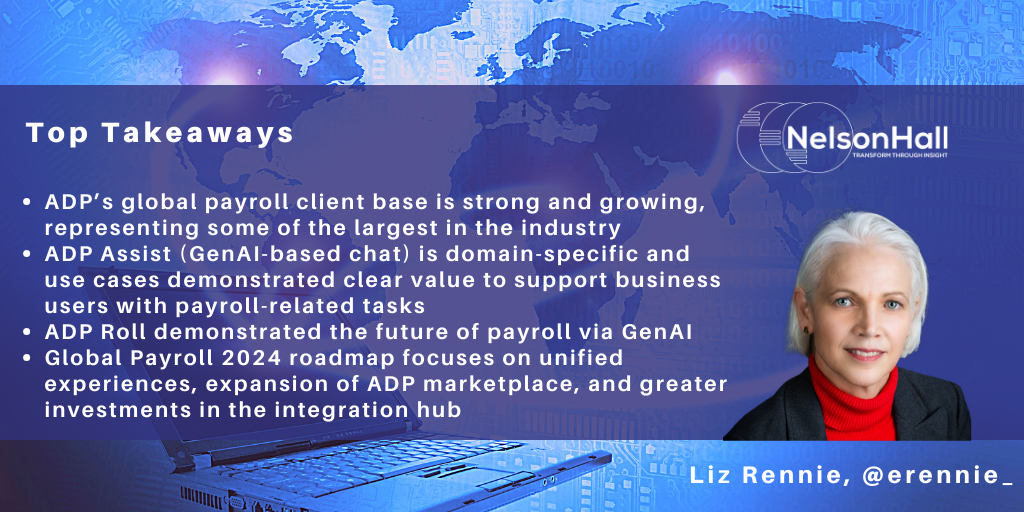
ADP's annual global payroll customer event took place in London recently, bringing together 224 decision-makers from some of the world's largest companies, representing ~20m employees. The event featured a global economic update, ADP's strategic vision, and product development updates. The event also included a "round the world" experience sharing insights into local payroll nuances and topics.
Key highlights
Highlights from the event include:
- ADP Assist (announcement here), ADP’s GenAI solution, built by domain, clearly demonstrated how productivity gains can be made; e.g. a scenario where nudges indicate higher than normal levels of overtime and prompting emails to be sent to all relevant supervisors to validate overtime levels, with options to chose a tone of language that is casual, formal or shorter and more direct
- ADP Roll (announcement here), ADP's newest payroll product with chat-only features, demonstrated how work is changing, where only 3% of its users leverage a desktop and a whopping 97% process their payroll through mobile only
- ADP is enabling a workbook configuration within the ADP Global Payroll software
- Requirements for pay/gender (DEI legislation) and pay transparency are growing, and ADP DataCloud is looking to support these needs globally
- The buyer needs of a global payroll mobile app vary, but there were examples of how it is being used across Pay and Time in multiple countries; for instance, ADP client Principal uses the app to punch in/out through the etime product as well as being able to see payslips.
CEO Maria Black took the stage to share her priorities after one year in office. This is a milestone year as ADP celebrates 75 years in the industry and has been led by only seven CEOs. She shared how she sees the organization balancing its long history of stability alongside ongoing innovation. Maria focuses on the importance of "listening" to help drive the investments of products and services. For example, she has a practice of placing an empty chair in every room to represent the client in every meeting.
The ADP client base has a huge demand for new services and high expectations of ADP. Helping navigate global payroll needs in the complex global environment takes maturity, skill and a lot of listening. ADP is taking purposeful steps in its design decisions and looks to build lasting and innovative solutions.
What to look forward to from ADP's global payroll
Expect to see the following payroll developments from ADP:
- Marketplace developments will be growing on an international scale
- Variance check improvements
- Unified practitioner experience (ADP GlobalView and Celergo)
- ADP Integration Hub will be expanded to include both in and out activities, all in one place
- GlobalView and ADP Workforce Management will be integrated in 2024
- Benchmarking and payroll efficiency are coming
- ADP Roll will be expanded to Europe in 2024; this product is one to watch being one of the first GenAi- built and chat-only payroll products on the market
- An increase in the adoption of the ADP app across its customer base. With the addition of intelligent self-service prompts within the app, it will bring an elevated payroll experience, helping catch anomalies at source and once the ADP marketplace is expanded through the app, HR and payroll functions will be able to drive greater innovation and flexibility to support their workforces.
As we move into another year where salaries are not growing at the rates seen in previous years, payroll is becoming increasingly important for organizations. My point of view is that organizations should be looking to ensure their employees receive the best payroll experiences possible and should include this in how they measure employee experiences.
]]>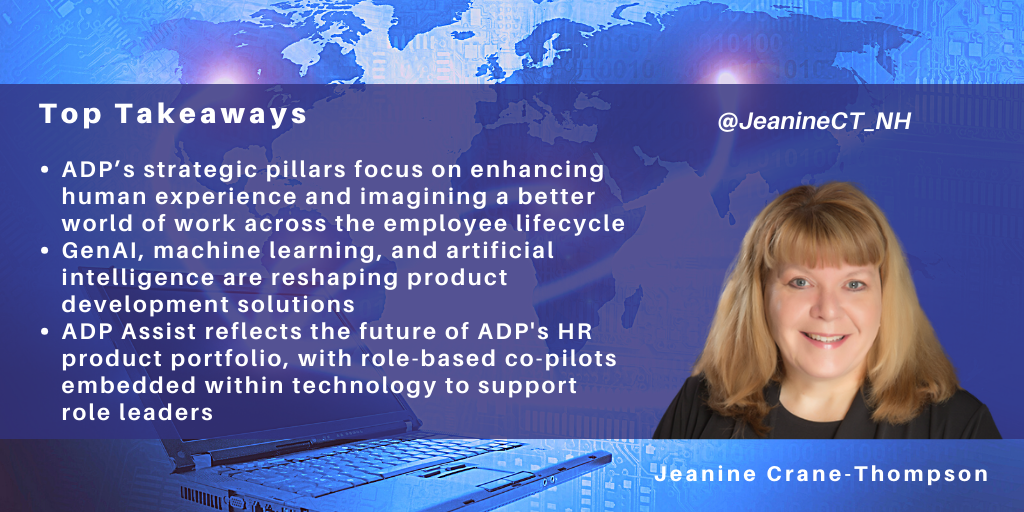
ADP recently held its 2023 Analyst Day (#ADPaday) event at its Chelsea Lab Innovation Center in New York City, where ADP leaders and clients shared strategies, product roadmaps, transformational impacts, and industry insights related to the human capital industry.
As the company nears its 75th anniversary in 2024, ADP President & CEO Maria Black shared the company's three strategic pillars to grow stronger, smarter, and with purpose:
- Greater focus on leading with best-in-class HCM technology through the innovative application of GenAI, ML, and AI
- Continuing to provide unmatched expertise and outsourcing supported by its 60k staff members
- Leveraging the organization's global scale to benefit clients.
Execution of the ADP growth strategies, particularly the integration of GenAI, is evident across its product roadmaps as the company pilots and refines its advanced solutions internally and within limited client engagements.
NextGen HCM
The company's NextGen HCM gives users access to intelligent tools, providing real-time support and insights in the flow of work. Demonstrating the results of its recent product enhancements were four ADP clients representing various industries, diverse organizational needs, and different desired outcomes. For example, the Total Rewards Director for agribusiness Scoular shared how the NextGen HCM platform enabled their business to minimize auditing time following its annual open enrollment period from three weeks to a few hours. Also, the Vice President of Human Resources from fashion retailer Steve Madden explained how the company achieved its strategic sustainability goals of reducing its carbon footprint and paperless environment by deploying ADP NextGen HCM.
ADP Assist
ADP's introduction of its GenAI-enabled intelligent assistant, ADP Assist, illustrates the company's commitment to making HCM 'more human'. With ~85% of HR work transactional, ADP product engineers imagine future HR products with role-based co-pilots (assistants) that pop up in the flow of work, supporting role leaders. ADP Assist allows users to ask the system questions, issue custom commands, generate reports, and compose and personalize emails to an employee or specific group. For example, ADP Assist can create and send tailored emails about upcoming tax legislation on retirement accounts that may impact particular employees or nudge a hiring manager about completing required tasks, such as ordering IT equipment before a new employee onboards.
ADP's analytics support critical conversations with employees by offering instant manager feedback. The application of AI and ML provides intelligent insights to managers throughout the employee lifecycle, such as identifying employees at risk of separation, new employee onboarding tasks, internal mobility opportunities, and performance reviews. Taking these insights further, ADP Assist nudges leaders to initiate discussions to understand what may be causing these trends and take empathetic steps to provide support.
ADP API Central
In June 2023, ADP acquired low-code intelligent workflow automation and data integration provider SORA. The technology supports ADP API Central, targeting the SMB market and enabling an organization to quickly create an API marketplace using pre-built APIs based on specific functional use cases.
API Central allows organizations to define and implement required changes quickly, removing roadblocks to increase agility and speed. Beyond analyzing traditional HR data, ADP also considers employee work and family data when developing an API. For example, a recently developed scheduling API scans an employee's work schedule and family data to avoid personal conflicts, such as a child's birthday. The API can intelligently schedule work with another employee, preventing a personal clash and sending a birthday cake to the employee's residence via DoorDash.
Importance of AI Transparency
As ADP continues innovating and delivering real-time HR insights through GenAI and other intelligent technologies, the company understands the importance of transparency around data security, privacy, and broader ethical considerations, such as worker displacement. To remain engaged and apprised of emerging trends and concerns, ADP sustains an active AI & Data Ethics Committee comprising industry leaders, clients, and ADP experts. ADP's continued industry leadership and supplemental tools provide a robust AI safety umbrella, supporting client understanding and acceptance as these transformational solutions gain mainstream adoption.
ADP remains focused on the human experience, the power of data analytics, and transactional efficiency. While clients continue to inquire about process automation and the appropriate application of AI across HR, ADP’s product engineers remain focused on the company’s product philosophy and reimagining the future of HCM by making it easy, smart, and human.
]]>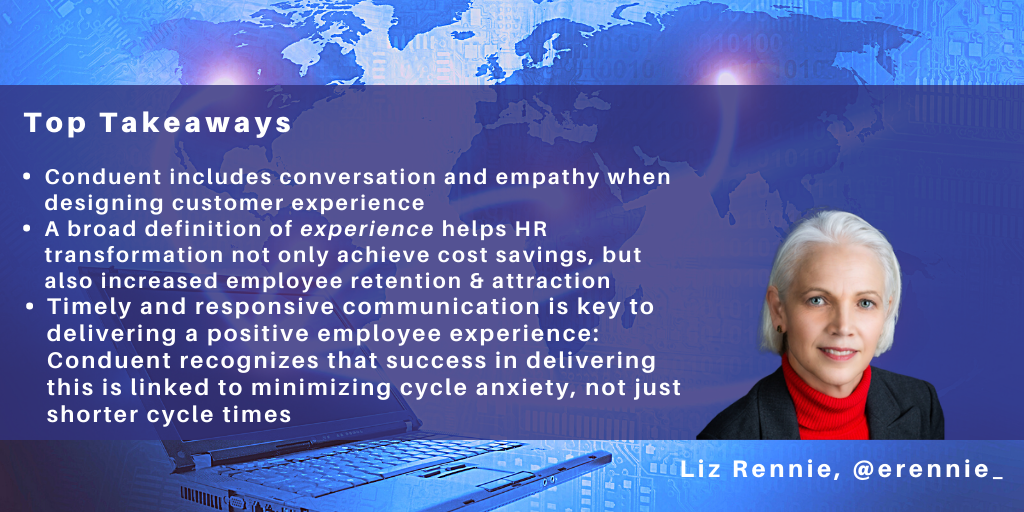
In the HCM technology and HR services market, delivering a rich employee experience is often associated with having the most user-friendly UI, seamless digital processes (zero touch) with field validations and single-point-of-entry to ensure high quality data. As discussed in NelsonHall’s recently published Cloud HR Transformation report, the next frontier of employee experience developments, where most investments are being made, is delivering greater personalization and insights to help decision making.
Indeed, the HR technology and services market has seen a trend towards incorporating more conversation and customized engagements with employees. Conduent, a CX and HR transformation service provider, noted that between 2020 and 2022, chat grew from 14% to 30% of all interactions (here).
A number of HR service vendors offer CX best practices and are leveraging CX developments to define a rich employee experience that incorporates unstructured conversations. One of the trends outlined in NelsonHall’s CX market analysis is growth in conversational interactions by better integrating sales, support, and marketing.
Conduent takes a broad look at customer experience and incorporates both conversation and empathy as part of it. The company aligns to three key characteristics of a positive customer experience:
- Competent: correctness & completeness
- Convenient: simplicity/ease of use & responsiveness
- Caring: empathy & appreciation.
HR technology and service providers have primarily focused investments on the first two of these characteristics. Regarding the third, Conduent’s recently released study (2023 State of Experience in the New World of Work) cited only 34% of HR organizations are very effective at providing consistent, empathetic omnichannel workforce experiences.
HR service providers that bring CX capability look to design high-touch human experience alongside high-touch digital experience, with appropriate handovers incorporated. How do they do this? Conduent designs its HR services offerings starting from employee journey mapping exercises. The journey experience explores scenarios where issue resolution is not just about simple vs complex or high volume vs low volume, but it also incorporates an additional dimension of high emotion vs low emotion. As part of this concept, at the core of the employee experience is employee wellbeing. Conduent’s journey mapping methodology incorporates insights, experience, engagement and monitoring to enable dynamic, personalized and proactive experiences.
In a recent interview, Conduent specialists pointed out that cycle anxiety can be as much about employee experience as the cycle time. For example, if an employee is not told when they will likely get a response or how long things take, not knowing often causes more frustrations than if they had information about timescales. Any London train commuter will have experienced this feeling on the occasions when customer information is not updated with next train times.
A broad employee experience framework that incorporates employee journey mapping with human interventions offers the ability to deliver many benefits and considers overall communication, not just timely and accurate transactions.
Conduent recently delivered HR transformation and outsourcing services to a global pharmaceutical organization. It is not only on track to achieve the expected savings of up to 35%, but it is also increasing the company attraction, employee support, experiences, engagement, and retention across 110k employees distributed across ~80 countries. It is achieving cost efficiency improvements by decreasing the number of cases via Knowledge Management and additional automation. It reduces manual administrative work through RPA applied to compliance risk and minimizing error rates. And it is also improving quality, SLAs, and the cycle time.
With the advent of generative AI to support conversations, NelsonHall expects HR service and technology vendors to further develop conversational capability, exploring new ways of engaging with employees, managers and HR operational teams to ultimately drive greater attraction, engagement and retention (employer brand loyalty) whilst managing operational costs. Finally, the importance of a rich data set to support conversational solutions that aid decision-making should not be underestimated.
]]>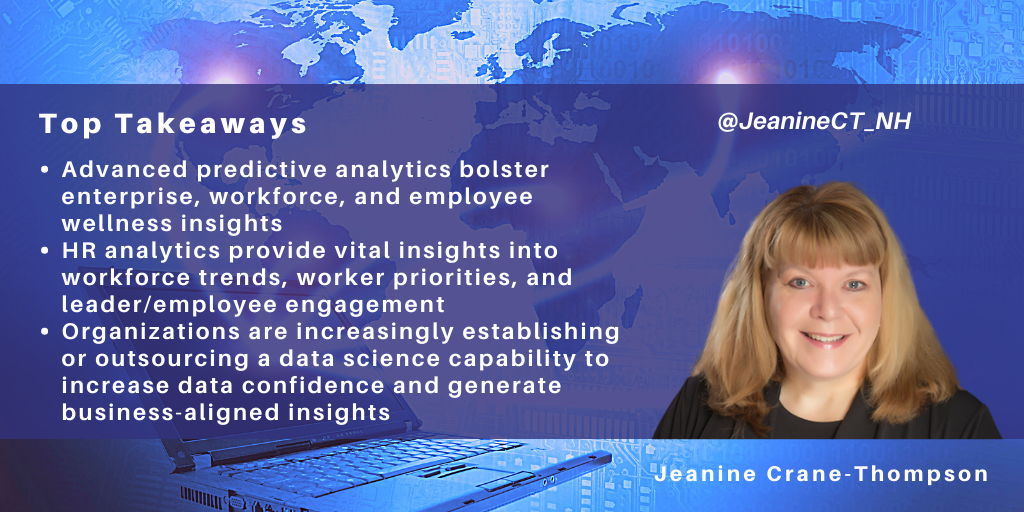
The week of March 13, the 2023 ADP Meeting of the Minds (MOTM) Conference saw more than 3,000 participants descend upon downtown Atlanta. ADP leaders, guest speakers, and clients shared data and insights on industry trends, economic forecasts, and the overall health and direction of the human capital industry.
At a high level, six economic trends are reshaping the global labor market, including slowing growth, persistent inflation, rising wages and costs, a smaller global workforce, a digital economy, and evolving workforce trends. At a more detailed level, a primary theme of this year's conference was HR analytics. Observations included:
- Data science continues developing and presenting practical business use cases and solutions supporting all phases of the employee lifecycle, from recruitment and the anticipated cultural alignment of a candidate to employee skilling/reskilling and internal mobility opportunities
- ADP clients who leverage data throughout the HR lifecycle have realized a 24-day reduction in time to hire and ~30% average decrease in voluntary turnover costs
- 23% of the respondents to ADP's 'People Analytics Reimagine' webinar series stated that their organization's biggest challenge in driving value from people analytics is knowing where to focus.
The pandemic and the new world of work catalyzed technology transformation and the use of people analytics. Employees and employers alike experienced the strain of a remote working environment. In response, employees reassessed their work-life balance and personal priorities, triggering a series of HR trends and buzz phrases, including the great resignation, quiet quitting, and the sansdemic. This perfect storm of talent obstacles left organizations scrambling to attract new resources and retain existing staff.
During the conference, ADP presented various ways HR organizations can deploy analytics to combat these challenges by understanding employee needs, wants, and specific qualities. 53% of the respondents to ADP's 'People Analytics Reimagine' webinar series leverage analytics to benchmark HR metrics; however, only 38% stated that their organization uses HR analytics to improve employee engagement or manage retention risks. ADP found that those organizations using data to maximize employee retention have experienced ~30% average decrease in voluntary turnover costs.
HR analytics can identify high performers, particular roles at the most significant risk of resigning, and where pay inequities exist. Taking these insights further, leaders can initiate discussions to understand what may be causing these trends and take empathetic steps to provide support. Analytics may enable critical conversations with an employee by giving instant feedback.
For example, the ADP Virtual Assistant (AVA) delivers instant payroll processing interactions with employees. AVA provides real-time visibility into gross-to-net, benefits, and deductions data. Additionally, AVA provides intelligent self-service by anticipating, solving, and reducing employee HR cases before they happen, such as where PTO balance anomalies exist compared to historical PTO usage for an employee.
The new world of work has yielded a new breed of employees, requiring increased employer/employee communication and transparency, expanded benefits offerings, and flexible work schedules, enabling an optimal work-life balance. Data science continues evolving and providing practical business use cases for all segments of an enterprise, including HR insights supporting all phases of the employee lifecycle. To succeed, today's leaders require the confidence and understanding of people analytics and workers' priorities to enable their workforce to thrive.
]]>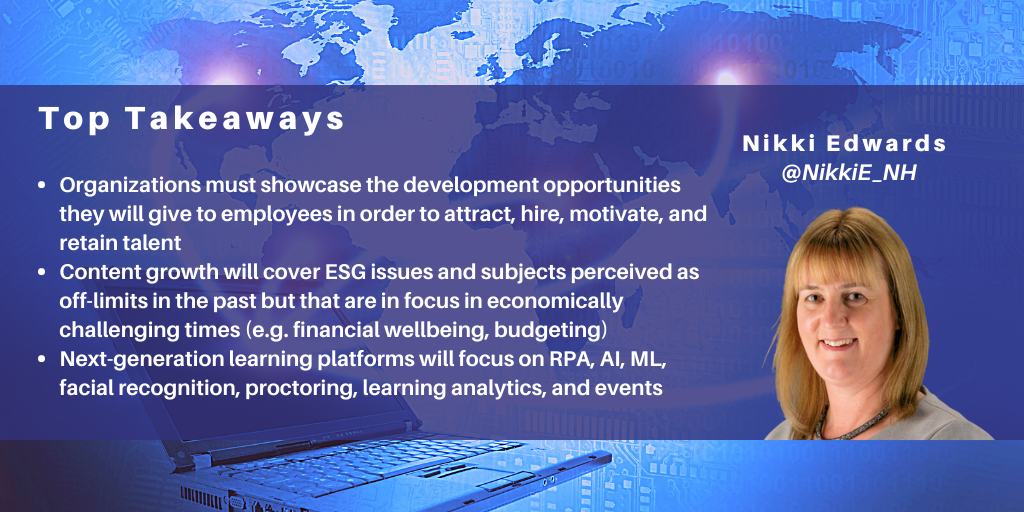
In 2022, timely digital learning became the accepted norm, along with personalized learning using delivery methods based on the latest advances in learning tech and services.
Before the pandemic, learning was a target for wholesale budget cuts during a time of economic uncertainty. With ongoing talent and skills shortages, 2023 will likely see some organizations de-prioritize learning, while others will prioritize mission-critical learning to offset talent acquisition (TA) challenges, where building skills is a viable alternative to hiring skills.
Hot topics in the learning space for 2023 include:
Personalized learning journeys
An excellent learner experience, and broader employee experience, indicates a nurturing company culture where people feel valued and remain engaged. Organizations must showcase the development opportunities they will give to employees in order to attract, hire, motivate, and retain them. Learning functions need to understand their employees’ existing skillsets, identify those they need for future business success, and identify the skills gaps to create fit-for-purpose personalized learning journeys.
Skills gap analysis is not new, but in 2023 it is disappointing that so many organizations have never undertaken this fundamental task; and this is highly indicative of why learning often fails. Many platforms now have skills ontologies built in, with RPA/AI to help drive tailored learning according to role requirements and skills interests. Platforms also support various learning modalities (video, animation, quizzes, cohorts, etc.) to engage learners, whatever their preferred learning styles, experience level, and formats (mobile, bite-sized), to provide anytime/anywhere/any device experiences. Ultimately, the aim is to motivate learners to curate their own tailored learning content, giving them the drive to own their learning/career plan while promoting a strategic and career-long learning culture within organizations.
Engaging and relevant learning content
There will be a burgeoning variety of learning content in 2023, building upon what evolved over 2020-2022. Organizations can choose whether to curate third-party content or create bespoke content, either outsourcing the task or self-creating it using authoring tools. Content around digital skills, the future of work skills, financial and mental well-being, resilience, and DEIB will continue to be in demand.
2023 will see content growth covering ESG issues and subjects that may have been perceived as off-limits in the past but come to public attention in economically challenging times (financial well-being/budgeting, healthy eating on a budget, and domestic issues, for example). Learning content is becoming life-centered, not purely work-centric, reflecting the nurturing ‘sense-of-belonging’ work cultures that organizations aspire to provide.
Learning tech/tools
Building on 2022 progress, next-generation learning platforms will emerge in 2023, providing hyper-personalized learning experiences: LMS, LMXP, LXP, and specialty platforms. Where vendors have acquired other learning tech companies, those new platforms will encompass the best features and functionality. RPA, AI, ML, facial recognition, proctoring, learning analytics, and events are just some of the focus areas.
Appification is growing, notably in bite-sized content authoring and video tech, to expand the capacity to use tech anywhere and anytime within busy schedules. While economic uncertainty looms, 2023 will likely see organizations delay large-scale learning tech purchases to minimize spending, choosing to make do with existing platforms and augmenting parts of their ecosystems with appropriate tools for specific purposes.
Enterprises may consolidate learning tech, if they have various platforms in play, to streamline learning. The appetite for data/analytics on learners will grow as organizations recognize the benefits such insights have brought to other areas of their business such as recruitment. Insights will expand beyond learners’ use of learning platforms to focus more on learner behaviors, the predictive assignment of content, and capturing the volume of content views and reactions by learners. This will enable organizations to optimize their learning content and technology investments.
Changing learning roles
Learning and learning technology advancements over the past decade have influenced and transformed L&D roles. Moving into 2023, L&D engagement will focus on addressing critical organizational issues such as developing and sustaining required skill sets. Initial job and task analysis, curriculum design, and functionally-focused career-long learning journey development projects will be necessary to ensure learning remains aligned with organizational strategies. As the application and use of HR and learning data analytics become more prevalent, demand for data science jobs and skill sets will increase.
For full coverage of the learning market, find out more by following the link below; and to subscribe, contact Guy Saunders.
Learning Services: https://research.nelson-hall.com/sourcing-expertise/hr-services/learning-bps/
]]>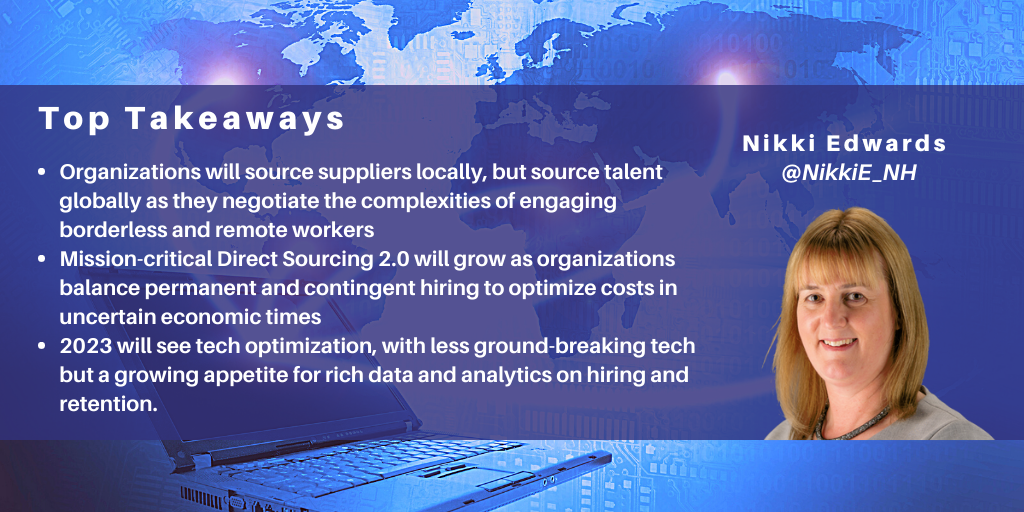
The last three years has been a period of rapid transformation for Talent Acquisition (TA), culminating in a new era of work. And in 2023, organizations face challenges such as a shrinking global workforce, skills shortages, and new workforce/workplace expectations. Alongside, broader business survival challenges (navigating an economic recession, availability of resources/supplies, etc.) and pockets of COVID prevail. Organizations will face conflicting forces in addressing these challenges; for example, local versus global, headcount contraction versus expansion, contingent versus permanent hiring, new platforms versus existing tech optimization.
Several of the hot TA topics for 2023 include:
Borderless and remote workers
While many organizations are prioritizing the use of localized (onshore) business suppliers, in contrast, their TA activities will become more globalized. 2022 exacerbated companies’ over-reliance on a handful of lower-cost international suppliers as accessibility to goods was severely curtailed for various reasons, showcasing the risks of putting all their supplier eggs in one basket. In 2023, organizations will look at local alternatives: partly to de-risk themselves while thinking about broader ESG issues such as reducing their carbon footprint. Businesses will cast their nets far and wide to find the talent they need with the right skills, building on the pandemic-induced trend of using remote workers. However, companies will have to weigh new pros and cons associated with borderless/remote workers.
A broader audience reach is a plus factor, but with more jurisdictions to cover, the risks around non-compliance increase. Understanding how to pay workers and how much to pay them has changed. For specific skillsets, talent location is now irrelevant (as the shortage is so severe, there is no low-cost alternative location, but rather a broadly similar pay expectation irrespective of where the talent is based). Part of expanding the borderless and remote workforce is well-thought-out use of diverse talent pools, communities, and gig platforms: a trend associated with Direct Sourcing 2.0 (next-generation direct sourcing).
Contingent versus permanent hiring: pendulum swing
The economic climate is already wreaking havoc in the tech sector, with well-known companies shedding workers. Still, many of the layoffs are likely the effect of inadequate right-sizing in the past (because of a lack of awareness of whether fit-for-purpose skillsets existed across businesses) or over-optimistic post-pandemic hiring (short-term reactive hiring and less strategic workforce planning).
While further recession-induced headcount reductions will likely be commonplace in 2023 across all sectors, organizations will also prioritize mission-critical headcount hiring (such as digital or niche skills, both professional and blue-collar) due to continued global economic uncertainty. However, with the global shortage of digital skills, those recently laid-off workers are seeing alternative job offers. In times of economic recession, organizations tend to increase their proportion of contingent hiring and decrease permanent hires, to reduce their risk of long-term headcount commitment and give them the flexibility to end contracts. While contingent roles are currently favored, candidates willing to embrace either role type will fare well in terms of future opportunities.
Showcasing employer/contractor value propositions
Organizations will work harder to promote their company cultures to be future-of-work fit for their audiences across all talent channels. The new priority is promoting broader environmental, social, and corporate governance (ESG) issues/credentials, in addition to diversity, equity, inclusion, and belonging (DEIB), work flexibility, financial and mental well-being, and career longevity. With tighter budgets, savvy companies will work to redeploy contract resources onto additional projects to maximize their recently-gained knowledge of the organizations where they are working rather than restart the hiring process.
Skilling 2.0 to offer career journeys
All candidates will want to understand the potential for upskilling and reskilling while working for an organization, whether for a fixed or indefinite period. The successful attraction of contingent workers will require organizations to offer exciting projects and the opportunity for upward mobility within the organization, with support for upskilling or reskilling in adjacent skills. Contingent workers who enjoy the company culture where they work will be more inclined to stay longer if the right opportunities present themselves. A poor economic situation tends to dissuade temporary workers from job-hopping.
Attracting the next generation of permanent talent, or filling existing vacancies, will require organizations to showcase potential career journeys to candidates. Job hunters will want to join companies that value them as individuals and will give them opportunities to progress their careers at their pace, without being held back.
Data, analytics, and intelligence
To attract and hire the best candidates, organizations must continue to showcase slick and speedy hiring processes, combining a mix of intelligent tech and human interaction. Rather than seeing any ground-breaking technologies emerging, 2023 will be a year of tech optimization for many organizations. Without the budget for embracing new company-wide platforms, existing stacks will be optimized by consolidating or augmenting them with tools to add much-needed functionality. Areas of interest in tech augmentation will focus on adding process efficiencies, tools measuring candidate surveys/sentiment analysis, horizon scanning (likelihood of jobs being replaced or augmented by tech), anonymized talent communities, and on-demand payments for contingent workers.
The appetite for more data and predictive/prescriptive analytics will grow. Notably, organizations will seek to identify bottlenecks in their hiring processes and aim to overcome them. Also, there will be more interest in ascertaining where and why candidates drop out of the talent attraction and hiring processes.
Additionally, HR data and analytics will expand beyond legacy usage (e.g., number of hires/separations) to strategically support all facets of an organization throughout the HR lifecycle. Examples of the enhanced use of these rich data include assessing a candidate’s cultural fit during the recruitment process, identifying employees with a high probability of separation, determining if the right types and volume of skillsets exist within an organization to meet projected product/service levels, and assessing pay and benefits at the individual employee level.
For full coverage of all recruitment markets, find out more about our specialist research programs by following the links below; and to subscribe, contact Guy Saunders.
- Contingent Workforce Services and Managed Services: https://research.nelson-hall.com/sourcing-expertise/hr-outsourcing/msp-cws/
- Global EOR: https://research.nelson-hall.com/sourcing-expertise/hr-technology-services/global-eor/
- RPO: https://research.nelson-hall.com/sourcing-expertise/hr-services/rpo-total-talent-acquisition/
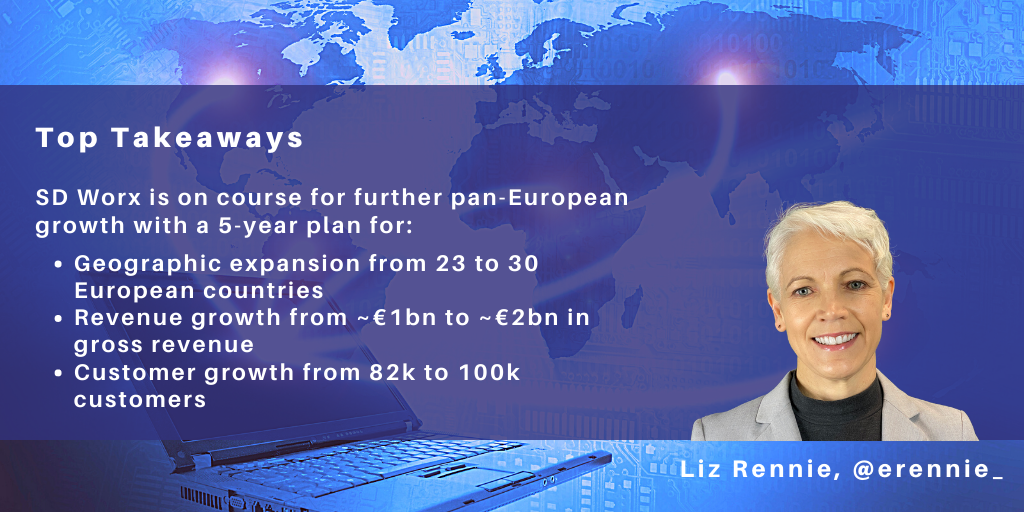
Last month, NelsonHall participated in the SD Worx Analyst Day, which included an update on key milestones since Kobe Verdonck took the reins as CEO in September 2019. The last three years have seen SD Worx supercharge its European growth and intensify its focus through achieving:
- Geographic expansion from 10 to 23 countries in Europe, where it utilizes its own IP in 17 of these
- Revenue growth from €768m to ~€1bn in gross revenue
- Customer growth from 70k to ~82k customers.
SD Worx has shared its vision for the next 5 years, keeping its course for pan-European growth through further targeting:
- Geographic expansion from 23 to 30 countries in Europe
- Revenue growth from ~€1bn to ~€2bn in gross revenue
- Customer growth from 82k to 100k customers.
To achieve this growth, SD Worx is looking to focus on the following key areas of differentiation:
- Integrated end-to-end HR solutions using the SD Worx, Gro, Flo or Pro service models
- SD Worx payroll software and subject matter expertise as the core method of delivery rather than using in-country partners
- Bringing local expertise, whereby in-country presence is core to its delivery model
- Consistent user experience, as all employees will have the same experience irrelevant of underlying software
- Aiming for a top 3 position in countries with a population >10m
- Being an employer of reference to attract talent.
SD Worx will look to support customers of all sizes and in all industries, locally and internationally.
However, as SD Worx actively drives payroll consolidation across the European HR and payroll market, one of its main challenges will be to establish the SD Worx brand and operational frameworks in its new markets.
Its aim of driving one experience across all platforms is ambitious, but with the client scale it is looking to achieve and through ongoing investments and acquisitions to support scale, this vision has strong promise. We can expect further acquisitions over the next five years to support its growth targets, in particular in Eastern and Southern Europe. This builds on recent acquisitions supporting the company’s expansion, including Integrho (Spain), Intelligo (Ireland), and HRPRO (The Balkans).
]]>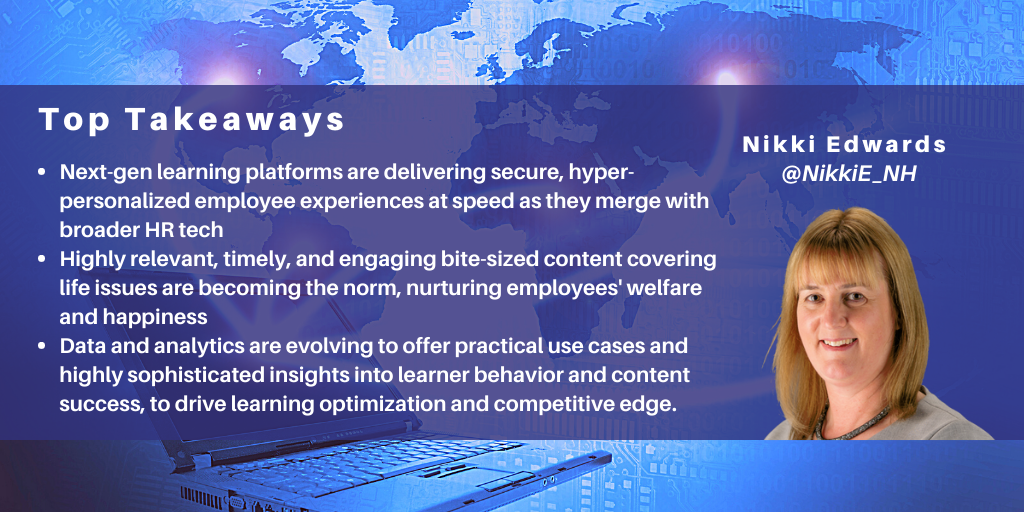
The 2022 Learning Technologies Autumn Forum (at the London ExCel, October 13) reflected the market changes and global events that have been driving the learning transformation agenda since early 2020. Remote and hybrid working demand and deepening talent and skills shortages have seen learning become a C-suite priority: organizations realize that if they cannot buy or borrow talent (via permanent or temporary hiring), they must build it through learning.
Job seekers, candidates, contractors, and employees want a fast, consumerized experience in both their private and work lives. Furthermore, if a prospective or current employer fails to provide ongoing development opportunities, employees will likely look elsewhere. Add in the current economic pressures and impact on people's well-being at work, and this makes for a highly challenging 2023.
Learning tech vendors and tech-savvy CLOs have been driving the digital learning agenda for years, and the current market challenges mean their business strategies are cut broader and deeper than before. Some core themes remain on the agenda, several of which were showcased by vendors attending the forum: next-gen platforms, upskilling/career pathing, optimized bite-sized learning, and data/analytics.
Next-gen platforms
Several vendors have made acquisitions to create next-generation platforms that will be fit-for-purpose in 2023+, taking the best features and functionality of their acquired tech. Cornerstone's 2022 acquisition of EdCast (along with previous investments) will see the best aspects of all the platforms in its portfolio come together in 2023; while LTG's platform and services portfolio, assembled over the past decade from multiple acquisitions, will continue to integrate. Both these vendors are driving enhanced learner/employee experiences.
Huler's HulerHub personalized employee experience platform layer links to an organization's tools, documents, and systems. HulerHub provides a straightforward Netflix-style interface that is quick and easy to update without coding or design expertise. The platform is carefully designed to avoid common pitfalls. For example, pre-boarding maximizes communication, while onboarding aims to prevent digital overload. Similarly, maintaining a good work/life balance is vital while giving the freedom for growth and development.
Sponge's Spark LMS uses facial recognition technology, which is invaluable for attendance monitoring in environments where fraudulent attendance is commonplace. The technology also highlights learners' boredom, confusion, or delight when accessing learning content.
Upskilling/career pathing
Several vendors, such as Cornerstone and LTG, are developing skills ontologies. These enable learners to close their skills gap through AI-driven learning opportunities and map out career paths to facilitate talent mobility. Learning Pool has just acquired People-Analytix AG, an AI-based employee skills management platform. The platform includes a proprietary multilingual skills ontology with over 20,000 skills, enabling companies to identify organizational skills gaps, uncover workforce trends, and match employees to jobs, projects, and learning. The plan is to roll out an enhanced offering now that the two companies have come together.
With its established Saffbot learning chatbot (that supports learners beyond formal training as they interact with content in real-time), Saffron Interactive launched its new AI-enabled skills coach Aida at the event.
Optimized bite-sized learning content
Learning is increasingly geared around busy lives, with bite-sized or microlearning opportunities accelerating. Several learning tech vendors operating in the education space (e.g. D2L, Frog), with deep insights into the pedagogy of learning, are emerging in the corporate arena to maximize learners' learning capacity in short bursts.
More vendors are developing their platforms with authoring tools to encourage self-created content. This option works well where organizations have company-specific information to share with their workforces that cannot be curated from a third-party provider. For example, Rise Up has fully integrated its proprietary LMS with MS Teams, enabling learning to take place in the flow of work.
However, not all organizations want to create content, preferring to use third-party providers who curate or create content for their clients. Content providers are broadening their content portfolios, making highly-relevant, timely, and engaging content. For example, Thrive provides content via its Content Club for any LMS. It has recently added content around themes such as World Mental Health Day, the cost-of-living crisis, financial well-being, and the menopause. Its catalog has a section devoted to hot topics. HowNow handpicks specialist content for its HowNowPlus offering and partners with several curated content providers.
Numerous learning techs focus on a specific learning modality (e.g. video, animation, VR/XR) geared for consumerized learning, and it was evident that appified video platforms for employee-generated content are increasing. For example, StoryTagger provides an easy-to-use app with templates for uploading work-related content in bite-size chunks, enabling learners to choose a top-level overview or dive into the details. iAM Learning uses animation for off-the-shelf and bespoke content, using story-telling to engage learners and help them retain knowledge. ARuVR (formerly VRtuoso) offers an XR Authoring System, XR Real-Time Sessions, and XR Interactive Live Streaming under one enterprise-grade platform. In-house L&D teams can add their own XR content without needing XR expertise.
Data/analytics
Sponge claims that 90% of executives say that developing employees is very important to their businesses, yet only 12% of CFOs are confident that L&D is spending the right amount of money in the right places. Evolving data maturity from being data-aware to data-driven, and building actionable insights from learning data, helps organizations to invest where they need and drive optimal business outcomes and ROI. All vendors provide learning data and reporting/analytics. Companies need to recognize the value of the resultant insights and embrace them.
Some of Sponge's standout features include detailed analytics on learners' quiz/exam behaviors: for example, seeing how much time they took to read, analyze, and answer a question or which question gave them the most difficulty. Sponge can track learner engagement by highlighting which elements or modules learners breezed through and where they struggled or lost focus.
Summary
As 2023 approaches, and with so many external challenges in play, organizations must put their workforce first and give people opportunities to grow and develop throughout their career. With the support of learning tech vendors, companies can quickly and positively impact their learners, driving workforce satisfaction, engagement, and loyalty.
]]>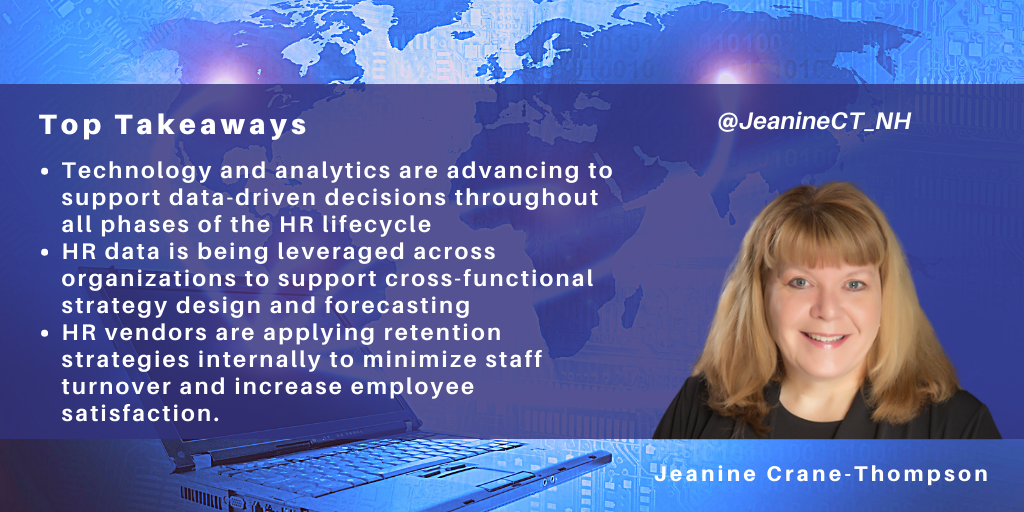
Earlier this month, the 2022 HR Technology Conference saw more than 400 vendors and 5,000 participants descend upon the Las Vegas Mandalay Bay Hotel & Conference Center. Attendees presented industry trends, learned from colleagues, viewed demos of the latest technologies, and met face-to-face in what felt like a pre-2020 setting.
Several key observations from this year's conference include:
- The considerable number of start-up companies and niche players with highly targeted and specialized service offerings, such as industry- or skill-specific recruitment services
- The impressive volume of equity funding investments across the HR technology market (e.g., during the conference, global employer of record solution provider Atlas, in partnership with Sixth Street Growth, announced their $200m strategic equity investment)
- The increased organizational focus on employee retention strategies in response to the "great resignation" and, more recently, the impact associated with "quiet quitting".
The pandemic and the new world of work have been catalysts to the transformational service and technology shift experienced within the HR industry in the past 24 months. A common theme in these changes has been the expanded use of technology and analytics throughout all phases of the HR lifecycle, from candidate selection and hiring efficiency to employee retention.
Technology plays a critical and evolving role in recruiting and digital onboarding in this fast-growing market. With its Flex HR platform, Paychex onboarded ~2m hires in one year, with 80% of the new employee onboarding completed on a mobile device. NXTThing RPO and JazzHR reduced the cycle time required to hire and onboard new talent by 50%. In addition to helping its clients improve employee retention, NXTThing RPO is walking the talk with 0% turnover of its recruiters. The company attributes this accomplishment to the treatment of its employees; e.g., healthcare is 100% paid for by the employer, employees receive unlimited paid time off (PTO), a performance-based bonus plan for all employees, and a flat management structure.
After briefings with over three dozen vendors at the conference, it's clear that the application of data science and artificial intelligence to provide predictive HR insights has evolved into reality. Managed payroll provider, Paychex, conducts ongoing salary benchmarking and frequent performance review sessions to increase employee retention. Employee retention risk factors, including salary inequities and high-demand job roles, are available via a talent scorecard, enabling managers to approve pay increases outside the defined performance review cycle.
Compensation management software company, Decusoft, developed a people analytics module presenting real-time pay-equity and diversity data. The system also enables managers to run data models providing greater budget certainty and the ability to identify and resolve retention trends. From an employee perspective, Decusoft generates total compensation and rewards statements presenting a holistic view of their pay, benefits, bonuses, equity, healthcare, paid leave, and retirement contributions. These data are accessible in real-time to keep employees apprised of their compensation history.
HR data analysis and usage is expanding to provide valuable insights beyond the HR department. Predictive analytics can support the identification of high-potential employees at the highest risk of resignation and anticipated job vacancies based on multi-year retirement horizons or projected production volumes.
IBM's recruitment process outsourcing group assesses and optimizes the employee onboarding and initial learning experience to support talent retention. According to the Employ-Inc Q3 2022 quarterly report, 63% of the recruiters surveyed experienced new hires leaving in the first 90 days after starting a new job, and 52% of those respondents believe it was because they were the wrong candidate for the position. Poor initial training experiences may also lead to candidates quitting or resigning before their first job. While the new employee experience is critical to successful onboarding and engagement, companies must also focus on providing opportunities available to existing employees to manage voluntary attrition. To address this vital need, the IBM team also delivers internal mobility services by analyzing talent and skills data to evaluate employee profiles and support hiring managers to promote from within the organization.
Increased employer/employee communication and transparency, expanded benefits offerings, and flexible work schedules and locations are characteristics of the new world of work. The global talent shortage has exacerbated an already challenging hiring environment for employers. To succeed, today's leaders require a focus on employee experience throughout the enterprise, refreshed hiring policies and practices, and modern systems enabled by data to attract and retain their workforce.
]]>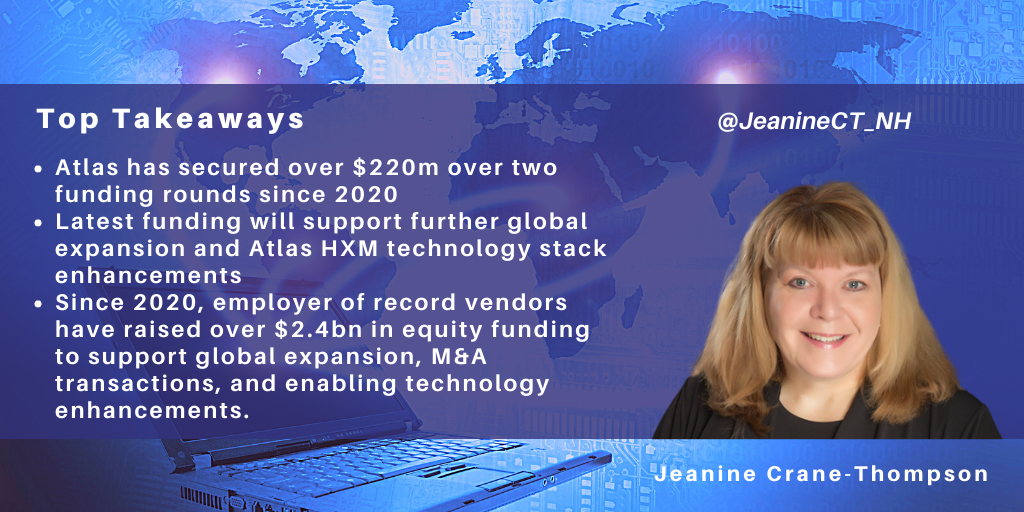
On September 15, Atlas secured a strategic equity investment of up to $200m in partnership with Sixth Street Growth.
Atlas specializes in direct employer of record (EOR) solutions and enabling technology, contractor pay, consulting services, HR service delivery, and global mobility & visa offerings. The company is focused on supporting clients’ international expansion strategies in compliance with employment rules and regulations through its entities in ~165 countries. It rebranded from Elements Global Services to Atlas in June 2022, and its rebranding efforts reflect the flexibility, agility, and enabling technology required to meet client and worker UX expectations, talent needs, and data requirements intensified by recent global events.
As a result of this investment, Atlas will be able to enhance its technology platform to support localization and provide additional self-service functionality and automation features. The launch of the Atlas Human Experience Management (HXM) platform was coordinated with the organization’s rebranding efforts in June.
The funding also supports broader in-region customer support, including hiring additional native language staff to deliver in-country and in-time zone support to its clients and worksite employees. Atlas continues to hire in-country staff throughout all levels of its organization, including senior leadership. The expanded regional presence balances direct client and worksite employee support and technology.
The company maintains an aggressive inorganic growth strategy to broaden near-term service portfolio offerings, technology advances, and the addition of new in-country legal entities.
NelsonHall views this investment as a strategic enabler to support Atlas’ organic and inorganic growth strategies. It anticipates the expansion of Atlas’ portfolio through partnerships or the acquisition of companies delivering complementary services and technologies. These relationships will enable cross-selling opportunities and the development of targeted business development strategies. The company continues to expand its services and technology offerings to support all phases of the HR lifecycle, attracting prospective clients seeking a single vendor to manage comprehensive outsourcing or targeted out-tasking of its HR services.
Several other EOR vendors have secured equity funding to extend their capabilities, including:
- Omnipresent raised ~$138m over three funding rounds to support legal entity creation in ~80 markets and the development of its OmniPlatform technology stack
- Remote raised ~$496m over four funding rounds to support legal entity creation in ~65 markets and enrich its Remote technology stack, including the release of its contractor management, relocation, and API integration services and modules
- Velocity Global raised ~$500m to support multiple company acquisitions, including iWorkGlobal and Shield GEO, broaden its services portfolio, and expand its Global Work Platform functionality to support contractor payments.
The formalization of ‘work from anywhere’ policies and the continued impact of ‘the great resignation’ have contributed to a high level of global EOR market activity and client interest. To support global and service portfolio expansion, M&A transactions, and enabling technology enhancements, NelsonHall expects more strategic investment funding across the global EOR market in the year ahead.
]]>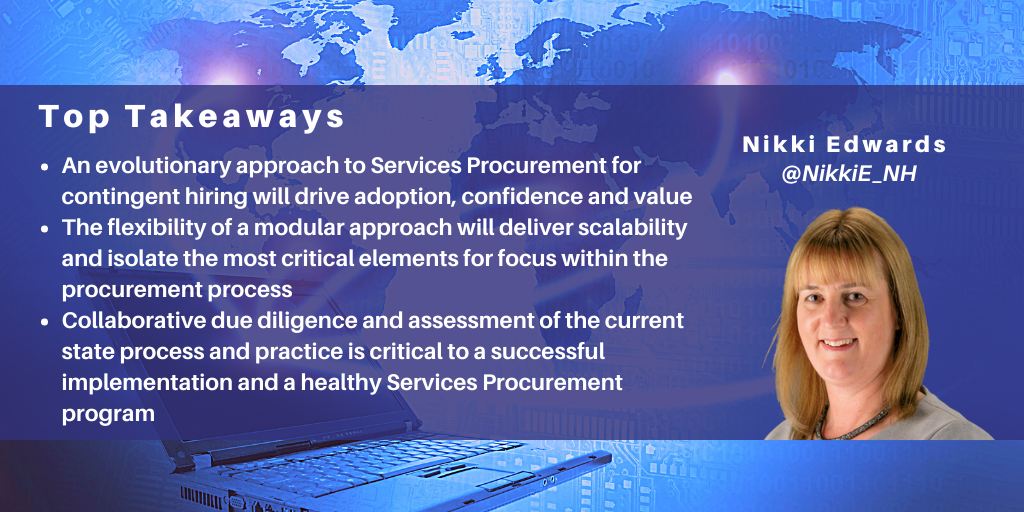
Pontoon's recently reimagined Services Procurement contingent hiring solution enables a simplified, client-centric journey, with best practice at its core and underpinned by industry-leading technology.
In 2021, Pontoon conducted a thorough evaluation of its existing offering, other solutions in the market, and what current and future clients were looking for from Services Procurement. The result is a solution designed around three primary pillars: manage the process, facilitate the buy, and outsource the category. The approach is modular, offering the flexibility needed for a broad mix of clients, with each pillar increasing in level of complexity and value. Pontoon’s client engagements range from small and mid-sized to billion-dollar global programs.
Whereas a traditional MSP is a holistic program needing organizations to embrace an all-encompassing change in their contingent hiring processes, Services Procurement and Statement of Work (SOW) can be perceived as an evolutionary service offered as a part of an MSP.
Build a solid foundation on which to grow
The aim is to start with the foundational elements of Services Procurement rather than an immediate introduction of a high-level procurement service. By starting at a managed level, procurement professionals can focus on their core business priorities, day-to-day operations can continue uninterrupted, and adoption rates are driven up.
Pontoon believes that its approach would ensure success and establish a solid foundation to build steady, manageable, and successful change, irrespective of a company’s readiness and Services Procurement ambitions.
It has deployed its new approach with a U.S.-based healthcare client who started their Services Procurement journey on the first pillar: manage the process. When Pontoon first met the client to discuss MSP services leveraging the client’s existing ATS and VMS platforms, they stated their ambitions to embrace SOW services quickly. However, cognizant of the risks of moving too fast, Pontoon followed its tried-and-trusted approach in first establishing itself as the client’s MSP vendor. The focus was on delivering results (process efficiency, visibility, compliance, and cost-savings) and building trust (achieving a consistently high stakeholder satisfaction score) before helping them navigate Services Procurement/SOW. In the initial phase, Pontoon took on some of the tasks and activities in the ATS to ensure the contingent workforce records were compliant across both platforms. Within six months, Pontoon leveraged data and analytics to identify action items to optimize the existing supplier pool, ensuring selected suppliers were best suited to the client’s needs.
As the client’s MSP vendor, Pontoon was aware that internal stakeholders had brought in SOW resources (though SOW was out of program scope), and it was therefore likely there would be a degree of worker misclassification. Pontoon suggested it run a project with the client to analyze those resources, and subsequently identified 20% as incorrectly classified. Pontoon was comprehensive and thorough during the resulting discovery process. The rigor applied from understanding how an organization’s contingent labor can be hired, hidden, and allocated in different ways enabled Pontoon and the client to gain full visibility of all SOW resources, ensuring that both parties could collectively isolate the actual SOW versus contingent spend.
Invest the time and enjoy the discovery…
Pontoon emphasizes that a successful Services Procurement/SOW program requires a methodical approach, bringing net new contracts under the program scope in the first instance and avoiding mid-contract changes. The client, with 105 SOWs in flight and 600 workers associated with them, would not be able to cope with the disruption of immediately changing all contractual terms. Similarly, the client’s existing VMS technology would require significant work to update this change in volume.
Pontoon walked the client through the Services Procurement/SOW Discovery, Data, and Recommendation steps, determining how it would implement Services Procurement/SOW and walking through every workflow step, establishing who would take responsibility for specific actions.
Pontoon identified that cost savings would be ~12% (which, projected forward, equated to $4m per year), essentially driven by the solution design team through rate card and invoicing compliance. The team determined what the client wanted from a rate card strategy perspective, backed it up with market data, and ensured it aligned the right strategy to the client’s brand perception.
Typically, these programs are supplier-funded. However, in this case, the client is financing the program, encouraging more suppliers to get on board, notably big consultancy firms. In such circumstances, this can be a harder sell to a leadership team. However, the business case created for the procurement team to present to their leaders showed the added value that Services Procurement/SOW could bring and how they would outweigh the cost of the client-funded expenses. In preparation for Services Procurement/ SOW, the tech stack for SOW was streamlined and aligned to the broader MSP – comprising the VMS and a few additional tools for onboarding and analytics.
…and the recommendations will reap rewards
The business case evolved into a complete policy change, with non-compliance post go-live resulting in withholding budget sign-off. By coincidence, the new policy gained executive approval on the third anniversary of the initial MSP launch.
Pontoon would like this client-funded model to be repeated to prospects, to drive better adoption rates and to better support client business objectives.
Pontoon is now working on the second pillar of the program's evolution. Using its accumulated data, it anticipates supporting the client with enhanced vendor selection and assessing bids so that the client can take on more strategic elements internally. It is clear that results have been delivered by taking a systematic, manageable approach, paving the way for further success.
]]>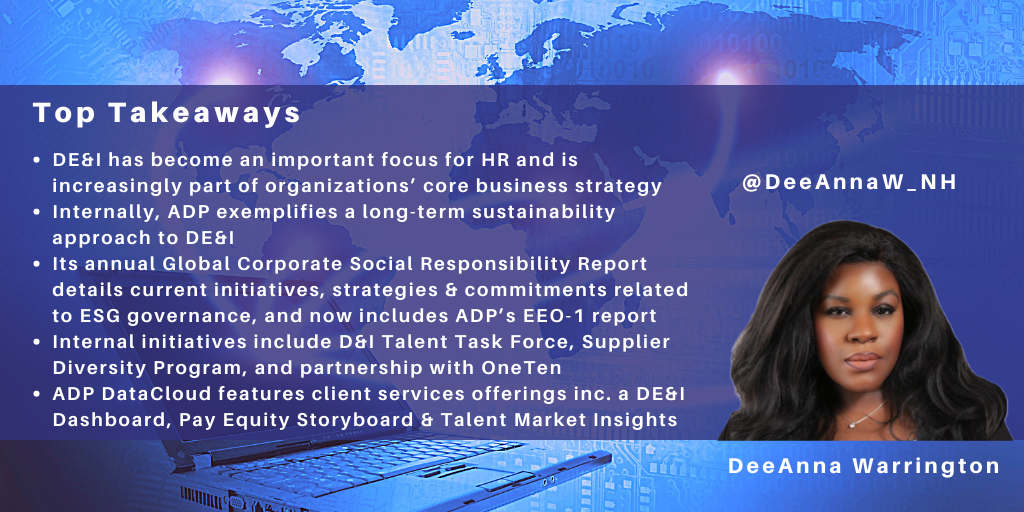
Diversity, Equity & Inclusion (DE&I) has become an important focus for HR in recent years and is increasingly part of organizations’ core business strategy. This blog takes an in-depth look at ADP’s current DE&I strategies, both internally and as relates to its client service and offerings.
ADP’s Corporate Social Responsibility
ADP currently has ~60K employees and supports ~990K clients in 140+ countries. DE&I principles are embedded into the organization’s mission statement and internal business ecosystem. Full transparency is practiced, as evidenced by the release of an annual Global Corporate Social Responsibility (CSR) Report, which details current initiatives, strategies, and commitments related to environmental, social, and corporate (ESG) governance and, as of 2022, also includes ADP’s EEO-1 report. Leveraging research from the ADP Research Institute, the CSR Report provides an annual assessment of internal DE&I statistics from hiring practices, pay equity, and employee engagement. It also details many initiatives the organization currently engages in to further its DE&I strategy. Highlights from the CSR Report and current initiatives include:
- D&I Talent Task Force, a six-year initiative (equaling two of the corporation’s strategic cycles), started in 2020, to increase and sustain diversity in leadership roles throughout ADP’s ranks. As of June 2021, women represented 53% of ADP’s global workforce and 42% of global managers, while under-represented groups amongst its U.S. employees represented 38% of the global workforce and 29% of global managers. By enhancing hiring processes and aligning career development programs, promotion practices, and retention strategies to assist in closing representation gaps, the Talent Task Force seeks to ensure equitable representation at all leadership levels for Black/African American, Hispanic, and other under-represented talent. In addition, the D&I Talent Task Force championed initiatives including the Latinx Academy, McKinsey Management Accelerator, and Black Executive Leadership Program to support under-represented leaders
- The Supplier Diversity Program proactively identifies, builds relationships with, and purchases goods and services from minority, women, LGBTQ+, veteran-owned, and other qualified diverse enterprises. Partnerships are made with businesses that reflect the local and global markets ADP serves, while obtaining high-level quality goods and services for its clients. Supplier mentorship at ADP features one-on-one work, group discussions and summits to help new and existing suppliers improve their business acumen, especially with large corporations. FY21 saw a 9% increase in diverse spend (compared to FY19), 16% of overall procurement spend with diverse suppliers, and $3.1m in savings attributed to the use of diverse suppliers
- Partnership with OneTen, an organization launched with the support of 37 CEOs and American companies, including ADP, with the mission to upskill, hire, and promote one million Black Americans over the next ten years into family-sustaining jobs with opportunities for advancement. With a specific commitment to hire or promote those without four-year degrees, OneTen reflects local workforce development landscapes, focusing on reducing exclusionary hiring practices, identifying robust and new talent sources, and ensuring that adequate and equitable career pathways for advancement exist. Additionally, funds from the ADP Foundation are donated to OneTen to underline its commitment to the mission.
Internal DE&I Strategy
Internal DE&I highlights include:
- The Workforce Diversity Initiative, a proactive data-led approach to identifying offices or locations in which talent is not being selected based on availability in the market. This initiative is critical for recognizing challenges in the internal HR pipeline where diversity goals are not being met
- An Inclusive Language Initiative that establishes inclusive language guidance and standards at ADP and within its products
- Focal Point Review, an annual pay evaluation that ensures that equity is maintained regarding the salaries of under-represented employees. Additionally, prior pay amounts are not inquired about during recruitment and hiring processes
- Business Research Groups (BRGs) are voluntary, associate-led groups that promote DE&I, and also serve as a vital business resource for ADP—helping to expand career growth, recruit diverse talent, make inroads into diverse markets, and diversify suppliers and vendors
- Employee Benefits that are inclusive of women and family health, same-sex partner benefits, and mental health needs.
Internally, ADP exemplifies a long-term sustainability approach to DE&I that goes beyond buzzwords, market trends, and emotional gratification. Bob Lockett, Chief Diversity and Talent Officer, explains, “It’s critical that we embed DE&I principles into ADP’s business ecosystem. It helps communities because there's an ecosystem approach that suggests that if we get people great paying jobs, they have the opportunity to have discretionary funds to spend. Those discretionary funds could support minority or under-represented group-owned businesses. And there's a life cycle that happens. And if we do it right as a company at ADP, then we stand to reap the economic benefits”.
The economic opportunities presented by fostering an environment of diversity and inclusion go beyond ADP’s internal workforce initiatives and practices, and extend to its client services.
Client Services
Often, clients need services and products that assist with putting DE&I into action in ways beyond representation in talent acquisition. They need a better understanding of where gaps reside and how to create inclusive practices in all workplace functions. Giselle Mota, Chief of Product Inclusion at ADP, speaks of the necessity of DE&I offerings as a key innovation and growth element of client products and services. Key DE&I components within ADP’s client services include:
- The ConnectionXPS metric leverages research from the ADP Research institute to confidentially measure employee feelings of being seen, heard, and valued to produce experience scores. The metric provides benchmarks on efforts to increase feelings of employee belonging
- ADP Strategic Advisory Services offers workshops to help organizations determine current diversity needs and assess inclusion goals. As a follow-up, clients receive a customized DE&I playbook. ADP Professional Services can execute the diversity recommendations for an additional fee, including evaluating workplace demographic trends, data analysis, and designing leadership workshops
- Voluntary Gender Self-Identification enables employees to determine how they wish to be identified at work by selecting from a defined set of pronouns. The product feature also offers gender-neutral salutations and the ability to update employee profiles and email addresses with preferred names. This is currently available internally at ADP, and for U.S. and Canadian employees in ADP Workforce Now, with plans to extend the update to other ADP solutions
- ADP DataCloud is a people analytics solution that enables companies to leverage a workforce dataset formed from anonymized data from ~30 million workers in ~990k organizations. It allows companies to benchmark data to assist with numerous operational efficiencies such as finding qualified candidates and developing competitive compensation packages in line with industry standards. In 2021, the ADP DataCloud was named the “Data Analytics Innovation of the Year” in the Data Breakthrough Awards. It features a DE&I Dashboard, Pay Equity Storyboard, and Talent Market Insights
- ADP Recruiting Intelligence Technology uses machine learning, data, and AI to offer solutions focused on candidate skillsets, while minimizing unconscious or implicit bias for more diverse recruiting and hiring through the following features:
- Automated Resume Parsing to help mitigate bias and reduce time on human review of each resume or application
- Candidate Relevancy Score uses AI and machine-learning models to match skills and experience against job descriptions to formulate predetermined algorithms to match relevant factors across job descriptions for each applicant’s resume
- Side-by-Side comparisons for more consistent candidate evaluations
- ADP Marketplace is the organization’s digital storefront, designed to help clients create more efficient HR processes. It offers the ability to try, buy, and implement HR solutions that automatically connect with the ADP platform. Examples of third-party integration partners for DE&I solutions include:
- Dailypay – grants instant access to earned income to provide needed funds
- SAP Litmos – provides diversity training and learning for employees
- ClearCompany – customizes application questions to better recruit diverse applicants
- PayParity – analyzes pay equity through a diversity lens.
Conclusion
Undoubtedly, diverse, equitable, and inclusive cultures strengthen teams and businesses. ADP’s approach to embedding DE&I within its client services allows organizations to first identify their current state through a free service led by the strategic advisory group; then utilize product offerings that rely on research from the ADP Research Institute and AI and ML data to develop achievable strategies to cultivate diversity. Along with ensuring that its internal DE&I practices are an embedded part of its strategic decision-making, the ability to pair technology and professional, expert-led consultative approaches around attracting, retaining, and engaging talent is a significant market differentiator for ADP. With numerous professional awards related to diversity and development, including 16 consecutive years on Fortune’s “World’s Most Admired Companies” list, ADP’s business policies reflect continuous and sustainable DE&I internal practices and client services, with recognition of the significant, positive impact that inclusive workforces have on businesses’ financial performance.
]]>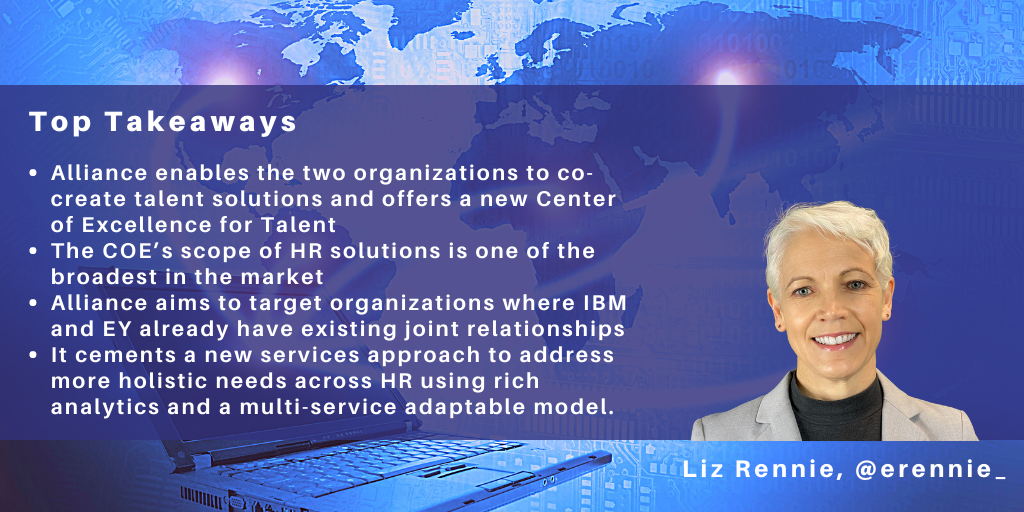
Following a year in development, IBM’s Talent Transformation division and EY’s Organization & Workforce, Mobility, Payroll Operate and HR Transformation division have announced a strategic alliance. The alliance enables the two organizations to co-create talent solutions and offers a new Center of Excellence for Talent, which could be a game-changer in terms of the HR scope it offers to the market. The COE will offer solutions with both data-driven AI and hybrid cloud to provide one of the broadest advisory, talent, HR, mobility, outsourcing and payroll transformation services available in the market, as well as offering long-standing domain expertise and delivery credibility.
This alliance cements what was an emerging model of the two organizations working together, and recognises a close cultural alignment. The alliance has naturally evolved from a number of mutual clients in the financial services sector, where the opportunities for synergies across the EY and IBM offerings were clearly demonstrated. Further, the EY and IBM talent businesses are closely entwined with a deep working knowledge and vested interest in each others’ businesses. IBM is already a client of EY for mobility and M&A services and EY is a client of IBM for Talent Acquisition, HR outsourcing services and technology services. This development also follows the formalized Financial Services Alliance that was established in April 2021 between the two organizations.
As part of the alliance, a new teaming agreement is now in place that brings a more formal framework from which to support joint client engagements.
Scope of the EY-IBM Alliance
There are four areas of focus for the EY-IBM Alliance: Talent Technology Services, HR Outsourcing Services, Payroll Services, and HR Cloud Transformation.
Talent Technology Services
The alliance now brings together the EY mobility and people experience technology assets with IBM’s talent microservices and deep expertise in platform strategy, hybrid and multi-cloud architecture.
The alliance roadmap includes transforming HR processes across recruitment, career progression & learning, and employee support. The technology vision of the new Digital HR Operating Model recognizes that technology is moving fast, and so the operational framework must enable technology to be continuously adapted as new opportunities arise; for example, through leveraging microservices and accelerators on the IBM talent platform.
HR Outsourcing Services
IBM already had significant capability running multi-process HR outsourcing contracts, plus capability to deliver talent and skills transformation services (across both recruitment and learning) blended with sophisticated data-driven analytics. Analytics and technology are differentiators of the IBM outsourcing offering, and this new alliance enables a richer offering extending to mobility and expat services, enhancing its offerings.
Payroll Services
Both organizations have significant payroll service capability and offerings; however, the alliance offers support across 160 countries for payroll services, powered by intelligent workflows and proprietary payroll technology. The alliance means payroll services can be more easily blended between EY and IBM.
HR Cloud Transformation
To support HCM platform change (such as Workday and Oracle), implementation teams will be enabled more easily across the two organizations, with an anticipated 3X speed of deployment leveraging the bench strength, technical capability and data-driven methodologies to help transform and enrich the employee experience.
EY-IBM Alliance Governance & Target Market
The alliance will be governed by EY’s Global Talent Committee and IBM’s Talent & Transformation leadership team. Each organization has appointed a Global Alliance leader as well as regional leaders.
Where offerings overlap between IBM and EY, such as in consulting and change management, the strong client focus and cultural alignment between EY and IBM will help ensure that the client’s interests and needs are prioritized. EY and IBM have a mutual interest in measuring the NPS of the alliance clients and have the goal that the NPS are increased as a result of working closer together.
The alliance aims to target organizations where IBM and EY already have existing joint relationships. For these clients, it offers an opportunity to enhance the services without having to go to the wider open market as the partnership is already established and provider credentials already assessed.
NelsonHall Insight
There is continued pressure on organizations to source talent and support greater mobility at speed, scale and with digital processes; these processes are becoming essential for organizational growth.
Further, as organizations increasingly focus on attracting and retaining staff, they are demanding more integrated solutions. The EY-IBM Alliance can address integration more directly through richer support for both consulting and technology solutions that can embed AI and automation throughout the talent process to help simplify and streamline the end-user experience. No longer is there a rationale to transform just on cost efficiency. Delivering an ongoing superior employee experience that is being continually invested in, offering greater insight, and a roadmap for process and talent innovation over time has become key. At this time of intense competition for professional services personnel, the formation of this alliance couldn’t be more timely.
The alliance cements a new services approach to address more holistic needs across HR using rich analytics and a multi-service adaptable model supporting clients with an ambition to take employee experience and operational excellence to new heights.
Links to corporate announcements:
https://www.ibm.com/blogs/internet-of-things/ibm-ey-partnership-hr-mobility-payroll/
]]>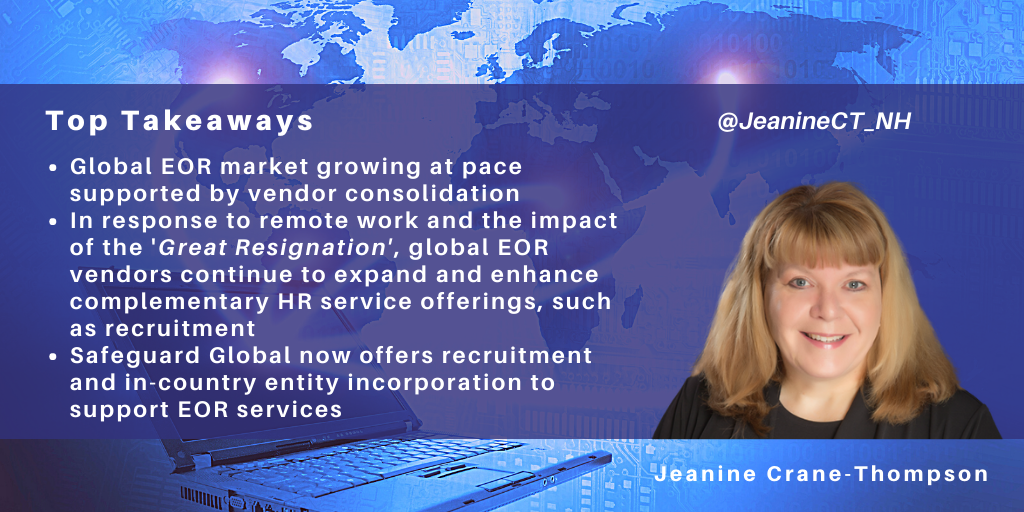
Safeguard Global acquired Global Upside Corporation, a global expansion, technology, and services company based in San Jose, CA on January 25, 2022.
Global Upside specializes in EOR services, new entity incorporation, human resources, accounting, payroll, and tax & compliance solutions. The country footprint across both organizations is well aligned. This acquisition will add ~500 employees to the existing 1,100 Safeguard Global employees, to create a combined organization comprised of 1,600 employees. Global Upside has been rebranded as Safeguard Global.
Significant to this acquisition will be the ability for Safeguard Global to provide additional services to enrich its EOR offering, specifically adding front-end HR capabilities such as recruitment and in-country entity set-up expertise, to ensure clients are prepared for the future of work. Safeguard Global currently delivers onboarding, in-country compliance, HR technology, and centralized payroll services.
The acquisition of Global Upside positions Safeguard Global as one of the largest providers in terms of revenues in the EOR marketplace. NelsonHall estimates the combined EOR 2021 revenues for both organizations were $65m.
The acquisition of Global Upside supports the Safeguard Global ‘Work in Any Way’ workforce management vision, which considers where, when, and how people work to assure a people-centric, flexible, inclusive, and diverse organizational culture. The complementary service offerings provided by Global Upside will be valuable to organizations when they have determined that a market is suitable for a permanent in-country entity.
NelsonHall views this acquisition as a service expansion to support Safeguard Global’s end-to-end global growth journey. It anticipates synergies between the client portfolios to enable cross-selling opportunities. For example, in 2021, Safeguard Global had 72 EOR clients that opened new entities in ~100 countries. The clients leveraged their internal HR organizations to organize and complete the logistics of establishing these new entities. Moving forward, Safeguard Global will have the ability to provide these and additional direct services that will enable internal client resources to focus on strategic initiatives and core functional responsibilities.
Safeguard Global has a history of acquisitions, including GEDA in 2020, and WorkFor Group and AdminMe in 2019. The acquisition of Global Upside firmly cements the organization as a leader in the global EOR market.
Several other EOR vendors have made similar acquisitions to extend their capabilities, including:
- Velocity Global acquired iWorkGlobal in April 2021 and Shield GEO in July 2021
- TopSource Global Solutions and PEO Worldwide merged to form TopSource Worldwide in August 2021
- Deel acquired Roots, an HR software company, in January 2022.
The rapid increase in remote working combined with the impact of the ‘Great Resignation’ has contributed to a high level of Global EOR market activity and client interest. NelsonHall expects more acquisitions in the global EOR market in the year ahead to support rapid growth and capability expansions.
]]>
Last week marked Neeyamo's Payroll Beyond Borders' virtual global payroll industry event. The keynotes were delivered by payroll industry leaders Dan Maddux, Executive Director, American Payroll Association, and Ken Pullar, CEO, CIPP. The event had around 1,200 participants from around the world and was the first global coming together of global payroll industry experts since the start of the pandemic. As well as looking at the impact of the pandemic on payroll operations, there was also attention paid to how global payroll and agility is increasing in importance, reflecting changing priorities and the need to "meet the employee" where they want to work.
New Payroll Complexities Created by the Pandemic
The pandemic and related regulations or government subsidies meant new levels of complexity were introduced to payroll operations, complexities that needed to be handled without any delays. Payroll leaders highlight that payroll teams, both outsourced and in-house teams, should receive recognition for their efforts. The migration of staff to work-from-home locations put additional strains on payroll departments, both because of the associated risks and also the challenges in managing employment taxes in alternative payroll jurisdictions. Employees don't always feel the need to tell their employers where they are located if they are working remotely. Over the next year, some organizations may be facing the tax impact of changed employee locations retrospectively. The business continuity plans that were activated were not designed or expected to remain in place for months on end as lockdowns were extended.
The pandemic and the general ensuing migration to WFH has helped shift the employee/employer power dynamic in favor of the employee. Employers will increasingly need to meet their employees' requirements as to where they want to work and how they want to work if they are to keep talent. Payroll systems need to be agile to support additional payroll jurisdictions, and payroll managers should consider adding new processes to enable employees to include remote locations for recording their place of work.
Employers are advised to re-evaluate business continuity plans and payroll controls. This is a time to upgrade and improve business continuity by investing in more robust digital processes to enable payroll to continue flexibly. The pandemic has exposed significant manual processes based on outdated systems that need to be re-evaluated to keep the payroll running during times of crisis.
On-Demand Payroll Increasing in Significance
There has been a growth in on-demand payroll offerings, otherwise known as ESAS (employer salary advancement schemes), particularly in the U.S. and the U.K., which are the primary markets currently. The pandemic has helped accelerate this growth: in the last two years, more workers have had to contend with financial stresses caused by a combination of limited or zero savings, reduced income, and unforeseen emergencies. And as the cost of living continues to rise in most markets, this isn't going to get better any time soon. Even amongst workers with above median, secure incomes and a decent level of savings, a growing proportion has been facing problems with their financial budgeting, perhaps due to timing mismatches between income and major outgoings. The household debt-to-income ratio has been rising for years, and in the U.S. and U.K. is over 100. With the current war for talent, there has been an increased focus by organizations on employee retention and the employee experience – and this includes improving employees' financial wellbeing. It should go without saying that employees that are financially stressed are not going to be the most productive, healthy, safe, or loyal members of the workforce.
But there are major considerations to be taken into account by employers when considering introducing on-demand pay systems, among these:
- The potential impact on company cash flow, though this is not an issue for organizations that work with third-party ODP providers
- Providing employee education on the principle that having access to a proportion of their pay on an on-demand basis does not automatically lead to financial wellness. Placing restrictions on the frequency with which an employee can apply for on-demand pay might help employees in their debt management and/or financial budgeting to an extent
- The risks of exposing employee data to financial services companies who might push other loan products.
So which types of employees are more likely to be interested in on-demand pay solutions?
- Younger employees with little or no savings, who are also facing large one-off outgoings, and who are new to financial budgeting
- Part-time and temporary employees, who will continue to represent a growing proportion of the overall workforce in all geographies
- Industries like hospitality and industries that have a high proportion of hourly-paid workers, especially industries with significant amounts of overtime (not having to wait to the end of the month when you have done a lot of overtime and have an immediate financial need is a significant benefit)
- The public, healthcare, and education sectors, which are major employers.
There were some concerns about on-demand payroll expressed by payroll leaders at the event. Among these was a concern that, given many companies have spent decades moving employees away from weekly pay cycles to monthly (U.K.) or two-weekly (U.S.) cycles, and thereby reducing operational payroll costs, is going on-demand a backward move for both employer and employee? However, from the employee's perspective, having access to on-demand pay is likely to be an attractive element in a benefits package.
The pandemic has changed organizations' priorities in terms of their people and operations. And it has thoroughly tested the robust nature of payroll operations, to unprecedented levels. There was a general consensus at the event that there is a continuing need to prioritize agility and automation in global payroll operations.
Nobody should underestimate how essential payroll is, though putting money into the bank accounts of employees in an accurate and timely way is often a thankless task. Payroll processes need to be robust if they are to support new ways of working, and Neeyamo's event was a valuable way to discuss and test thought leadership ideas.
]]>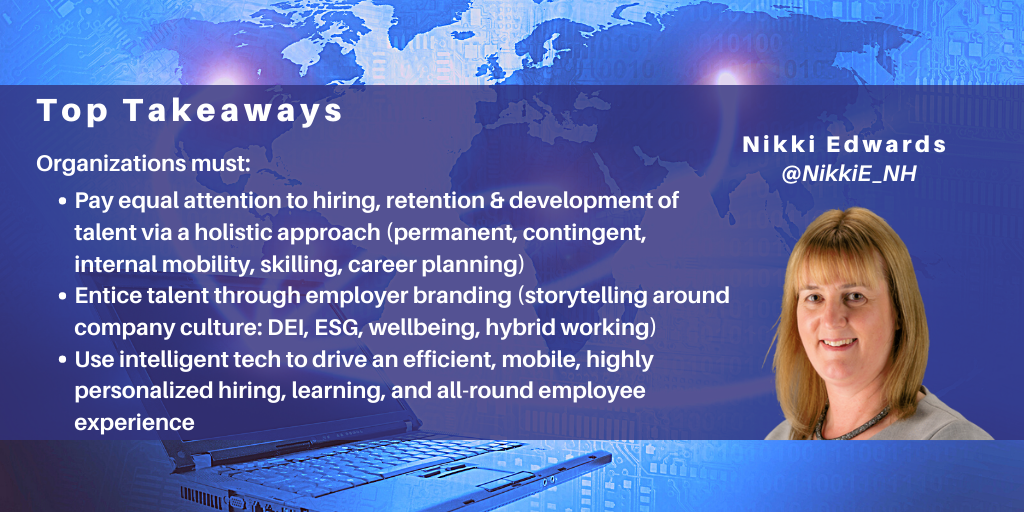
Here I look at the major trends for the year ahead in two key areas of HR: recruitment and learning services.
Recruitment Trends
Talent Acquisition (TA) challenges were already complex in the pre-pandemic period, with an aging workforce population, shortage of digital talent, rapid evolution of technology, Brexit, legal changes, and more. The pandemic added another layer of complexity in 2020: the rapid shift to digital hiring/onboarding (with some sectors seeing rapid upticks in activity), non-digital skills shortages, working from home and keeping workers safe and well. While expectations for 2021 focused on digital, hybrid working with a highly-distributed workforce, the Great Resignation presented unforeseen challenges, with knock-on consequences, requiring organizations to take a different approach to the future of work.
Organizations struggle to find talent in a highly-squeezed market, as tried and trusted methodologies no longer work. More are reaching out to vendors for support as they become desperate to attract candidates while juggling increased turnover levels of existing employees. Vendors are evolving their TA solutions in line with advancing TA trends. The hot topics for 2022 will be:
A total talent/holistic approach to hiring
Organizations will act upon their 2021 intentions, as sought-after talent is no longer guaranteed from traditional full-time/permanent channels, requiring a contingent or internal mobility channel approach. So, all organizational functions must work collaboratively to proactively strategize their 2022 talent plans via a strategic workforce planning (SWP) approach, using enabling technologies to aid the process. While some urgent talent needs may require a quick fix, this reactivity is unsustainable long-term. An increased focus on internal talent mobility will reduce the risks of unnecessary employee turnover. Organizations must also plan their salary/contractor rate positioning (avoiding neglectful over-inflation of rates) to prevent future problems around pay inequities across the workforce.
Back-to-basics recruitment
Companies are competing for talent from shrinking talent pools, as the sansdemic (decreasing working-age population) and the Great Resignation dominate the 2022 market. The most in-demand TA services will be employer branding and associated services contributing to organizations’ brands. Businesses will work hard to promote their company cultures to be future-of-work fit for their audiences, across all talent channels. Priority is on promoting diversity, equity, inclusion, and belonging (DEIB), work flexibility, safety/wellbeing, career longevity, and environmental, social, and corporate governance (ESG) issues.
In one of the most candidate-led markets in years, tried and trusted recruitment methods are becoming less effective, yielding fewer candidates. While pandemic-induced travel restrictions impact talent mobility on the one hand, on the other, more significant opportunities exist to engage remote talent globally. So, organizations must expand their repertoire of initiatives to reach candidates: international hackathon events to find future digitally-skilled talent, leveraging previously untapped audiences (career returners or those launching second careers). Companies failing to focus on these basics will lose out on vital talent.
Building talent by upskilling and reskilling organizations’ workers
Traditionally, the focus was on building in-demand digital skills and reskilling workers whose roles were being automated. Organizations must now expand the remit to offset the broader talent challenges associated with employee churn.
Essentially, TA and learning will work in greater unison. Corporate functions must plan how talent will be managed beyond initial recruitment/onboarding to drive ongoing employee engagement and development, to encourage longevity of service. A training course here and there or a HiPo scheme for a select few are no longer fit-for-purpose in their traditional formats. Long-term career mapping and initiatives to put newly-learned skills into immediate practice for all workers will be required, or workers will seek to progress their careers elsewhere. Core to this experience is using intelligent, AI-driven tech, feeding personalized content, enabling a self-service, pull approach to skilling, upskilling, and reskilling.
Next-generation platforms/tools
Hiring quality candidates at speed while driving a highly-consumerized experience will remain a priority (although hiring speed success is likely impacted by talent availability). Candidates will expect a predominantly digital hiring experience to meet the needs of a workforce seeking flexibility and being less focused on having a physical workplace presence.
Employees will expect to use intelligent tech, underpinned by sophisticated RPA, AI, and ML, via a single platform interface to drive a highly tailored and personalized day-to-day work experience (feeding relevant content to them to maximize role efficiency). Hence, there is also a greater shift to a microservices/low-code/no-code architecture as a standard. The appetite for deep data and predictive/prescriptive analytics will grow, as organizations and their workers seek insights to help eke out extra competitive edge in all areas of talent. The use of digital agents and voice-enabled technology to personalize the tech experience will be a focus in 2022.
Learning Trends
In 2021, learning focused on building out the digital foundations initiated in response to the 2020 pandemic. Hence, the criticality of using the most appropriate technology and tools to drive a digital learning experience emerged. It is now generally accepted that a predominantly digital learning approach is the way forward, focused on skilling for the future of work.
Events such as the Great Resignation of 2021, inadvertently fueling the talent shortage, have turned attention to employee engagement, retention, and development to offset employee turnover. Hence, in 2022, learning will see a revitalized focus and achieve a higher priority within organizations to curb TA challenges (as part of the holistic/total talent approach to attaining the skills needed). Learning vendors continue to develop their services and technology apace to support businesses in meeting their workforce skilling needs. Hot topics for 2022 will include:
Tailored content for skilling
Learning vendors will continue to curate content (where there is an abundance of ready-made material available on generic skills) and create content (where organizations need tailored content for a product or specialty compliance reasons). Subjects such as digital skills (from basic to advanced, niche, certified skillsets) and future of work skills (remote leadership, maintaining wellbeing), commonplace since 2020, will continue apace.
With many organizations focusing on raising their corporate profiles to attract talent, there will be demand for DEIB and ESG awareness training, living the company culture when workforces are remote, and managing employee performance/career conversations. Enhancing skills training focused on the digital world of work will include digital selling (without face-to-face engagement).
Learning tech/tools
In 2022, the technology and tools focus will deliver experiential learning, taking advantage of RPA, AI, and ML developments, driving content suited to individual learners' preferences and needs. More organizations will seek advice on replacing or augmenting their existing learning systems with LMS/LXP and other specialty platforms to ensure learning is engaging and tailored to encourage self-service/pull learning in the flow of work. Notably, Microsoft Viva will make an impact on the LXP market. Driving learner engagement will start at the candidate level via digital onboarding (supporting pre-boarding learning activities to give new employees a head start and the opportunity to reach productivity sooner).
Next-generation platforms delivering digital internships, graduate programs, academies, and certification programs will be sought to skill, upskill, and reskill a more distributed workforce, to engage and retain them long-term. The use of events platforms will also increase alongside. A mobile-first/appified and microlearning approach will dominate, enabling learning to take place in small chunks across all devices, fitting in with learners’ busy lives. For companies keen to create content internally or manage curated content, the uptake of rapid authoring tech and content library subscriptions will increase. Organizations will seek more learner-specific data/analytics to measure the success of their learning programs as the competition for skilled talent intensifies.
Next-generation modalities
The emphasis on experiential learning will drive the demand for engaging modalities, such as video, animation, gamification, serious games, and simulation. There will be re-energized demand for VR, augmented reality (AR), and the metaverse, as the technology becomes less expensive. An emerging area is haptic technology enhancing kinesthetic learning.
Other learning services
Demand for consulting services will continue, covering digitalization of learning (including tech/tools and learning content advice), reskilling/upskilling, and driving learner engagement (as retention of talent becomes a priority to avoid unnecessary turnover). Administrative services will continue to focus on systems administration and the sourcing of third-party suppliers, as more organizations decide to outsource such tasks.
]]>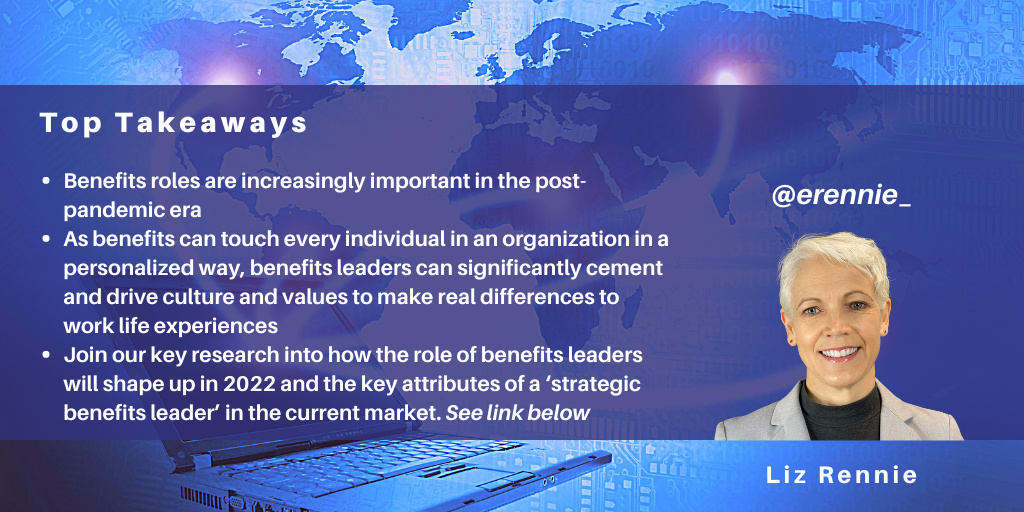
Since the start of the pandemic, company benefits have played an increasingly important role in helping organizations protect the safety, wellness, and health of their employees. This is increasingly the case, not only for physical wellness, but organizations now have greater awareness of mental health and financial wellness impacts on their staff given recent challenges and mass resignations.
2022: a perfect storm for benefits
The dominance of remote/hybrid work environments also opens up new opportunities for benefits functions to offer new benefit types that could be seen as tangible expressions of a company’s culture. Therefore, If employee welfare, attraction, and retention are not top of the list of your key strategic priorities for 2022, they should be. Not only are organizations and HR functions adapting to new ways of working and changing business environments, they are also facing the fact that employees have started to "vote with their feet”, demanding a better work-life balance. We are experiencing the largest wave of mass resignations seen in most of our lifetimes. This is also not helped by the retirement of baby boomers and an aging workforce. 2022 is the year to act, and these challenges also offer a great opportunity for benefits teams to relook at the role they can play in strengthening the resilience of companies and their workforce.
2022 is expected to bring a perfect storm that will drive companies to increase their focus on benefits, creating opportunities to address the importance of benefits and the benefits experience and HR teams should be looking to raise the bar in cascading key messages across management teams. Talent shortages are severe in many industries and the competition for companies to offer diverse and attractive benefits will also put companies and HR teams under pressure.
Benefits functions are in a privileged position to offer personalized support across a company's whole employee base and could become the hidden hero of HR in the coming year.
Launching a major new benefits study
To help shed greater light on this important topic, NelsonHall is launching an educational research study, in conjunction with Empyrean, designed to help benefits plan sponsors and administrators understand the wider impact they can make to help their companies adapt and be more competitive. Part of this research will look at the impact benefits can play in demonstrating, shaping and cementing a strong company culture.
Given the market forces outlined above, NelsonHall will look at how the role of benefits plan sponsors and administrators will change over the next year as the strategic importance of the benefits function grows. As part of the research, NelsonHall will be looking at how the benefits function is adapting and reshaping in the light of the wider business environment.
In particular, the study will research the wider and increasingly strategic role of benefits leaders. Benefits strategy is an increasingly important element within an organization’s wider HR strategy, such that benefits leaders are expected to play more strategic roles within the HR department and become key contributors not just in benefits strategy & design but in the development of talent acquisition, talent retention, and overall HR strategies.
The study will also investigate the changing benefits platform requirements. As benefits teams take on more strategic roles within the organization, platforms will take on an increasing proportion of day-to-day transactional activity, with organizations looking to establish hybrid and AI-driven omnichannel operations. These platforms will also increasingly provide the analytics and AI-driven personalized recommendations and decision support to fine tune benefits programs.
Get involved: join the research survey
We'd love to hear your views. To join the research survey The Changing Role of Strategic Benefits Leaders Survey please share your details here. The survey will be open until 31 January 2022 and all participants will receive our research report containing a detailed analysis of the findings.
The survey results will be announced and discussed across the benefits community at the Empyrean EVOLVE client conference in Nashville, TN, from April 6-8, 2022. For those not able to attend, you can obtain a copy of the research report from the Empyrean site following the event.
About Empyrean
Empyrean is a benefits service organization that recently launched its new brand strategy to address "building culture through benefits". It looks to drive positive workplace cultures by connecting its employees to life-enriching benefits. Empyrean’s new brand message makes a strong connection between the role benefits play in building a company’s culture and positive organizational outcomes tied to total employee health and wellness. The brand strategy reflects Empyrean’s product roadmap, as the company continues to develop and roll out employee-centric technologies and services along with strategic carrier and service partnerships designed to improve employee experiences and strengthen employer brands.
For more information on Empyrean’s brand strategy: https://www.goempyrean.com/empyrean-benefit-solutions-launches-new-brand-messaging/
]]>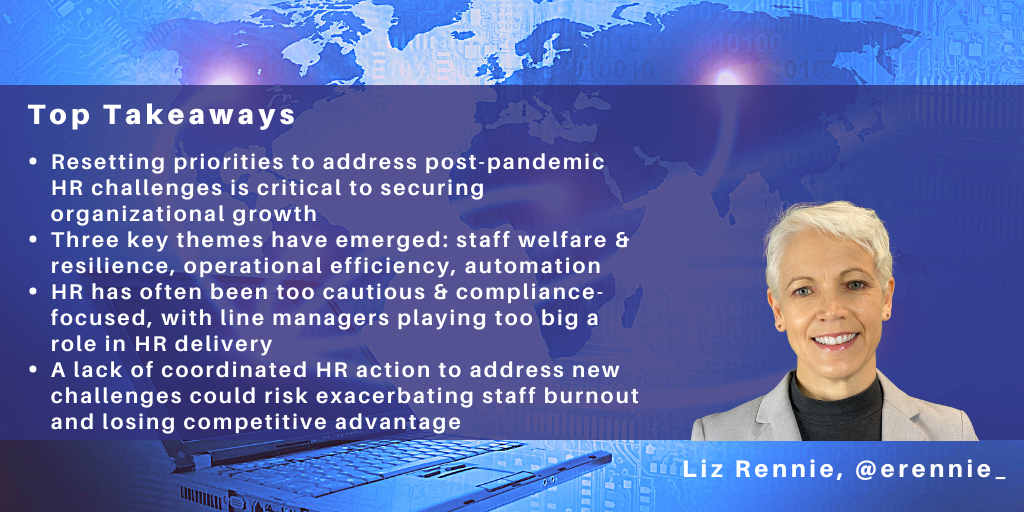
As the pandemic normalizes across day-to-day life, NelsonHall expects HR service delivery to adapt to a whole new set of challenges, both through legislation and HR best practices.
The convergence of three key themes are likely to see new HR solutions being developed: staff welfare and resilience, operational efficiency, and automation.
Staff Welfare and Resilience
Pre-COVID, HR priorities looked something like this:
- Attraction and retention of talent: by the end of 2019, the EU was experiencing the lowest unemployment in 20 years
- Upskilling workforces and identifying skills gaps, taking into account jobs that are increasingly being replaced by robots and automation
- Employee engagement and experience, in particular supporting Gen Z and multi-generational workforces
- Pay: reporting, gender diversity, and addressing the gender wage gap, and removing bias from processes
- GDPR compliance: the General Data Protection Regulation (GDPR) is the toughest privacy and security law in the world and was put into effect in May 2018 across the EU.
A 2021 study by SD Worx1 looking across 21 HR challenges has found that the top five European HR challenges in the coming years are as follows (with the percentage of respondents placing each challenge in the top 3):
- Staff welfare and resilience: 27%
- Employee engagement and experience: 20%
- Attracting and recruiting talent: 20%
- Sustainable employability of employees (retention): 17%
- Talent development and internal mobility (retention): 17%
The number one priority in the coming years is not surprisingly welfare and resilience, which is the most significant change from previous years. Staff welfare and resilience in this context means supporting workforces through added pressures to avoid burnout/resignations and supporting healthcare and wider work-life needs.
Prior to COVID-19, staff welfare and resilience was not a concept many HR service providers, platforms, or processes had to give much focus to, except as it related to workplace safety, accident reporting, OH&S, and sickness policy design and implementation.
Through the pandemic, individual staff ‘check-ins’ have become key. Without basic health information on their staff, how can organizations address staff welfare and resilience effectively? And today, organizations need to acquire even more information about employees – home location, travel preferences, vaccination, and medical information.
Is this asking too much? As we normalize our new ways of working and adapt to new HR practices, the GDPR provisions create unique challenges for HR, which faces a dilemma of how to respond to welfare and resilience issues while respecting GDPR rules. GDPR obligations need careful attention in this regard, as health information has the protected status of ‘special’ category data under data protection law. Various European countries are introducing local recommendations to help businesses navigate the next stage.
When NelsonHall interviewed HR service providers in 2020, we asked them how they were adapting. Most were creating communication tools to support employee outreach and manage business continuity and furlough during the crisis. Companies and service providers were initially timid to record health information such as vaccination status, but with legislation in various jurisdictions, organizations and HR tech providers are finally stepping up to implement robust solutions to record vaccinations.
NelsonHall expects that the HR priority given to employee welfare and resilience will likely stay for the longer term, so we expect more to be done to implement stronger processes in this area. HR service offerings expected to develop over 2022 and beyond will increasingly address vaccine uptake, mental health support, flexible working, and work office restructures with new procedures.
Operational Efficiency
The SD Worx study also identified that the highest priority in 2021 was addressing operational efficiency. It found that ~50% of organizations recognize operational efficiency as being the top priority or project for 2021. Similarly, NelsonHall’s 2021 Cloud HR Transformation market analysis report2 identified the top driver for cloud HR transformation as helping organizations stay competitive with improved cost, process improvements, and a superior employee experience.
Going forward, managing staff welfare and resilience should ideally be more than a line manager function performed through informal ‘check-ins,’ and it is imperative, to keep operational costs down, that HR revisits tactical solutions to build stronger processes to support resilience and welfare across employee populations. Without an HR response, talent attraction and operational efficiency will be challenged. The HR-specific COVID responses and workplace practices of organizations are critical now, especially given that many employees have experienced new-found benefits in working from home and have increased work-life balance demands and/or preferences.
Automation
Finally, what hasn’t changed? The SD Worx study found that in both 2020 and 2021, looking across 19 different HR functional and cross-functional areas, the top priority and the projects most organizations looked for help with from external specialists was improved HR process automation.
Looking across the cloud HR transformation market, NelsonHall’s 2020 report found that 5% of organizations interviewed were using robotic/AI automation services from providers, and this increased to 18% in 2021. The satisfaction level across organizations serviced also increased from a score of 4.0 out of 5.0 to 4.3/5.0. Automation can’t solve all needs for all processes, but in times of increased stress and to support the mass disruption that many businesses have had to face, a service partner strong in automation and technology as well as compliance can certainly save the day, and arguably should be table stakes when selecting a provider.
Summary
NelsonHall expects that in 2022, more HR offerings will be developed to support improved automation around staff welfare and resilience and help organizations drive greater operational efficiency while supporting employees’ individual needs with personalized HR service offerings. Part of addressing individual needs will also include a longer-term emphasis on flexible or remote working, a key factor in attracting and retaining talent over the next year. Finally, given the complexity of European legislation and storing data, providers need to be very savvy with the GDPR and help clients establish robust processes to make an impact.
HR may be cautiously putting in place new processes that store more personal data, but unless HR steps up, operational inefficiencies are likely to persist; HR can no longer afford for the management of staff health and welfare to be primarily a line management responsibility. Further, a lack of coordinated action could exacerbate staff burnout or resignations at the management level and discourage new talent if the organization is not seen as an employer of choice.
1 SD Worx 2021 ebook: Ride smarter not harder, Towards people-first digital HR
2 NelsonHall’s 2021 market analysis report: Cloud HR Transformation Services
]]>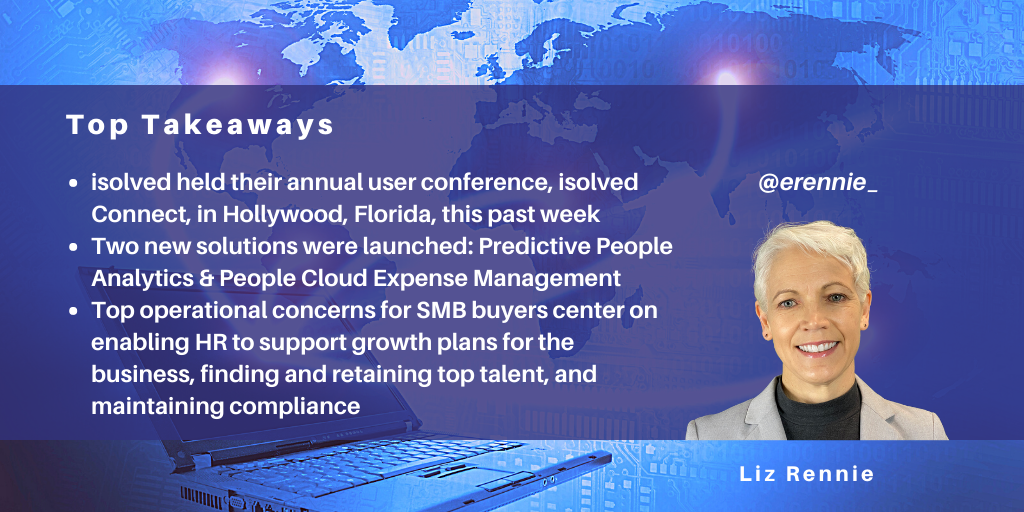
This past week I had the privilege of attending isolved’s Connect annual user conference at the Diplomat Beach Resort in Hollywood, Florida. The event marked a few firsts for me personally: my first time attending isolved Connect and the first time I have traveled for an in-person event in 18 months. It was great to get back to meeting and connecting with vendors and buyers face to face again!
Considering current events, the conference was quite well attended, with isolved confirming a 70% increase in conference attendance y/y from 2019 – which speaks to the value its HCM platform and extended HR services are enabling for its buyers and partners. isolved has done a lot to keep that value flowing, maturing its solution through product development and select acquisitions.
isolved’s strategy, tactics & roadmap
On the strategic side of the platform, isolved quickly put its recent purchase of AI-enabled analytics platform provider TrenData HR to work, launching isolved Predictive People Analytics at the event. The offering provides leaders access to AI-driven predictive insights against data from across its People Cloud suite of modules, surfaced through configurable dashboards and augmented by a voice-enabled virtual assistant.
From a tactical perspective, isolved introduced People Cloud Expense Management, which becomes available in Q4, and offers two levels: Essential and Premier. Both will offer isolved’s Adaptive Employee Experience, which includes a mobile-first UX, OCR for receipt capture, and full transparency into the process through to payment. For leaders, the solutions each provide automated workflow approvals, company-wide reporting, and dashboards for drill-down insights and control. Further, the Premier edition will support organizations with more complex expense management features, including credit card transaction importing, job and project costing, and deeper GL export capability.
isolved is focused on continuing its growth by maturing its technology and deepening its service offerings. Its roadmap looks to advance its talent management capability, including enhanced onboarding experience, support for total compensation management, career and succession planning, LMS integration to its wider engagement and talent products, and more tools to support reward and recognition. From a services perspective, isolved is focusing on supporting health and wealth, with benefits a key area of growth, and will launch a benefits brokerage capability and offering in 2022.
isolved will also continue to expand its partner network: both its payroll services reseller partners and its marketplace partners. isolved is working to further expand its marketplace of integrated partner solutions to address white spaces within its offerings, and further support its adopters in addressing unique needs and growing their businesses.
Key observations & takeaways
Throughout the week, I spoke with multiple isolved clients and partners (in many ways, clients themselves, commonly leveraging isolved’s platform to enable their own managed services offerings). Something that stands out in conversations with clients is their collective confidence in isolved, its executive leadership team, and the technology itself. Every firm I spoke to indicated lengthy tenures with isolved, commonly over five years, which speaks to the value, customer experience, and care isolved places on long-term relationships and retention of their clients.
I also noticed in my conversations just how much work SMBs need to do to mature HCM practices and support their planned growth as they also navigate today’s challenges as the future workplace continues to evolve. I think it’s indicative of the attendance increase this year, as many have important HCM buying decisions to make to address key gaps and futureproof their HR operations for continued growth. The challenges they face, while smaller in scale, align with those seen by their up-market peers. Top operational concerns I heard this week centered on enabling HR to support growth plans and strategic initiatives more efficiently and effectively for their businesses, finding and retaining top talent, and maintaining compliance.
Looking ahead, isolved’s leadership is keeping its foot on the gas in terms of innovation, platform maturity, and client adoption and retention. A key area of opportunity for the platform is talent management, which will see capabilities advance through its roadmap in 2022. The acquisition of TrenData HR fills a gap in cognitive capability which has enabled its predictive analytics offering and will support further AI-driven capabilities, which will be key for deepening talent insights and supporting an eventual talent marketplace offering. Further, isolved has some work to do to expand its partner integrations, particularly to deepen its capabilities to support unique client requirements and sector challenges and meet the growing demand for multi-country solutions by emerging SMBs.
With its platform and clients maturing, isolved is on a positive path to continue its growth trajectory. The challenge will be helping SMB buyers realize the need and value in adopting these more advanced capabilities and embracing technology to modernize their HCM practices and advance their business initiatives.
]]>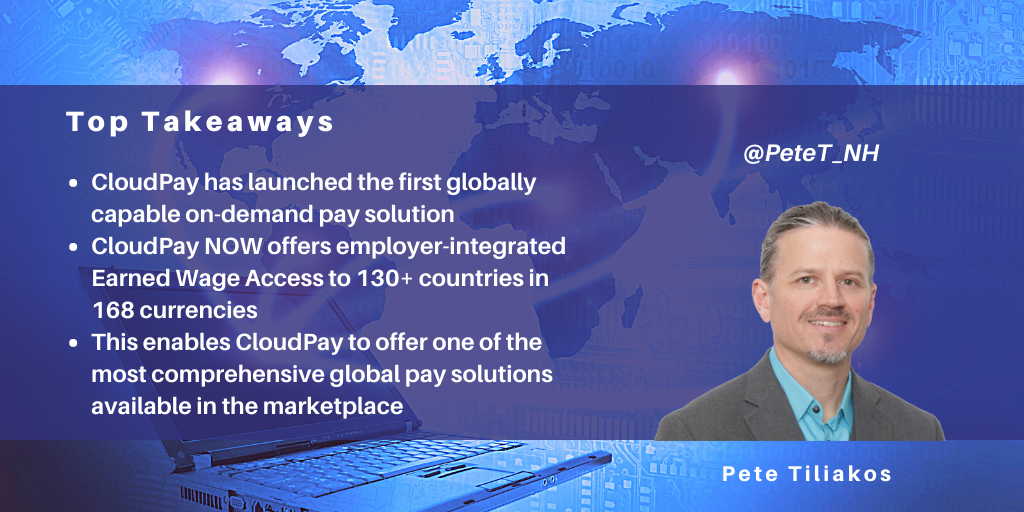
This past week, CloudPay announced the launch of CloudPay NOW, its latest offering focused on modernizing the way workers are paid globally.
The employer-integrated Earned Wage Access (EWA) solution is a key addition to CloudPay’s offering that pairs its unified database and technology-enabled operating model, with its deep global treasury capability to offer one of the most comprehensive end-to-end global pay solutions available in the marketplace.
How CloudPay NOW Works
CloudPay has enabled CloudPay NOW by leveraging a strategic acquisition it made very quietly in 2019 to boost its mobile payment technology. The solution integrates with CloudPay’s unified global payroll database, including workflow based on client payroll calendars, mobile technology, and its highly adopted global payroll treasury offering. The new offering can support EWA in 130+ countries and 168 global currencies. It further enables digital payments globally and in real-time leveraging established global payment RAILS.
The CloudPay NOW user experience is enabled through apps for both iOS and Android and provides employees with real-time access to earned wages for on-demand pay capability across the countries where CloudPay offers treasury support. Users are offered in-app support with chatbot and live chat options.
The benefit is cost-free for employees (employers are charged on a per employee per month basis) and provides them with early earned wage access, and real-time debit/credit card-based transfers to third parties, including person-to-person and person-to-entity. Because CloudPay NOW leverages a combination of credit and ACH RAILS, withdrawals can be performed in less than one hour, including on weekends, a much faster option than traditional bill payment solutions can provide. Transactions can also be scheduled for future dated payments and transfers based on automated target thresholds.
Further, the solution has been enabled with curated insights, guidance, and tools to support employee financial empowerment and wellbeing. Employers define set “business rules” within CloudPay NOW to guard and control employee access and withdrawals to ensure healthy usage of the capability. Employees can also adjust preferences (within client business rules) to support personal thresholds and limits.
The impact of CloudPay NOW
For employers, a globally unified payroll solution that goes beyond gross-to-net calculation to payroll funding and payment fulfillment offers real value for multinational firms supporting a global workforce. Traditional payroll solutions stop short of global payments, leaving employers to sort time-consuming money movement and foreign exchange complexities, often extending the pay cycle and timeframes for payments to reach employees.
With payroll at the heart of the employee experience, employers across sectors seek more ways to compete for top talent by providing differentiated experiences. On-demand pay breaks down lengthy pay cycles, and empowers employees to control the timing of their pay, boosts financial wellness, and offers them personalization to meet their unique financial needs (e.g., remittance to family members) and aspirations. Early adopters of employer-integrated EWA have seen measurable and impactful results beyond simply driving up direct deposit and digital payment adoption, with positive impacts on talent attraction, hiring, retention, and engagement resulting from deploying the benefit.
To date, EWA solutions have been most available and adopted amongst U.S.-based employers and employees, with limited solution options internationally. With CloudPay NOW, multinational employers can offer the benefit of an on-demand payment solution to all of their employees globally, something other EWA solutions have failed to provide, as they are often enabled for a single country, or a few at most.
It empowers employees with control to determine how and, more importantly, when their earned wages are distributed. Payroll processing has long favored the employer with lengthy pay cycles, forcing employees to wait as much as a month for their earned pay. Meanwhile, their lives and financial needs are occurring in real-time, often leaving workers to tap risky alternatives to address unplanned expenses.
CloudPay NOW provides employees with a tool that converges their pay with day-to-day life in real-time and provides tools to support money access and transfers, with insights to make more informed decisions with their earnings to reduce debt, advance savings, or navigate financial challenges as and when they occur.
The future for CloudPay NOW
The launch of CloudPay NOW is well-timed, given the groundswell of momentum building around digital payment solutions and their adoption. With digital payment adoption rising globally and mobile-first experiences fueling consumer expectations for on-demand experiences, the convergence of payroll with these factors has made employer-integrated earned wage access a standard element in modern payroll solutions. Further, in the environment of COVID-19, many firms learned just how challenging yet vital and impactful the ability to move earned wages to employees in a timely fashion can be – particularly those operating with multi-country footprints. Building resilient global payroll operations will require adopting modern digital capabilities like CloudPay NOW and its underlying treasury capability.
With clients now more commonly looking for their payroll vendors to provide treasury services as part of their managed payroll services arrangements, but not all vendors actively offering global treasury support, CloudPay is particularly well positioned to leverage its offerings synergies to boost adoption; its treasury service alone has been adopted by ~90% of its client base and continues to see similar uptake in new deals.
Looking ahead, CloudPay plans to add a digital wallet capability, including a branded pay card solution and is actively advancing its employee wellness support with expanded budgeting and planning tools. The solution is also enabled for (and has a selection of) non-profit relationships (which it continues to curate) for enabling philanthropic donations by users through their earned wages. It is also in-flight with FCA certification, which it expects to complete next year.
CloudPay will also seek to leverage CloudPay NOW to drive additional recurring revenues. Longer-term, it sees CloudPay NOW as a standalone offering that could begin popping up in vendor marketplaces through integrated partnerships and white label opportunities for reselling the offering. Its in-country payroll partner network will be engaged first, with broader market providers in focus next.
CloudPay NOW already has a sizeable, multinational brand/employer piloting the capability to support 6k employees across 24 entities and 15 countries by the end of summer. The solution is expected to be well adopted by its client base, particularly those firms operating in challenging sectors with high hourly worker populations.
The addition of CloudPay NOW to CloudPay’s global payroll offering provides a unique synergy to drive adoption for its complete offering amongst new buyers. Additionally, it elevates its value proposition considerably amongst buyers of global payroll services, providing it with a differentiated, end-to-end offering that pairs payroll technology and services, global treasury, and global payments within a single vendor solution.
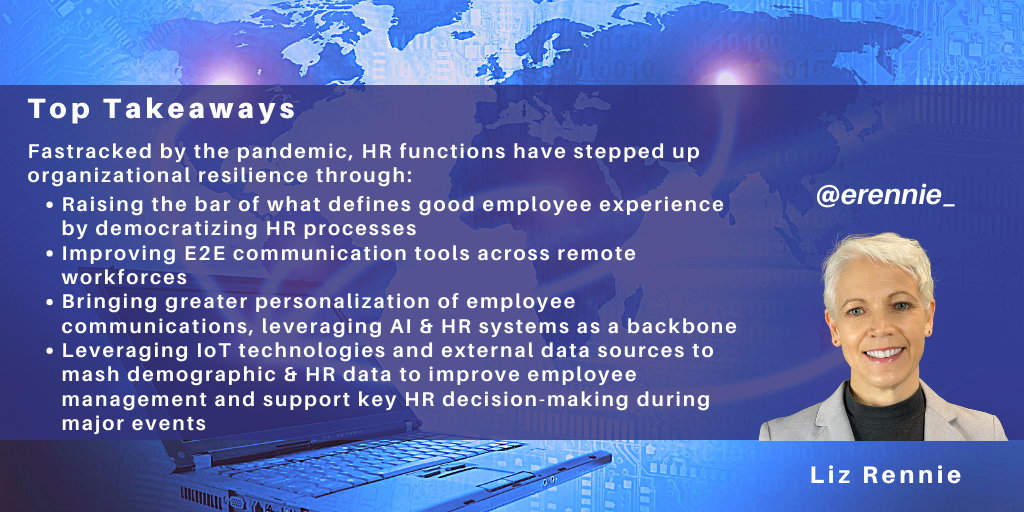
The last two years have challenged employees and HR teams in ways we could never have imagined, and many now have a new outlook on what “work-life balance” means. 2020 and 2021 have seen heightened resignation levels, and companies are only now starting to reflect on the impact of burnout on their employees. While vaccines are being rolled out, and with the threat of local breakouts of new variants continuing, companies are likely to continue to be cautious and invest in greater workforce management capability. They are likely to require more robust processes to support social distancing at work locations for many months to come as society adjusts to the post-pandemic way of living. In Q2 2020 alone, during the first pandemic peak in Europe, companies like Quinyx saw an incredible demand and reported 41 new signed customers, a 46% y/y growth rate.
Given the importance of this topic for the HR function, NelsonHall launched its first Workforce Management market analysis (full report available here). Some new HR themes emerged from this report that aims to help companies develop greater resilience. A couple of exciting developments are outlined below, with my reflections on whether they are likely to be lasting or not.
Democratized HR processes
Facilitated by technology, there is a growing trend for HR processes to be more democratized, enabling employees to have more of a say in defining what work suits them and when. This trend takes employee self-services to the next level of sophistication. For example, in the Workforce Management market, vendors have been increasingly enabling functionality to allow the employee to bid and auction shifts, swap shifts, and choosing when they work or go to the office. An example was a service center team that over 2020 enabled greater flexibility to support employee availabilities while allowing them to care for family members during COVID lockdowns. What used to be a leave process where you place leave requests is being adapted to support new attendance processes to enable employees to juggle work-life challenges.
My POV: democratized employee processes will grow. Where employee-to-employee interactions were traditionally managed informally face-to-face, with the backdrop of a larger share of the employee base working remotely, digital solutions are likely to identify opportunities to simplify processes through offering employee-to-employee connections increasingly. It will do this by formalizing what used to be informal interactions through richer democratized processes. These will increasingly appear across more functions and will continue to challenge and expand the concept of what makes up an “employee experience”.
Vendors that offer democratized shift swapping processes include ADP, Ceridian, Infor, Quinyx, SD Worx, TCP, UKG, and WorkForce Software. A number of these incorporate AI-based recommendations to fill the shifts. Shift auctioning is on the roadmap of several providers.
Direct communications
HR systems have traditionally not attempted to support E2E communications as this was the function of corporate emails or other means such as morning huddles. However, the pandemic necessitated a quick means of communication with remote or deskless workers who do not have email (e.g., delivery drivers). Workforce management systems stepped up to facilitate group communications so that messaging to people assigned to a particular shift or within a special grouping became much easier. The pandemic has raised awareness that direct communication tools are invaluable in a crisis. Many workforce management solutions now enable a click of a button to chat to everyone about to start a shift via a mobile.
My POV: Effective communications are critical for business resilience. The importance of communicating to large groups of employees based on work allocation, projects, location, and various other factors makes HCM and workforce management platforms ideal for offering this capability to organizations. For effective communications, personalization and employee preferences also need to be taken into account. Organizations can refine the level, type and style of communications based on employee preferences, job, location, and E2E needs. We expect HCM and workforce management technologies to increasingly drive a two-way communications approach, data rich and AI-supported across broadcasts, E2E, surveys, and chatbot communications.
IoT integration and data mash-ups
The importance of knowing your employees’ whereabouts in a crisis has been brought to light by the growing number of geopolitical, climate, and pandemic events. IoT and workforce management blended solutions offer the capability to ensure employee welfare while at work with geo-tagging/tracking, BLE tags for monitoring adherence to social distancing guidelines, and access restrictions based on thermometer checks. These are some of the complementary components of workforce management solutions that were implemented across 2020-2021. In 2020, many HCM providers (e.g., UKG, Workday) offered a new COVID mash-up report which mapped COVID outbreak data with employee locations.
My POV: Buildings have fire plans; to support remote workers, HR systems will increasingly step up and support greater health & safety features using IoT integration combined with external data sources to support significant events. Going forward, expect to see more business continuity functions embedded in HCM and workforce management platforms. A leading HCM and workforce management vendor, UKG, recently launched its Workforce Continuity Hub to support times of crisis with safety check-ins, a personal impact form, vaccine monitoring, and current crisis management where HR teams can create "events” (e.g pandemic/flood etc.) as they arise and track the event impact to enable a rapid HR response.
Find out more
Solutions will continue to evolve to help businesses adapt to a post-pandemic world. To find out more about what is happening in the workforce management market, NelsonHall’s HR Technology & Services clients can download our ground-breaking report in this field here. Alternatively, please contact Guy Saunders.
Buyers can also access NelsonHall’s Vendor Evaluation & Assessment Tool (NEAT) tool for Workforce Management that analyzes the performance of nine vendors offering workforce management technology. It is a suite of "speed-to-source" tools to assist strategic sourcing managers and HR technology executives in saving time and money while enhancing the quality of their workforce management technology sourcing decisions. The following vendors are included in this tool: ADP, Capita WFM, Ceridian, Infor, Quinyx, SD Worx, TCP Software, UKG, and WorkForce Software.
]]>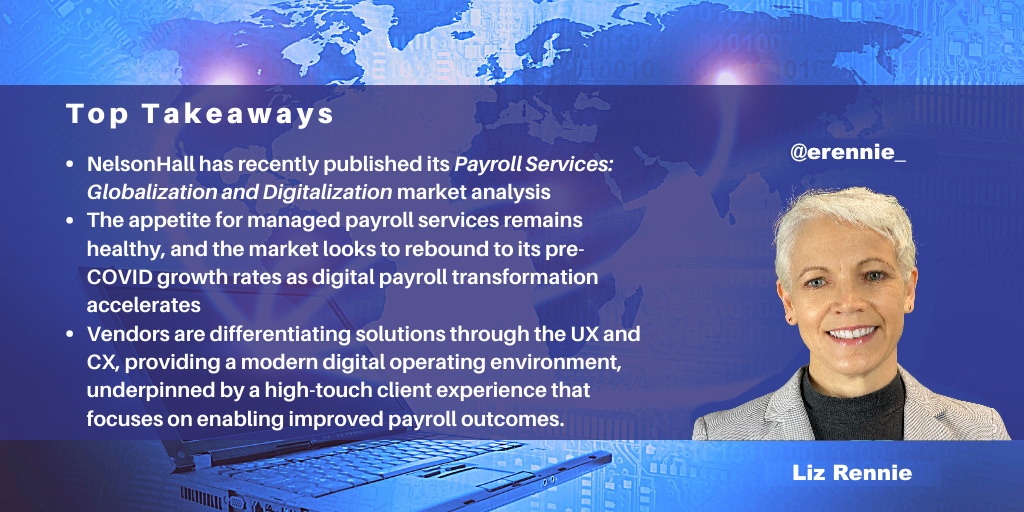
This is the final part of a three-part blog series covering my perspectives on the payroll market based on NelsonHall’s latest annual market analysis, Payroll Services: Globalization and Digitalization. Part One features the payroll buyer perspective, with Part Two looking at the managed payroll service providers currently pushing the pace of innovation. Here I focus on the outlook for the managed payroll services market and what to expect as we move forward.
Managed payroll services adoption
The appetite for managed payroll services remains healthy, and the market looks to rebound to its pre-COVID growth rates over the next three to five years, as digital payroll transformation projects are accelerating and firms seek to modernize this critical process for greater continuity, resiliency, and strategic value. And this is particularly true as payroll buyers more commonly require support from managed service providers in undertaking large-scale payroll transformation initiatives.
The mid-market buyer will remain the largest adopter of managed payroll services globally, while large/enterprise-sized, late adopters of cloud-based core HR platforms will increasingly seek to extend cloud investments with integrated modern global payroll solutions. Small market firms are more commonly seeking payroll services as a core component in broader HCM technology and services solutions and are increasingly finding their footprints creeping to new international markets and require support for multi-country payrolls.
While single country adoption is steady, multi-country service adoption will continue to outpace single country deals by as much as 5x, as firms of all sizes and sectors will continue to see their footprints pulled to new countries of operation, particularly as 'work from anywhere' continues to trend upward, and talent is sourced from new locations. With providers now capable of supporting >150 countries through a single platform, UX, and a tightly integrated operating model – and with the need to modernize and consolidate multi-country payrolls – achieving global payroll transformation through a single vendor solution is more possible than ever.
From a scope perspective, fully managed payroll service adoption will continue to outpace partial services as firms seek to tap into the digital technology vendors have been proliferating in recent years, urging buyers to focus on payroll resiliency (cloud platforms, mobile-first design, on-demand payroll capability, predictive analytics, and dynamic, real-time integrations to bring it together seamlessly).
Additionally, firms operating in fully managed payroll services models during the pandemic had much-needed help in quickly accessing reliable data, interpreting, responding to compliance directives and government support programs, and fundamentally fared better in navigating the unforeseen challenges – further reinforcing the value in managed payroll service engagements. With compliance intensifying and payroll complexity escalating, buyers are keen to adopt fully managed payroll solutions to access best-in-class operating models, vendor advisory in de-risking the critical process, and supporting future growth and scale as requirements change.
Service offerings
The renewed focus, investment, and emphasis on payroll as a critical and core element in the employee experience have created a boom of opportunity for payroll solution providers. Recent years have seen more new technology-driven entrants and pulled some (e.g., HCM tech providers) deeper into the payroll space, crowding the market with many options.
Thus, vendors are commonly differentiating their solutions through the employee and client experiences, providing a modern UI/UX, mobile-first design, augmented and personalized support through AI/ML, and analytic insights – all of which is underpinned by a high-touch client experience that focuses on increasing client value by enabling improved payroll outcomes and driving long-term recurring revenue retention.
With buyers focused on cost containment and often varying in their maturity to digest and manage change programs globally, vendors are creating more flexibility for buyers by unpacking solutions to enable more standalone service levels and tiered service options – thus enabling incremental service adoption to accommodate unique buyer requirements, budget constraints, and appetite for change within the organization.
Vendors are also increasingly offering pre-configured, platform-based software and services solutions for smaller/midsized multi-national firms seeking modern, compliant 'core' payroll and HR capabilities to support long-tail footprints, enabling a turnkey multi-country core HR and payroll solution that can be rapidly deployed.
Lastly, service offerings are expanding to include add-on services to meet buyer requirements and drive increased revenue retention; the top three service additions include treasury and funding services, HR compliance support, and global mobility support and advisory.
Enabling technology
With buyers keenly focused on the employee experience and seeking to align and integrate payroll with their broader HCM tech investments and tap into modern payroll solutions, vendors are focused on advancing and differentiating their UI/UX with roadmaps focused on deeper digital capabilities, including mobile-first design, predictive analytics, and intelligent automation. Modern payroll platforms are now providing practitioners with a single, globally consolidated, real-time view of payroll processing, providing deep transparency, insights, and control over their payroll operations globally.
Providers are also focused on touchless and autonomous payroll enablement – advancing platform automation through RPA, AI/ML/NLP to remove manual, repetitive tasks, detect and address anomalies and data errors in real-time, producing more reliable payroll outcomes (timely, accurate, compliant) while enabling payroll practitioners to focus on value-added analysis and strategic projects and tasks. With payroll holding some of the richest and least utilized data sets in the organization, accessing and leveraging reliable, real-time, globally consolidated payroll insights will be key to payroll pivoting from simple processor to strategic COE and business advisor. Thus vendors are advancing payroll reporting capabilities through real-time analytic reporting, benchmarking, and guided, predictive insights.
Lastly, payroll vendors are increasingly advancing their partnerships to supplement offerings and capabilities, fill white spaces, and offer clients solutions to meet their unique needs through integrated third-party solutions. While formal payroll marketplaces are still somewhat emerging and primarily existent within the HCM technology space, they will become a standard longer-term offering with certified, pre-built integrations to leading HCM technology platforms and a broad range of complementing third-party solutions.
Key integrated third-party solutions increasing in demand and adoption include certified HCM technology integration and partnerships, as firms seek to tightly integrate payroll (globally) with their core HR investments, followed by earned wage access (on-demand payroll) and integrated workforce management.
Although on-demand payroll solutions are largely trending and adopted most by North American-based firms and workers (due to various social and economic factors), demand is gradually increasing globally and will be a standard offering requirement longer term. While most payroll providers have partnered with fintech firms to offer the capability, look for more payroll providers to enable native on-demand pay solutions as we move ahead.
You can read the rest of this blog series here: Part One, Part Two.
]]>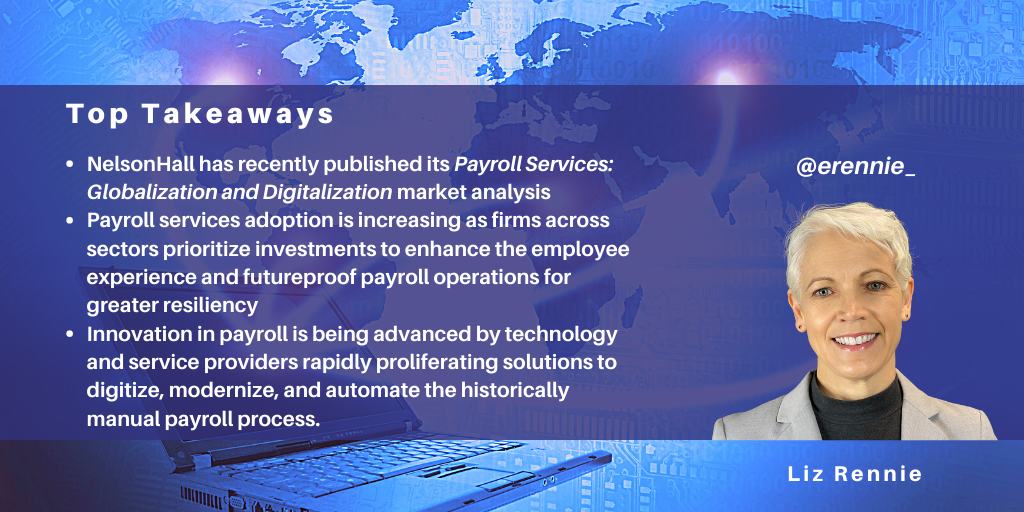
This is Part Two of a three-part blog series covering my perspectives on the payroll market based on NelsonHall’s latest annual market analysis, Payroll Services: Globalization and Digitalization. Part One features the payroll buyer perspective, including the buyer view of the impact of innovation available today. In this part, I look at the managed payroll service providers currently pushing the pace of innovation.
Managed payroll services: providers & solutions to watch
With payroll at the heart of the employee experience (and housing some of the richest and often underutilized data sets in the organization), and taking account of the shortcomings and learnings from the pandemic, firms across sectors are prioritizing investments to futureproof their payroll operations for greater resiliency and empowering its shift from simple processor to strategic center of expertise.
The renewed focus on payroll has managed service providers rapidly proliferating digital solutions to modernize and automate this historically manual, time-consuming process, dedicating on average ~19% of annual revenues toward technology and innovation, with roadmaps focusing on enhancing the user experience (mobile first/only, deeper personalization and augmentation through AI/ML/NLP); enabling digital payment solutions such as on-demand pay; advancing automation toward fully autonomous, "touchless" payroll processing; and enabling deeper predicative payroll reporting and insights.
Here are some of the managed payroll service providers and solutions pushing the pace of innovation in payroll services and technology, which I will be keeping a close watch on as we move ahead.
HCM technology providers
HCM technology providers have gotten serious about payroll in recent years, somewhat creating their own category of payroll solutions. With technology at the core of their business, supported by sizable annual investments to advance their platforms, these providers have brought a virtual ''cannon to a knife fight'' in a historically innovation-starved market. Their technology is powerful, deeply integrated with core HR, time and benefits, and progressing rapidly – placing traditional payroll providers on notice while mutually benefiting those that can integrate and supplement the HCM's capability (most often multi-country providers).
UKG
The newly merged firm (Kronos and Ultimate Software) paired their deep WFM and HCM technologies to form what will eventually become a tightly integrated, comprehensive global workforce solution. The firms also merged their North American payroll services capability and more recently opened their offering to provide standalone payroll. Since loosening their HCM offering, UKG has seen strong growth and uptake for its payroll services driven by its advanced digital payroll capability, not only with full HCM platform adopters, but increasingly as a standalone led by several notable enterprise adopters.
Ceridian
No HCM technology provider is more serious about multi-country payroll than Ceridian. Dayforce is now natively supporting seven countries (U.S., Canada, U.K., Ireland, Australia, New Zealand, and Mauritius), with Mexico and Germany on the horizon. Its recent acquisitions of APAC specialists Excelity Global and Ascender drastically accelerated its multi-country payroll capability and further supports its up-market aspirations. Further, Ceridian's Dayforce Wallet, a native on-demand pay and financial wellness solution enabled by its continuous calculation capability, provides early earned wage access to employees, and supports alternative pay methods, including the Dayforce Prepaid Mastercard. Dayforce Wallet has seen rapid uptake in the U.S., as the EWA trend continues to escalate and is targeted for launch in Canada and the U.K. next (later in 2021).
Paychex
Although not a traditional HCM technology provider, Paychex has quietly developed its FLEX technology into a digitally-focused platform offering that spans the employee journey and punches above its weight in HCM technology maturity, including robust COVID-related workplace tools paired with an expansive, one-stop-shop of modern HR and payroll solutions and services, curated to support the needs of growing small and mid-sized businesses. Examples include comprehensive payroll funding and payment solutions like on-demand pay, real-time payments, same-day ACH, and payroll protection through Paychex Promise, which can extend payroll funding collection by up to seven days.
Multi-country payroll providers
Multi-country payroll solutions are greatly benefiting from advances in digital innovation. Modern cloud platforms are standardizing and centralizing payroll to a single control center and dashboard globally, enabled by integrations or APIs capable of bi-directional data transfer that has enabled real-time, consolidated global payroll reporting. Further, advances in integration have enabled providers to cover the globe, supplementing capabilities through the integration of third-party country engines, enabling support for >150 countries through a single governance model and user experience, supported through increasingly localized delivery models.
CloudPay
CloudPay provides global payroll and treasury services through its digitally-focused, technology-enabled operating model. Through Connect 2.0, it provides a deep set of certified HCM technology integrations, which it continues to expand with additional platform providers. Further, CloudPay offers a full suite of analytics tools that help organizations visualize and understand their payroll data, including benchmarking capability to leverage the collective data of its entire client base (to provide clients with KPIs for benchmarking elements of payroll efficiency against peer organizations). CloudPay plans to launch and roll-out a dedicated mobile app including employee-facing ESS/MSS capabilities, along with expanding its highly adopted treasury and global payments services to offer alternative payment methods, including support for on-demand payroll capability, pay cards, and digital payment solutions.
Immedis
Purpose-built for global payroll, the Immedis platform focuses on unifying payroll to a centralized view globally while driving out traditionally manual activities through digital capabilities like perpetual data validation. The AI-enabled tool identifies gaps in payroll data that impact payroll completion, surfacing data management issues, continuously checking and subsequently validating the data quality and completeness, surfacing gaps in global payroll data for any country in real-time. A recently launched feature leveraging its perpetual data validation is its new Country Specific Information tool (Immedis CSI), which validates country-specific, regional, and local data to ensure all information is up to date and accurate, thus avoiding potential issues during processing.
HR BPaaS providers
Buyers are increasingly looking to payroll providers to take on an expanded scope, seeking to adopt and bundle processes closely linked with payroll. Further, with compliance a key challenge, remote work and talent acquisition spanning the globe, the appetite and demand for localized HR compliance advisory support are steadily increasing, which is inching payroll vendor offerings slowly toward a deeper HRO capability. HR BPaaS providers are well-positioned to support this trend and have opened up offerings to be more flexible in recent years, enabling firms to pick and choose the service components that best fit their requirements.
The HR BPaaS provider group has also pushed hard on technology and innovation investments, seeking to enable a deep digital offering to meet the needs of a wide range of buyers, with a focus on technology-enabled, platform-based offerings, real-time payroll insights, and automation to advance the critical process forward.
ADP
ADP has made sizable technology investments in recent years, leading to its Next Generation HCM and Next Generation Payroll engine, each maturing in digital capability and underpinned by the ADP DataCloud, ADP Marketplace, and ADP Mobile app. The cloud-native Next Generation Payroll engine currently enabled for the U.S., Canada, Australia, and Mexico, will see country localizations for Ireland and New Zealand next. ADP's roadmap will advance its digital pay capability, with support for touchless payments, expanded security for e-payslips, and enabling a native on-demand pay capability within its Wisely solution. ADP also launched a new offering called Roll by ADP, an AI-enabled SMB payroll offering that provides a mobile-first, app-based payroll solution, providing a personalized, augmented experience entirely within its mobile app, for managing payroll anywhere, anytime, and with limited or no experience.
OneSource Virtual
Workday specialist OSV offers full lifecycle BPaaS services exclusively for Workday customers and is now supporting ~40% of the HCM platform's payroll module adopters. With payroll a central component in OSV's managed services offering, it has expanded its client-facing, in-tenant service delivery solution OSVAtmosphere with a set of web apps designed to provide clients with real-time actionable insights at each step of the payroll process through to tax, garnishments, and payroll funding. OSV plans to expand the solution with additional apps due 2021, aligning to its broader HR service offering, which includes dedicated apps for workforce data management, benefits, and COBRA administration. With Workday adoption accelerating outside of the U.S., OSV will enable some of the apps to support clients in Workday-supported countries beyond North America, including a payroll app-enabled for the U.K. and Ireland due in early 2021.
Next week, in Part Three, I will give my perspective on the managed payroll services market's outlook and what to expect as we move forward.
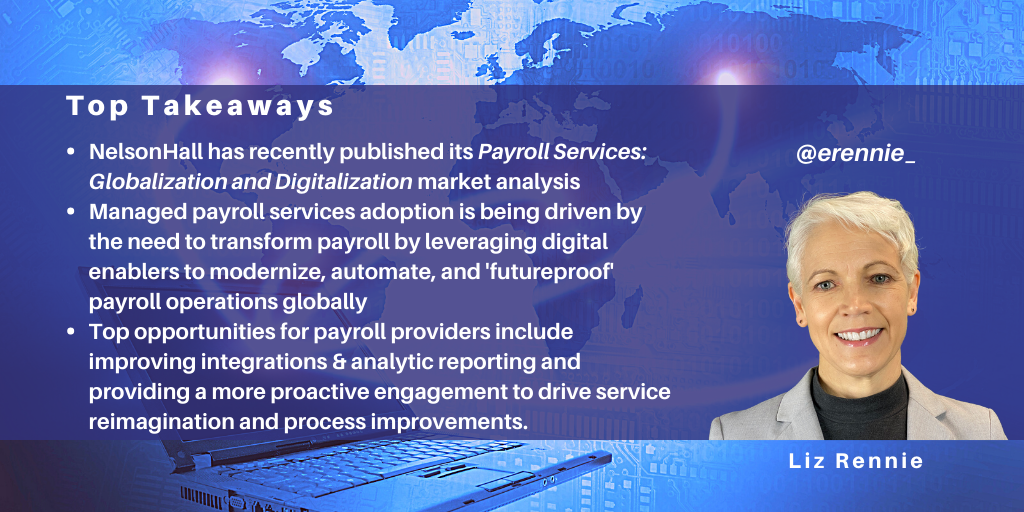
NelsonHall has published its annual payroll services market analysis, Payroll Services: Globalization and Digitalization. The report includes an analysis of two dozen payroll vendors, their offerings, and their buyers' perspectives. The project provided 'behind the curtain' access to many of the major payroll solutions enabling the market today and shaping its path forward.
This blog is a three-part series of my observations from the project and thoughts on what to expect for the payroll services space as we move ahead. Part One features the payroll buyer perspective, including the buyer view of the impact of innovation available today. Part Two continues with a look at the managed payroll service providers pushing the pace of innovation. Finally, Part Three will focus on my perspective on the managed payroll services market's outlook and what to expect as we move forward.
Managed payroll services: buyer perspectives
The past year has seen a renewed interest in payroll as a key transformational area of opportunity for firms across sectors. While many have focused investments and initiatives in recent years toward cloud HR adoption and advancing talent management capabilities, payroll remained somewhat overlooked.
Fast forward to 2021 and payroll is squarely at the heart of the employee experience, with firms realizing that payroll is far more complex, vulnerable, and desperately in need of modern tools to increase efficiency, resiliency and enable the critical process to better support the strategic direction of the business.
85% of buyers interviewed confirmed that payroll transformation was either underway or planned over the next two years for their organizations, with nearly all citing the need for support from managed service providers as they lacked the ability to undertake the transformation alone. With payroll transformation and digitalization in focus and front of mind for buyers, vendor selection criteria (amongst single and multi-country adopters), centered on vendors that can offer proven expertise and qualifications for the countries in scope and enable digital payroll transformation through an affordable platform-based offering.
What has gone well
Collectively, buyers pointed to positive overall satisfaction for their managed payroll services and vendor relationships and further indicated a positive outlook for their solutions to meet their strategic needs over the coming three to five years.
With the marketplace crowded and differentiation often coming by way of the user and client experience, vendors are underpinning offerings with a high-touch, localized expertise that focuses on enabling value for the client and driving long-term recurring revenue retention. Buyers showed high satisfaction with their vendors, specifically pointing to the strength of partnership, flexibility, and caliber of personnel as the top aspects of their relationships.
Further, in recent years, vendors have loosened adoption requirements, unpacking offerings to provide more incremental service options, and filling gaps through integrated partner solutions to meet the unique needs of buyers across sectors and sizes – with buyers pointing to a positive outlook and confidence that their solutions can still meet their strategic needs longer-term.
What can be improved
Despite the innovations of recent years and the work both buyers and providers have done, there is room for improvement. Most notable this year was the appetite for digital enablers to transform payroll, yet commonly buyers were somewhat unclear as to what their provider offered in this regard.
With AI/ML still maturing in the payroll space, many solutions still lack an intelligent technology infusion, with the highest maturity and satisfaction seen amongst the HCM tech platform providers offering managed payroll services. However, buyers commonly lacked understanding of how intelligent technology (AI/ML) can help them automate the complex process, as buyers were often unsure if it was present in their solutions or even offered by their vendors.
Further, two critical components required of modern payroll operations that are surprisingly lacking in meeting buyer expectations center on integration and reporting. Like many aspects of managed payroll solutions, not all integration capability is equal and must be thoroughly vetted and tested – deploying any solution lacking seamless integration (both in-platform and to/from the platform) will negatively impact the user experience and reporting, as it prevents data from flowing freely across the operating model, and amongst key systems. Specifically:
- Integrations: 40% of buyers indicated not using, not needing, or didn't know if their vendor offered integrations to third-party platforms, with about half of those respondents indicating a need to integrate those systems in the future, including core HR in select cases (often a decision by the business to hold off on core HR integration for undisclosed reasons)
- Reporting: Overall, a mixed satisfaction levels; lower-scoring satisfaction was driven by a lack of maturity in the offering or capability, e.g., only offering Excel-based reports or "basic functionality" lacking in analytic insights, visualizations, or graphical representation. In select cases, buyers choose to conduct payroll reporting outside of vendor solutions, likely leveraging third-party reporting tools or platforms to supplement the lack of vendor capability.
Further, buyers pointed to a clear opportunity for vendors to support them with process reimagination of payroll service and processes. Those citing lower satisfaction pointed to a lack of proactive engagement by their vendors for continuous process improvement. While technology innovation has undoubtedly helped, more can be done to engage buyers with new solutions, tools, and methods for addressing their unique requirements. As with the feedback on digital enablers, there is also a gap in buyer understanding of what vendors can offer and what is possible in terms of payroll transformation and process reimagination.
Vendor opportunities
Buyer lack of strategy or change management plan
In reviewing feedback from both vendors and buyers, there is a clear gap in payroll transformation strategy that puts both parties in a poor position from the start, particularly for multinational firms seeking to enable global payroll transformation. Buyers are often setting out to transform payroll with a limited or no strategic plan, assuming that adopting a particular solution or vendor model will instantly transform payroll. While this can certainly move the payroll operating model forward, it must be accompanied by a clear strategic path and underpinned by a comprehensive change management plan. I often see buyers deploy the latest solutions (across HR towers) without doing the uncomfortable work of shifting habits and adopting the solution's full potential, only to find that they didn't transform after all.
While payroll vendors have expanded offerings in recent years to include front-end advisory and business case support, change management is often a key element lacking and generally isn't a core competency or service offered by payroll providers. This is an area I think vendors have to do better in supporting buyers, as it benefits both parties over the long term.
Process reimagination and innovation
A key area of opportunity that resonated across buyers and was evident amongst vendors across geographies and solutions was the absence of ongoing, proactive process improvement and service reimagination. Buyers commonly pointed to an appetite for deeper proactive engagement and consultation by their vendor post go-live. Capabilities like design thinking and proactive outreach to introduce and incorporate new innovations and tools into client programs are lacking. Many buyers simply didn't understand what their vendors could offer or how it could be leveraged to meet their specific needs and maximize the value of the relationship.
Payroll service providers can look to HCM technology providers as a model for how this can be improved. The HCM technology firms do an excellent job of staying closely and deeply engaged with their user community, assessing their engagement, satisfaction, and monitoring usage of their systems to proactively help clients maximize the value of their investments and drive the transformation they seek.
They also do a great job of enabling communication channels between vendor and client as well as client to client. This open collaboration leads to the platform community driving its future through steady user feedback, thereby shaping significant portions of the roadmap and enabling direct impact for users for the challenges they face daily; further solidifying the partnership; boosting the investment in the success of the platform for all parties; and driving long-term recurring revenues.
Part Two continues with a look at the managed payroll service providers pushing the pace of innovation.
]]>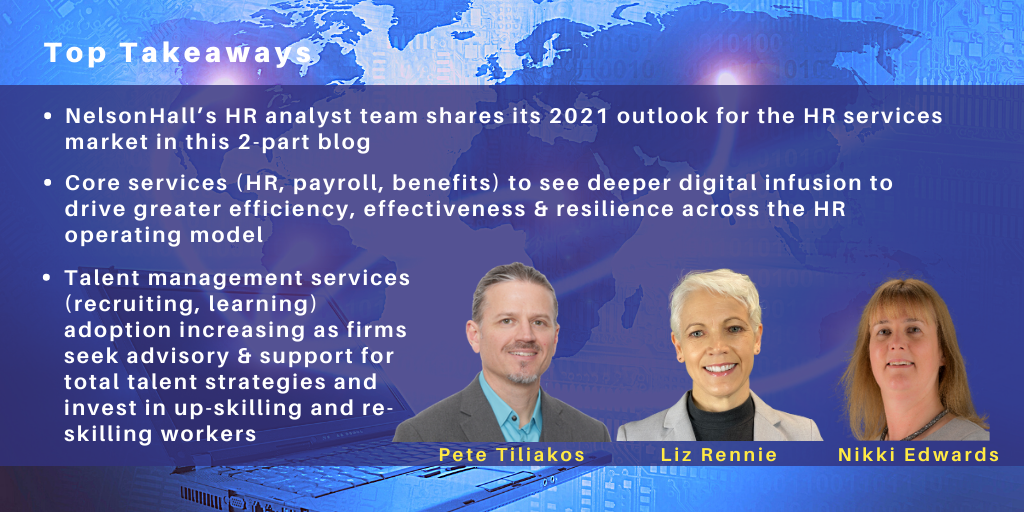
This is the second part of a 2-part blog presenting an analysis of key trends from NelsonHall's HR Technology & Services team. Here, Nikki Edwards looks at talent management services, including recruitment and learning services.
Recruitment Services
RPO and CWS/MSP vendors shone in 2020, as they supported their clients through their COVID-19 challenges, adding another dimension to an already-complex picture of Talent Acquisition (TA) trends. Vendors initially advised on digital tools to enable remote hiring and onboarding of talent, and broader services around working from home, keeping safe, and maintaining wellbeing.
This was immediately followed by vendor taskforces re-allocating resources to meet organizations’ urgent hiring ramp-ups (particularly in healthcare, pharmaceuticals, and food retail), while supporting clients who were scaling back or needed a different modus operandi. The year closed with recruitment vendors supporting their clients with mid- to long-term TA planning, as remote, and digital hiring and working were becoming the new business-as-usual.
Outlook
While organizations focus on essential hiring in 2021 amidst economic uncertainty, and realize they cannot single-handedly navigate the rapidly-evolving TA trends and ongoing pandemic challenges, they will reach out for third-party vendor support to help them strategize and execute plans to ensure they are hiring-fit and work-fit for the future. As vendors continue to evolve their TA solutions (services and tech/tools), they will also contribute to advancing key TA trends:
A total talent/holistic approach to hiring. NelsonHall research in 2020 showed 90% of major enterprises interviewed recognize the need to embrace a holistic approach to talent acquisition, comprising full-time/permanent, contingent, and internal talent (the latter having been somewhat neglected to date).
Organizations are considering using contingent workers (such as freelancers and gig workers) over full-time/permanent workers to avoid long-term employment costs. Vendors already offering total talent solutions are in a stronger position to support them, as they can vary the proportion of each delivery channel based on changing demands and relocate resources accordingly. With the need for worker compliance intensifying, giving organizations better visibility of data/insights concerning their internal talent is a growth area, closing the gap on this under-used talent pool.
Building talent by upskilling and reskilling organizations’ workers. On the one hand, organizations will continue to seek talent which is in short supply (for example, digital skills, other niche STEM skills, some trades skills). Yet on the other, those organizations will face the reality of skillsets being augmented or replaced by automation, requiring affected workers to be upskilled or reskilled in new areas.
The ‘build’ element of the buy, borrow, build, and bot approach to TA has never been so important. The COVID-19 pandemic highlighted how organizations’ digital skills fell woefully short of what is required for 2021 and the need to address this (notably in areas from basic use of collaboration platforms to advanced cybersecurity). All recruitment vendors will play a role in skills development and embrace the opportunity uniquely according to their client base and their specific needs.
Expansion of talent advisory services. With a more highly distributed and flexibly working workforce here to stay, RPO and CWS/MSP vendors will expand their portfolios to offer services around the future of work. This could encompass the evolution of employer branding/recruitment marketing services pivoted to focus on compelling EVP building – showcasing/storytelling values demonstrated by client organizations through the pandemic.
Opportunities abound in areas beyond TA, encompassing broader HR and organizational issues. Consulting will cover working with a fully-remote, globally spread workforce (covering topics such as tech/tools, employee communications, employee engagement, workforce wellbeing/safety (shielding), workplace redesign, to business continuity planning and building corporate resilience).
Next-generation platforms/tools. In readiness for the new era of work, recruitment vendors will continue investing in data, AI-based predictive analytics (for example, the impact of automation on skills augmentation or replacement), intelligent automation (looking at workflow bottlenecks), niche human clouds, and learning tech (for reskilling/upskilling). Also, chatbots, voice-enabled tools, the use of AI for resume parsing, candidate matching, and assessments will continue apace.
Learning Services
In 2020, Learning Services vendors supported clients in digitalizing in-person training content for cloud-based peer-to-peer platform delivery in a bid to continue essential training (for employee onboarding and business compliance needs). Vendors saw increased demand for specific skills training, notably digital skills and reskilling for COVID-19-specific healthcare/pharmaceutical initiatives. Within a few months, vendors were supporting clients in choosing the most appropriate modalities for delivering learning digitally, whether via simple videos or animation, for example. Although there was some return to socially-distanced classroom training at the close of 2020, organizations recognized that digital learning solutions and updated skillset training were going to be the priority for 2021 as geographically-dispersed, remote workforces become the long-term norm.
Outlook
Organizations will continue to have reduced training budget spend in 2021, until the economic situation improves in a COVID-19 vaccinated world. Vendors must maintain/increase support for their clients as they navigate further challenges, which may include the downsizing or removal of in-house learning teams, while ensuring their employees learn in a safe, collaborative environment, cognizant of pandemic-induced restrictions. Vendors will continue with their planned developments in services/learning tech/tools driven by existing PESTLE factors, yet also advance several learning trends:
Digital/virtual modalities for geographically-dispersed/remote workers. Priority will be on blended learning (with a significant proportion of VILT to enable most learning to take place remotely, with any return to in-person learning reserved for final skills demonstration/reinforcement), and eLearning. Learning will be in bite-sized chunks, embracing engaging modalities to drive self-service pull versus push learning. Such modalities will include video, animation, gamification, simulation, virtual reality (VR), augmented reality (AR), and alternate reality.
Curated content over created content. Learning Vendors will continue to curate content (where there is an abundance of ready-made material available), as organizations seek quick fixes to plug gaps in their content libraries. Created content will remain popular for niche/specialist content, where it is tailored for a specific organization or product, or for compliance reasons.
Learning tech/tools (including tech admin). Augmenting organizations’ existing LMS/LXPs/HCM learning modules with other platforms/tools to enhance the learning experience will expand vendors’ ecosystems. Platforms will include curated content, extended reality, EPSS, microlearning, rapid authoring, and alternate reality. Mobile learning, learner data/analytics, and learning systems admin will continue to grow in importance.
Other services. Consulting services will expand to focus on digitalization of learning (including tech/tools advice as above), driving learner engagement, and reskilling/upskilling, based around the new organizational structures of the future. Administrative services may increasingly focus on third-party learning vendor management, for example, as procurement teams shed administrative duties, and traditional classroom support diminishes in importance.
In Part 1 of this blog, Pete Tiliakos & Liz Rennie look at the key outsourcing trends around core HR functions, including cloud HR transformation, payroll, and benefits administration services.
]]>
Part 1 by Pete Tiliakos & Liz Rennie
This is Part 1 of a 2-part blog presenting an analysis of key trends from NelsonHall's HR Technology & Services team. Part 1 looks at the key outsourcing trends around core HR functions, including cloud HR transformation, payroll, and benefits administration services.
Cloud HR Transformation Services
The drive to digital has kept many cloud HR transformation projects on track, despite some large enterprise signings being delayed. The 2020+ HR challenges look different from those in 2019, with organizational challenges related to workforce safety, workforce productivity, security, cost containment alongside deepening cost pressures, and a need to ensure all processes are digital. Pivotal to success is the agility of HR organizations to drive restructures supporting significant market upheavals across so many industries. Adapting to rapidly changing and compliance needs will also be a challenge.
Cloud HR transformation services are adjusting to a FluidWorkLife era, defined by greater people engagement to support fluid, individual work and homelife needs in a consumer-like way – while addressing higher-speed digital deployment through improved use of automation and technology to better manage the pace of business change and industry consolidation.
Outlook:
Key themes and drivers expected from the Cloud HR Transformation Services market in 2021+ include:
- Managing workforce restructuring and HR & payroll compliance: with unprecedented layoffs and furloughs, in contrast to significant growth in industries such as online shipping, couriers, and communications, HR has played a key role in supporting the business through change. Ensuring timely, accurate, compliant payroll was the top operational priority in 2020 and will remain critical moving ahead
- Workplace tools to support workplace change: with employees working from home, a greater focus on worker tracking to support a safe return to work, enabling touchless workplace services, monitoring social distancing interactions, and supporting contact tracing
- Effective employee engagement is table stakes: employees will have diverse needs and individual personal demands, requiring greater HR flexibility, including where employee solutions might need to be co-created. Enabling tools such as HR chat to support improved engagement will increase in importance, plus more regular employee surveys or pulse-checks
- Security is increasingly important, with more cyber-attacks evident during 2020
- Greater resilience through cost improvements, digital processes, and agility are also key to HR delivery models. Priorities are expected to focus on solutions that help make workforces more resilient, including employee health, voluntary benefits, risk, and cost. Companies will be looking for greater agility for changing business needs. In the light of COVID-related revenue and cash flow challenges across many industries, it is expected there will be a greater focus on delivering longer-term cost improvements.
Payroll Services
This past year has been a stark wake-up call for many organizations and their payroll operations. The effects of the pandemic strained and exposed operating models up and down market, leaving many firms across sectors realizing investments to futureproof payroll operations for greater resiliency can no longer wait.
At the same time, 2020 has been payroll's 'time to shine', with practitioners stepping up to answer the call and keeping workers around the globe paid on time and accurately during arguably one of the most challenging times in recent history, despite the shortfalls in capability.
On the managed services front, the shift to work from home enabled payroll providers to put their digital technologies to the test, proving out the very solutions they had been proliferating in recent years and urging buyers to focus on: cloud platform adoption, mobile-first design, on-demand payroll capability, predictive analytics, and dynamic integrations that bring it all together seamlessly. Additionally, firms operating in managed payroll services arrangements had much-needed help in quickly accessing reliable data, interpreting and responding to compliance directives and government support programs, and they fundamentally fared better in navigating the unforeseen challenges, reinforcing the value in managed payroll services.
Outlook:
While payroll service provider revenues were negatively impacted by the global economic downturn and subsequent job losses, and buying decisions were put on hold, the appetite for digital payroll solutions and managed services is quite healthy and is escalating as we move into 2021.
With payroll a critical, core element in the employee experience, global footprints creeping, and compliance risks rapidly intensifying, buyers are keenly focused on payroll as a key area of investment moving ahead, and thus service provider pipelines are healthy, signaling a gradual return to the growth levels experienced before the pandemic.
Five key themes and drivers expected from the managed payroll services market in 2021+ include:
- Compliance is THE priority: quite possibly the leading driver for managed payroll services adoption today and one that will intensify as we move forward; buyers will focus on tapping into the tools, localizations, expertise, and global capability that vendors can offer at scale in removing risk and ensuring complete and timely compliance as statutory requirements evolve
- Digitalization up and down the process: no process in the employee lifecycle has been historically more neglected or overlooked than payroll. Vendors will continue leveraging cloud platforms as the launchpad to enabling deeper digital capabilities with a heavy emphasis on automating the highly manual process through RPA, AI, and ML infusion, inching toward eventual fully autonomous processing. With payroll sitting squarely at the heart of the employee experience and wellness, look for deeper mobile capabilities, expanded use cases for AI/ML, and NLP-enabled virtual assistants that augment users and personalize experiences with guided, predictive insights to drive best practice and data-driven decision making
- On-demand earned wage access will be a game-changer for payroll: if the pandemic taught us anything, it's just how vital and impactful the ability to move earned wages to employees in a timely fashion can be. With the employee experience, engagement, and wellness top of mind for HR leaders, on-demand payroll capability helps with each by empowering employees with greater control and insight over their earnings. Look for the solution to continue its hypergrowth trajectory with adoption led by the U.S. and Canada, but increasing slowly internationally
- Payroll becomes a strategic partner: payroll has long been viewed as a simple processor and cost center, often overlooked in key HR decision-making or strategic decisions. Yet payroll controls one of the most critical processes in the employee lifecycle and houses some of the most underutilized and generally misunderstood data sets in the entire organization. With the continued proliferation and criticality of globally consolidated predictive analytics, and benchmarking capabilities, pared with the advancements in digitalization, payroll has the opportunity to truly shift its focus toward becoming a strategic advisor to the business
- Multi-country deals will escalate: with many MNCs operating on legacy, disparate, and often poorly integrated payroll solutions globally, the appetite for consolidating and modernizing global payroll remains strong, particularly with many firms finding their global operating models ill-equipped to handle the next major disruption. With multi-country payroll solutions able to support 100+ countries on average, look for buyers to tap into vendor offerings that can consolidate, digitalize, and automate payroll globally through a single solution.
Benefits Administration Services
Benefits administration providers have continued to focus on expanding benefits offerings to tailor to specific needs, while also minimizing administration by improving processes and technology. Significant changes in the way of working have also impacted the industry. Over 2020, benefits fairs were managed online, a first for many. As a result of the pandemic, technology is the driving force to innovation, with greater focus on homegrown platforms or through managed acquisition and tighter partnerships to support ongoing changing needs and client needs for greater visibility of data.
Buyers of benefits programs continue to expect greater flexibility to support change, greater automation, customizations of communications, and improved process efficiencies.
As government relief packages introduced by most major governments greatly impacted health provision and benefits rules, operations had to adapt quickly to apply these changes. As a result, 2020 was a year of increased operational costs for many benefits administrators.
Outlook:
Key themes and drivers expected from the Benefits Administration Services market in 2021+ include:
- Automation and integration: benefits operations will become more streamlined with greater integrations, minimizing risk and manual interventions
- Health costs are increasing in the medium to long term: costs might have reduced in 2020 due to a lower number of medical claims; a high-cost spike is expected in 2021 due to pent up demand for health services
- Keeping up with relief legislation has been challenging, and more changes are expected in 2021: The dynamic nature of the benefits markets will mean more buyers will look to expert providers for guidance and support and bringing greater agility to support compliance
- Compliance, security, and risk management will have growing importance: especially while more processes moved online and electronically, and as companies capture more data about their employees
- Personalization through AI will grow alongside company ethics and brand as it relates to benefits design. AI will increasingly support benefit recommendation engines; personalization will also increase through more fine-tuned communication tools
- Benefit design will have a growing importance in promoting diversity in workplaces and representing the company brand
- Benefits professionals’ roles will change to become more marketeers to communicate benefit programs and be less about interface/error management and processing
- Industrializing and institutionalizing analytics: increasing use of data to support and evaluate program success, employee engagement, cost management, and drive more informed decision making.
In Part 2, Nikki Edwards will look at trends and the outlook for talent management services, including recruitment and learning services.
]]>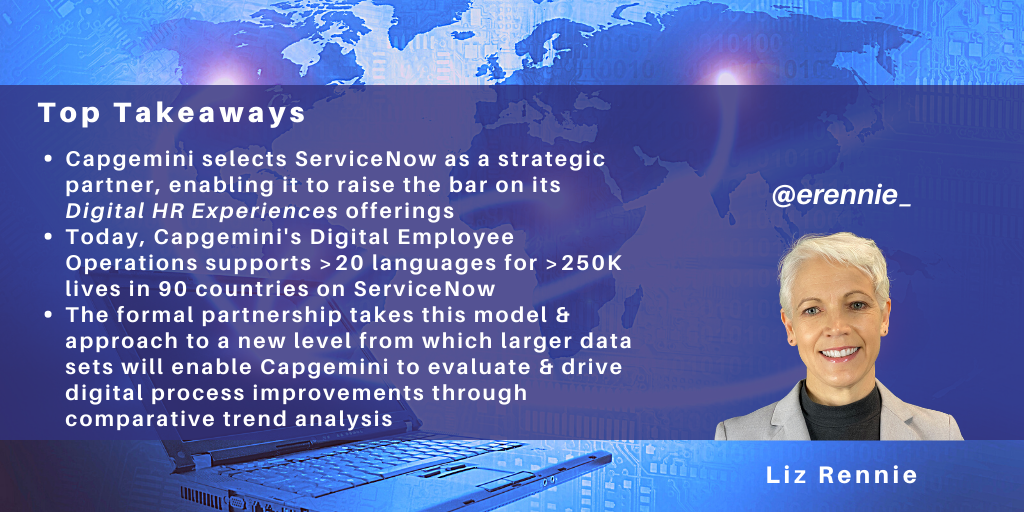
As expectations of what is possible in the digital world have grown exponentially, Capgemini is aiming to close the widening gap between consumer experience and employee experience. It is looking to digitalize workplace interactions while keeping the warmth, emotion, and uniqueness underpinning company culture.
It has built a Digital Employee Operations (DEO) practice over the last four and a half years, which brings customer service to a new level in the field of HR. DEO aims to bring everything into one place: knowledge, help, and information through a "one pane of glass" digital window.
This is only possible through tighter technology partnerships which support more robust integrations with more industrialized processes and more standard services.
What's New?
In 2020, Capgemini selected ServiceNow as a strategic partner for its digital employee operations. Importantly, this is not positioned as a call center. Its Digital Employee Operations clients use a digital-first strategy.
ServiceNow brings a case management platform designed for HR with a prebuilt data structure that is HR-centric, combined with prebuilt security. One of the differentiating features is that this product enables not only service agent interactions, but employees can interact and collaborate across the organization; for instance, product enabling managers and employees are able to engage on a case.
Before reaching this partnership, Capgemini supported operational customers in its DEO practice with the ServiceNow platform for a number of years. Its first ServiceNow customer was AECOM, which went live in Q4 2018, and it has built a significant practice over the years. Today, Capgemini's DEO supports more than 20 languages for more than 250K lives in 90 Countries on ServiceNow. The formal partnership now takes this model and approach to a new level.
Applying chatbots in HR and adoption levels
In Capgemini, chatbots have a high adoption rate, with ~20% of its clients leveraging or launching virtual agents/chatbots. Chatbots offer iterative functionality, and Capgemini sees varying deployment approaches across clients.
Some add a virtual agent/chatbot alongside live human chat support. This expedites the learning process for a bot by having a log of live interactions to drive and map intents and responses accurately to employee queries. An alternative approach is where there is no history of live chat. As an input, the bot simply requires more effort and assumption in intents and interactions. This approach involves more humans validating questions and answering questions the bot could not address.
Why a strategic partner?
Having selected a dedicated human resources “hire to retire” services solution, Capgemini can now drive larger benchmarking data sets to evaluate process improvements through comparative trend analysis. Benchmarking is critical for a mature operation that looks for a competitive advantage. Capgemini offers benchmarking in two ways:
- Sharing of knowledge and experiences learned across clients to benchmark what is leading practice, and applying and sharing lessons learned and continuous improvements across clients
- External benchmarking against non-DEO clients less than 15% of its current client base have engaged with that additional offer.
NelsonHall Viewpoint
Its first truly joined-up DEO contract on ServiceNow was 12 months ago. Over the next three years, NelsonHall expects a service approach to HR transformations will be increasingly important as organizations look for more than just an HCM technology deployment and/or support partners. Organizations will likely look for more robust and holistic service-based HR business cases to ensure savings and ROI are achieved through end-to-end digital transformations. They will likely increasingly assess their own operational capability to drive the change to achieve a digital-first approach to help drive more consumer-like HR services.
Although many organizations have leaped to mobile-first employee experiences through HCM platform deployment, few have addressed the experience of inquiry support and how HR operating models and interactions need to uplift. Rather than treating this as an afterthought, proactive HR directors with ambitions to reshape companies in 2021 are expected to evaluate service delivery models on a more holistic level, looking more at people and digital and how they come together through technology.
Capgemini's offering maturity is evidenced by the fact it now has 30-40 pre-packaged HR services and a deep service partnership with ServiceNow. This puts it is in a strong position to take this maturity to the next level of sophistication.
]]>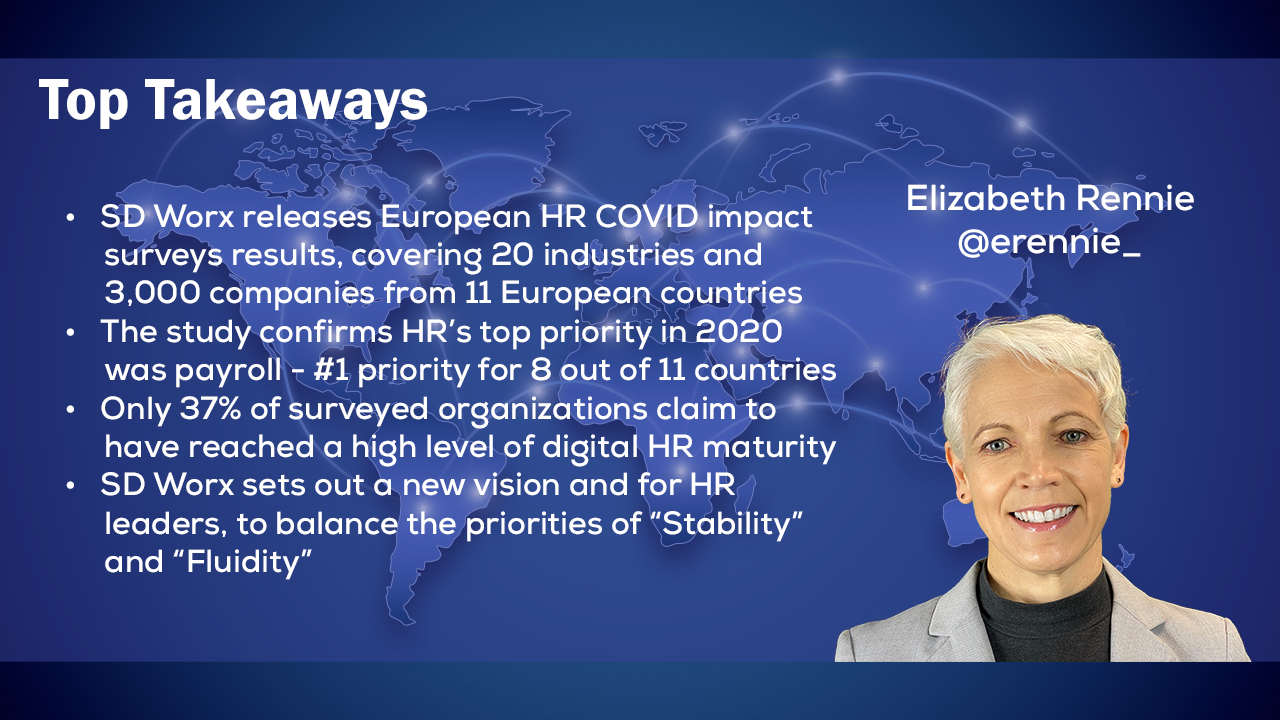
Like many HR service providers, SD Worx has been supporting its clients over the last six months by continually making updates to the changing legislation and dealing with client queries and operational challenges. SD Worx also launched a study to better understand changing market needs, the findings of which have just been published. The SD Worx study was one of the most extensive European HR COVID impact surveys, across 20 industries and 3,000 companies from 11 European countries, and it found that the highest HR priorities in 2020 are operational, administrative tasks. As part of its thought leadership white papers, SD Worx has also set out a new vision for HR, to enable clients to balance “Stability” and “Fluidity”.
Key study findings
The study confirms HR’s top priority in 2020 was payroll. When asked, “What priorities or projects do you have (or plan to have) within payroll and HR?” the option “To ensure smooth, efficient payroll calculation and payment” scored the highest (#1 priority for 8 out of 11 countries) across 19 different options covering all aspects of HR. Payroll has never been more valued than in times of crisis; payroll administrators are “essential workers”.
So, when will things get back to normal? Nearly half of European companies surveyed were convinced that COVID-19 would have a lasting impact on their business. We will have to radically change the way we work (together) after the crisis. However, the HR study finds that HR directors rate their level of digital maturity as low: only 37% of surveyed organizations claim to have reached a high level of digital HR maturity. So, as many lives and business models have been disrupted, HR agility has never been more important.
The SD Worx study showed that the top three areas companies look at to leverage external specialists and outsource service providers are:
- HR process automation
- Regulation expertise
- Digital transformation.
Other insights from the study demonstrate that besides payroll and HR services and performance, many European country priorities were as diverse as they are homogenous, something seasoned European HR directors are not unfamiliar with. As well as reflecting cultural priorities that might result in different priorities, NelsonHall expect the variations also be partially due to the timing of the different countries' COVID responses. The study was conducted over the month of June 2020 and during this month, many European countries were at a different stage of their COVID19 responses. The impact of the crisis was just starting to be understood and realized. According to most countries surveyed, the three areas that were the lowest priority were HR policy, reward, and contingent workforce.
Employee experience has been a common theme of many HR strategies over the last few years, and many still aim to optimize the employee experience better. With so many employees now working remotely, the employee experience and employee engagement are more critical than ever before and require modern technology to keep employees connected while ensuring timely, accurate, real-time information, and facilitating reliable outcomes throughout the HR delivery model. The SD Worx study showed ~60% of employers are still actively trying to improve the employee experience, either with existing projects or projects planned over the next 12 months. SD Worx defines employee experience as the digital workplace experience and cultural & inter-personal engagement as well as the physical work environment. SD Worx recognizes a trend towards more personalization in HR, with almost half of companies having “flex reward projects” in progress or planned within the next 12 months.
SD Worx response
In response to the HR study, to meet European countries' needs across such a wide range of industries, SD Worx set out its HR service vision. Its vision is to bring stability to HR services alongside a fluid offering, enabling each company to find its own optimal balance. The concepts of stability and fluidity are outlined below as well as some examples of how SD Worx addresses these:
Stability is defined by SD Worx as:
- Future-proof HR tech: SD Worx offers cloud-based HR/payroll technology offerings in the core markets of the U.K., Ireland, Benelux, France, Germany, Austria, and Switzerland
- Efficient HR processes; SD Worx recently developed its HR SME digital services platform “SD Worx Buddy”, piloted in Q2 2020 in Belgium. Frictionless tools: SD Worx launched its mySDWorx app for absence, expenses, payslip, internal communications, and a FAQ for HR. It has over 160K installations It uses machine learning to determine the ten most asked questions and is tailored to the client's database. It supports conversations designed for the employees (not for the process). Over 2019 it has rolled out an onboarding assistant to capture more employee data; now released in Belgium and UK, and the next country onboarding to be developed is Germany.
Fluidity is defined by SD Worx as:
- Personalization: SD Worx enables personalized remuneration packages through its reward cloud platform. This lets employees tailor their reward components with voluntary elements. Helping employees to value their rewards can not only boost motivation but also complement a cost-efficient overall reward policy
- Empowerment: SD Worx empowers organizations to be proactive and adapt to fluctuations in the workloads through its workforce planning offerings. It takes each employee’s qualifications, availability, seniority and other requirements into account which could be fulfilled by permanent or flexible staff, through the SD Worx Flexible Staffing solutions
- Autonomy: SD Worx solutions support personalized training trajectories, enabling organizations to boost employee engagement, performance and giving them greater autonomy.
For those who want to get more in depth insights on the research, SD Worx is creating a series of publications that will be published on the SD Worx platform (link). These are the first:
- Payroll: highly valued, hardly optimized
- HR, fluid as Hula-Hoop shaking (publication end of October, webinar at Unleash)
Also foreseen are ebooks on Workforce management and on Digital HR and Employee Experience.
The themes of SD Worx’s vision align well with the benefits Cloud HR transformation buyers look to achieve, according to NelsonHall’s Cloud HR Transformation Services market analysis report. According to the NelsonHall report, the top three were improved compliance, simplified and modernized technology, and improved employee experience. In 2020 and following the pandemic, it is evident that improving employee experience as an HR objective is not disappearing. Its definition and the height of the bar is being raised, moving beyond the realm of just a mobile app offering, as vendors strive to deliver more frictionless and efficient offerings.
]]>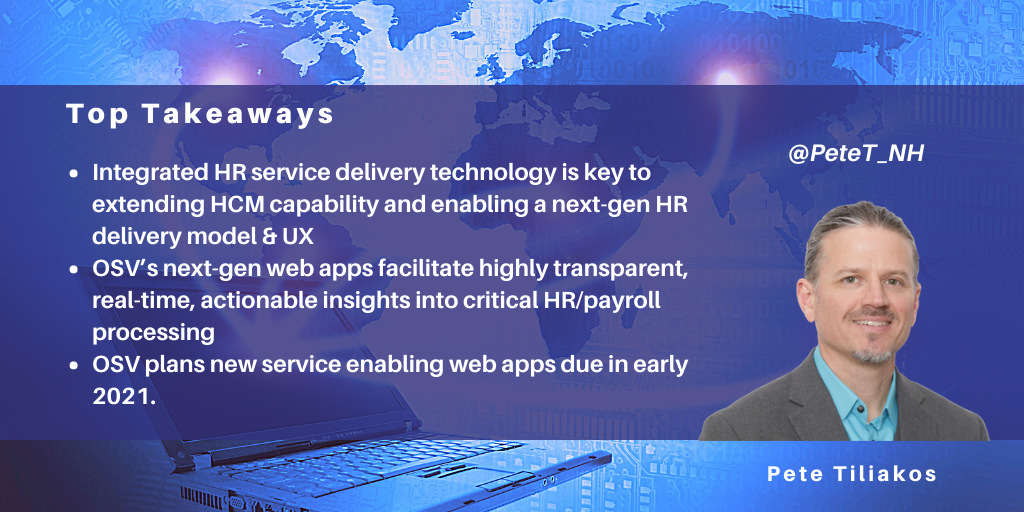
The recent impacts of the COVID-19 pandemic exposed many HR and payroll service delivery models as being unequipped and unprepared to pivot to remote work, access the data needed to obtain government support, and move money to employees in a timely and compliant fashion. The pandemic also accelerated an already intensifying push toward digital HR and payroll adoption, particularly as the “work from home” response has turned into the “work from anywhere” norm.
With so many employees now working remotely, the employee experience and employee engagement are more critical than ever before and require modern technology to keep employees connected while ensuring timely, accurate, real-time information, and facilitating reliable outcomes throughout the HR delivery model.
While cloud HCM technology remains the vehicle for HR digitalization, existing solutions often lack the ability to support the HR service delivery function in-platform. Thus, integrated HR service delivery technology is key to extending the HCM capability and enabling a next-generation delivery model and user experience, one that facilitates critical HR support activities in real time, such as knowledge and inquiry management, document storage, process monitoring, and automation.
As a result, more organizations across sectors are considering managed HR and payroll services as the lever and pathway to modernizing their HR delivery models and advancing their digital capabilities, tapping into the innovations HRO providers have proliferated in recent years in preparing for the “future of work.”
Here, I take a look at how HR and Finance BPaaS provider and Workday specialist OneSource Virtual (OSV) is leveraging its proprietary service delivery technology, OSVAtmosphere, to differentiate its managed services, providing its clients access to the types of next-generation apps required to enable a resilient, modern HR service delivery model and user experience.
OSVAtmosphere
In line with its mantra and branding, "Make the day more doable", OSV maintains a relentless focus on supporting its clients with integrated solutions that maximize their Workday investments while elevating the HR service delivery experience.
OSV enables its service delivery in support of ~800 clients through OSVAtmosphere, which provides real-time, in-application service delivery capabilities leveraged by OSV resources on the back end for HR and payroll process administration, as well as by its client administrators on the front end. This is key, as both the client and back-office OSV resources remain in lockstep in real time throughout key processing and service delivery activities, enabling OSV to operate as a tightly integrated extension of the client's HR delivery team.
For its client-facing OSVAtmosphere solution, OSV has developed a bundle of web apps aligned to its core managed services offerings (HRO and FAO). With >500 of its clients adopting its managed payroll services, OSV has focused its recent app development around providing its clients with real-time actionable insights at every step of this critical process through to funding.
OSVAtmosphere currently offers five fully responsive web apps that include support for the following processes:
- Payroll: a centralized control center for end-to-end payroll administration (on and off-cycle), providing client administrators real-time, in-flight updates and push notifications on the status of their payroll(s) as it progresses through the entire cycle, up to employees receiving their pay-slips
- Tax: provides a control center for tax liabilities and remittance processing. Post payroll submission, the necessary tax data, and details are automatically drawn into Atmosphere from the client tenant, providing full visibility into tax activities conducted by OSV on behalf of the client. Clients have access to both summary and detailed tax jurisdiction details with drill-down capability for more in-depth analysis and actionable insights, designed to identify downstream exceptions and errors for proactive client notification and resolution, with correspondence capability in-application. OSV has also enabled the Tax app in support of COVID-19 compliance activities, providing clients with access to details and insights into deferred tax codes, deferred tax liabilities, federal tax credits, and supplemental form data
- Garnishments: enables real-time visibility into the fulfillment and payment side for client garnishment orders and wage attachments across their workforce. RPA and OCR technology automate the loading and interpretation of court orders, as well as the remittance of outgoing letters and payments, including electronic copies attached to the client Workday tenant for reference, resulting in a near touchless process
- Treasury: provides clients real-time visibility into the timings/deadlines for payroll liability funding and money movement, including activity details and historical check registers for identifying cashed and uncashed checks
- AP Invoicing (for FAO clients): provides clients real-time visibility into their invoice coding and supplier updates to drive invoicing accuracy. The app includes the ability to code and search by keywords, to pinpoint line items within Workday finance, with the ability to code by keywords as well as other standard factors.
Roadmap and future apps
As a central technology to its service delivery and omnichannel support model, OSV is focused on deepening OSVAtmosphere's capabilities and continues to invest in roadmap initiatives that will produce additional next-generation apps.
OSV has plans to expand the solution with additional apps due in early 2021, aligning to its broader HR service offering, which includes dedicated apps for workforce data administration and maintenance and benefits and COBRA administration services, including apps for both client administrators and employees.
With Workday adoption accelerating outside of the U.S., OSV will enable some of the apps in support of clients in Workday-supported countries beyond North America, including a payroll app enabled for U.K. and Ireland due in early 2021. (OSV's Treasury service is not currently offered outside of the U.S. and Canada.)
Aside from continual UI/UX enhancements, OSV also plans deeper collaboration and correspondence capabilities between the client and OSV across all of its process apps (similar to its Tax app capability) to boost communication and speed issue resolution. It also plans on expanding its back office automation through RPA, which is already present against several critical payroll use cases.
Longer term, OSV plans to explore the infusion of AI in OSVAtmosphere to address key use cases and drive deeper predictive capabilities, as well as adding KPIs for potential benchmarking and process improvement insights and recommended actions.
]]>
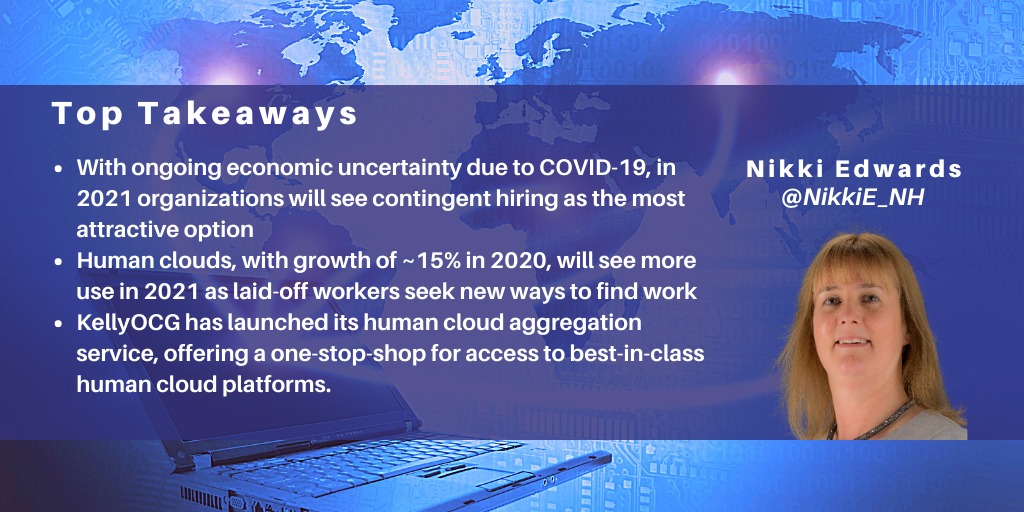
Quarterly financial reports for 2020 (April onwards) from recruitment organizations show that in a COVID-19 world, temporary hiring is more resilient than permanent hiring, faring on average about 10-30% better (albeit both types of hiring are seeing negative growth overall). Meanwhile, gig work has increased on average 10-15%, over the same period. These figures are not surprising as organizations undertake recruitment that minimizes labor cost risk. And, in 2021, with the economic situation likely to be the same as 2020, organizations will want to maintain flexibility with their workforce, making contingent hiring the most attractive option.
With a multigenerational workforce demanding more flexible working arrangements (avoiding the 9 to 5, choosing working hours, characterized by freelance or gig work), now is an ideal time for organizations to embrace a holistic (total talent) approach to talent acquisition. Organizations have also demonstrated their resilience in embracing technology/tools to enable remote working. So, now is the time for organizations to combine the two: using additional technological channels to find the flexible skilled workers they need to get tasks done, while minimizing labor cost risk in an economically challenging market.
Human clouds, where task-specific jobs, projects or gigs are carried out on demand from any location, using an online/digital platform, have seen a growth of ~15% in 2020 over 2019. And they could see a further uptick in use in 2021 as workers laid off due to the COVID-19 pandemic seek new ways to find work.
Challenges in determining the most suitable human clouds
At first glance, there are potential challenges in determining the most suitable human clouds to use, when:
- There is a choice of at least 1,800 online recruitment platforms/human clouds (KellyOCG, 2020)
- Some advertise a broad range of skills, while others are highly niche. How do you know which ones are most suitable for hiring specific skillsets?
- There are choices on human cloud/platform types: organizations would likely seek candidates by entering a direct legal relationship with an individual worker, using an online marketplace platform such as Toptal. But another option is to use a crowdsourcing platform, where several workers bid for, then independently work on, specific elements/constituent parts of a project. 99designs is an example of such a platform. In another example, restaurants refocusing their business for online delivery may use a service platform such as uber eats to seek drivers to deliver takeaway food to the public
- These marketplaces operate in their own environment, with their unique ecosystem and end-to-end process
- For procurement, it is an expensive way of getting labor (by paying separately for resources on different platforms).
One vendor that has addressed these potential challenges is KellyOCG.
KellyOCG’s one-stop-shop solution
KellyOCG has recently launched its human cloud aggregation service, offering a one-stop-shop for access to best-in-class human cloud platforms. Initially offered as part of its MSP/CWS offering, the service fills the gap in its holistic/total talent acquisition offering. The service combines human support underpinned by technology.
The Kelly Human Cloud technology (co-developed with Avature) automates and consolidates the process steps and harmonizes the profile information from each human cloud (with their unique profile formats). Some platforms involve going through a mini RFX process, where freelancers bid on the work to be done. Other platforms have a white glove hands-on approach, with a consultant that understands the requirements and finds the talent. The platform links to the organization’s VMS, enabling the hiring manager to review worker information and manage the project via the most appropriate human cloud. The system integration allows an organization to use existing invoicing and time-sheeting functionality within the VMS without re-inventing the wheel externally.
Once a new organization comes on board, it signs a client-specific contract or an addendum to a master services agreement, allowing for very easy onboarding with minimal administration. This saves the organization from needing to negotiate all the platforms separately. The organization determines whether a human cloud environment is suitable to get the work task done. KellyOCG liaises with the hiring manger to determine ground rules around using human clouds, then configures the decision-tree functionality within an organization’s VMS to determine the best hiring option. If the work can be delivered remotely (with talent sitting anywhere in the world), human clouds can work, though obviously they are not suitable for organizations that want the physical presence of a worker in an office environment.
One of KellyOCG’s clients needed to undertake quality control on 50 billboards it had set up across 50 airport locations. After posting a requirement on a platform, the client identified candidates to undertake the work of going to an airport, taking a picture of the billboard, and uploading it to enable the client to check on the quality of each billboard. The candidates received payment for the work done.
After initially reviewing eight human cloud platforms, KellyOCG settled on an initial five with which to launch the aggregation service: 99designs (leading in the creative space), BTG (Kelly major stake), The Mom Project (diversity), Toptal, and Freelancer.com. The core five cover most of the skillsets hired within its clients’ existing hiring programs. KellyOCG plans to expand the human cloud aggregation service, adding more human clouds over time.
The need to use remote talent will endure
In addition to the ongoing budgetary concerns about the cost of labor in an uncertain economic market, other restrictions remain in place, making remote talent an attractive proposition. Many countries are not processing visa applications, so workers cannot travel internationally. The second wave of COVID-19 is already well-established, potentially forcing further lockdowns at a local or country level well into 2021. Embracing human clouds should not be concerned with the “if” but rather the “when”.
While KellyOCG does not yet have any data/analytics around the usage or success of leveraging the human clouds in its aggregation service, there are some statistics that serve as a starting point. For example:
- 99designs have 20K designers working on the platform every month, and a new design is created every two seconds, with 97m designs created overall
- In 2019, Freelancer.com posted 1.9m projects
- In 2020/21, The Mom Project expects 10k projects to be posted on the site.
Undoubtedly, the number of candidates registering on human cloud platforms will increase, as more traditional methods of hiring requiring in-person interviews are stalled. Companies need to act to capture these work-ready candidates.
]]>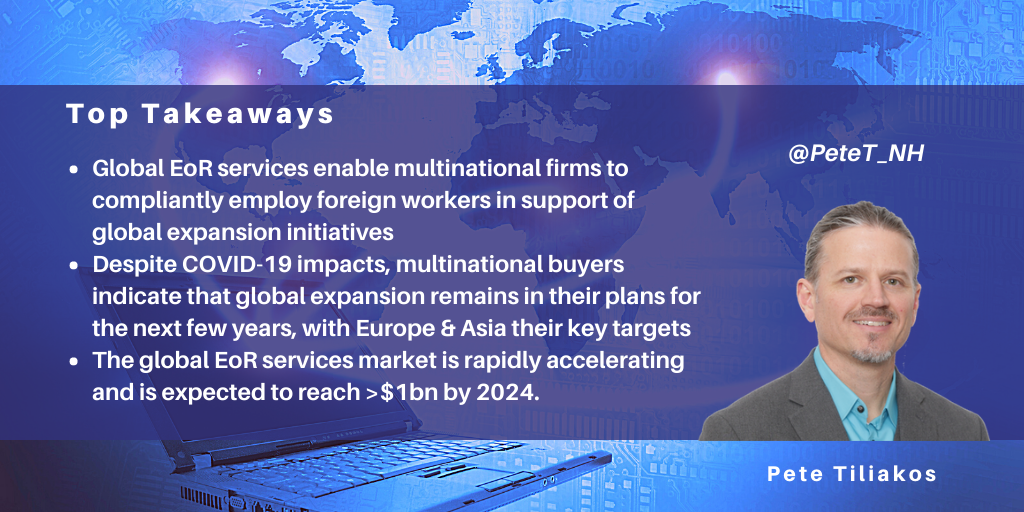
This past month, NelsonHall released the first market analysis dedicated to the Global Employer of Record (EoR) Services space, an emerging yet largely unknown HR outsourcing service model that enables growing multinational firms to compliantly employ foreign workers in support of global expansion initiatives.
While co-employment service models have historically been U.S. centric, global co-employment offerings have emerged, providing multinational firms with a highly agile, turnkey support model for rapid, compliant international expansion.
Global EoR services at a glance
Global Employer of Record services, also commonly referred to as Global PEO or International PEO services, facilitate international expansion by leveraging vendor-established legal entities and pre-defined country-specific contracts to employ workers in new countries of operation, where the organization lacks the proper business base, expertise, and capability to operate in full compliance. Contracted workers are thereby employed compliantly, in-country under the provider’s/partner’s established entities, while the client maintains full day-to-day control over workers’ activities and performance.
The service provides a comprehensive, highly localized HR and payroll support model for workers throughout the life of the contract and remains purposely decoupled and un-integrated from the organization's broader HR infrastructure and service delivery model.
While large multinational organizations are leveraging the service, the model is particularly well suited toward small and midsized firms operating in high-growth sectors, which often lack the resources and knowledge (time/cost, attorneys, expertise, infrastructure) to execute on a global expansion effort in-house.
The solution offers a lower risk, cost-effective, time-saving alternative (often deployable within days) to navigating the lengthy and complex process of establishing legal entities in-country, or simply deploying contract workers, which are often misclassified under local laws exposing the firm to fines, penalties, and compliance risks.
By design, the service model is particularly effective at enabling HR with greater speed and agility in supporting strategic business initiatives, leading to a competitive advantage for growth-focused multinational firms seeking to expand their footprints globally, test emerging markets, or access talent outside of their home country of operation.
Global EoR market outlook
Despite the recent global economic impacts of the COVID-19 pandemic, buyers interviewed overwhelmingly indicated that global expansion remains in their plans in the coming few years, as borders re-open and economies restart. While North American-headquartered firms will remain the predominant target and adopter of global EoR services, Europe and Asia will provide strong pipelines for new client/new worker growth, as the top targets in focus for expansion by both external and regionally-based firms.
Further, with organizations of all sizes increasingly finding their brands expanding internationally, and the intensifying need across sectors to access top talent globally, particularly as the 'Work from Anywhere' trend continues breaking down talent access barriers, the demand for agile, compliant global HR and payroll operating models will continue to intensify, accelerating the global EoR services market size toward more than $1bn by 2024.
While buyers confirmed that the global EoR service enables HR with greater agility in supporting international growth strategies, its ability to transform operations is less impactful at this stage, partly due to the lack of digital maturity present in the market, but also the narrow scope, low volumes, short durations, and temporary/contract nature inherent to the global EoR service model.
However, look for enabling technology platforms across the global EoR services marketplace to mature in the coming 12 to 24 months, particularly as differentiation in the space is commonly centered on the volume of entities under vendor control and in-country expertise, and the overall customer/worker experience.
Despite global EoR workers being purposely unintegrated from the broader HR infrastructure and operating model, it is critical that employers provide the same level of employee experience expected by a traditional employee. Therefore, expect to see increasing vendor investments in maturing, developing, and offering digital enablers and capabilities including mobile-first design, deeper process automation, infusion of AI, and analytic insights.
Looking ahead, as the solution gains traction and adoption, expect to see a deeper focus by vendors in cultivating a technology-enabled, 'one-stop-shop' of global expansion enabling solutions. Marketplaces of integrated partner services and technology aren't there just yet, but I expect to see these gradually take shape as vendors seek to fill the white spaces within offerings and extend client value beyond their core service offering.
I’m excited to see this service mature as I believe it is an exceptional lever which HR leaders of emerging, growth-focused firms have available to quickly execute and deliver speed and agility for their business. With vendors in hyper growth mode and currently investing in advancing their capability, technology, and offerings, I will be keeping close watch on the space as it heats up and matures!
For more information, or to access to the Global EoR Services market analysis report, contact Guy Saunders.
]]>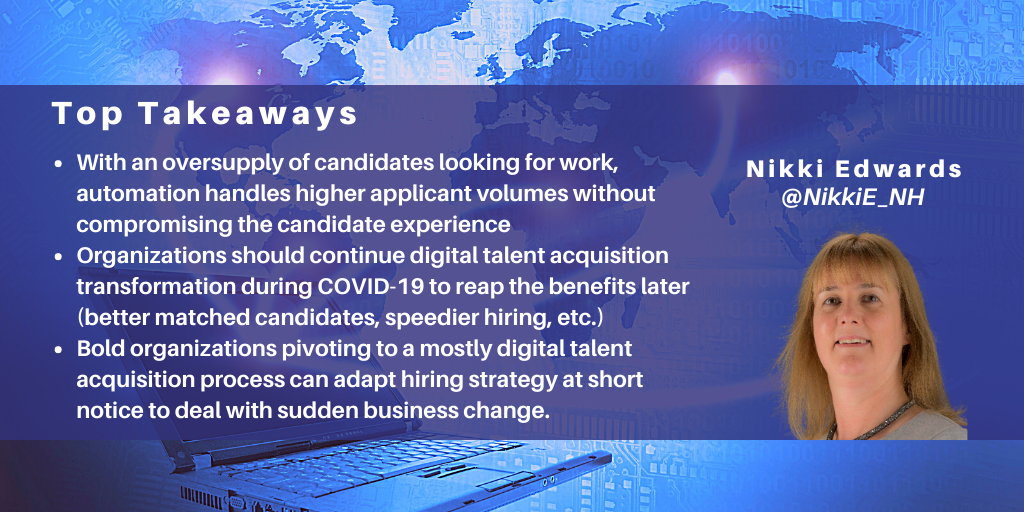
Everyone speculates as to what the long-term world of work could look like as we head into the second half of 2020 and beyond. But the reality is that we don’t really know how things will pan out. While organizations might be preparing for an uptick in hiring activity behind the scenes, the biggest challenges are the ongoing uncertainty around the future of work, and even survival from week to week.
Organizations have demonstrated resilience and agility in adapting to tech-enabled, remote, and socially-distanced operating models, often being surprised by the outcomes this has brought, notably business continuity with minimal interruptions. To continue talent acquisition (TA) activities, organizations have embraced tech and tools to aid remote interviewing, electronic signatures for documents, and remote onboarding.
However, organizations that fail to embrace such digital change, will leave themselves inflexible to sudden changes in business requirements, putting long-term survival in jeopardy.
Here, I look at three of Korn Ferry’s clients at different stages of digital TA transformation, to measure the impact of that journey on their hiring activity, as business priorities were turned on their heads.
Organizations embracing digital talent acquisition can pivot at short notice
A long-standing consumer products client, with 70% of its workforce sitting in high-volume categories (production, retail, etc.), approached Korn Ferry in 2017 to support its shift to a more digitalized approach to hiring. Using its six pillars methodology, Korn Ferry focused the client on identifying the hiring challenges they were trying to resolve. It recommended a third-party tech stack as well as proprietary tech to best enable the client’s objectives: scalability for seasonal and geographical expansion ramp-ups and ramp-downs being its priority (with the technology designed to handle candidate volume - 15,000 annual hires - at the top of the funnel).
While the funnel would normally be slow and inactive, with Korn Ferry seeking out talent through active campaign work, 2020 has seen that flipped on its head. A spike in unemployed people looking for work has transformed the client’s talent funnel to being very full and active, yet the client has absorbed the funnel ramp-up with no drop-off in service due to the scalable technology already put in place. The client can deliver a good candidate experience because the automation handles the sheer volume of applicants and screens them out if they are not suitably skilled. Having the digital capability to scale has clearly enabled this organization to pivot to the new circumstances of an oversupply of candidates.
A financial services client, hiring 30K heads annually, had fragmented, inefficient, and manual hiring processes. It was looking to digitally transform its talent acquisition function to increase efficiency and improve the candidate experience. Following a tech stack audit, it was advised to use a combination of Korn Ferry’s proprietary technology and a few select external providers. Korn Ferry Recruit (KFR) with its AI-sourcing capability would be suitable for niche roles (10K annual hires), while KFR’s Nimble platform with its chatbot and short-form assessments would be suitable for high-volume recruitment (20K annual hires). A proposed trial of an internal mobility platform was a feature of the tech stack. Many organizations keep scant records of employee skillsets. However, the internal mobility platform takes non-confidential employee details from basic HRIS records and augments them with in-depth public domain information available externally. The enhanced information acquired by Korn Ferry enables internal talent with specific skills to be identified and deployed elsewhere.
As March 2020 resulted in the immediate cessation of hiring in its retail setting due to the pandemic, there was an immediate need to redeploy employees into other roles within the business. While the recommended platforms/trial had not been implemented at this stage, there were strong indications that continuing with its planned TA transformation during COVID-19, would reap hiring benefits post-COVID-19 or in subsequent lockdowns. Benefits would include improved Time to Fill (when ramping-up numbers to meet pre-COVID BAU staffing levels), Interview to Hire, and Quality of hire measures (due to better AI matching of candidates), or easier redeployment of workers elsewhere if retail premises needed to close again.
It’s not too late to embrace digital TA and reap the benefits
The ongoing uncertainty for another of Korn Ferry’s clients (in the hospitality sector) will linger until a Government decision is made on whether to permit the mass gathering of people in 2020. And the window of opportunity for hiring is drawing ever tighter (with the final client decision for a “go” or “no go” hiring situation due in July). However, that has not prevented the client from preparing its TA strategy for this year.
The client would normally launch multiple in-person, recruiter-intensive hiring events, over five months (as it did in 2019) to find the 4.5K part-time talent needed for the Autumn season: a process that from year-to-year rarely sees the same talent apply. However, by March 2020, it was clear this talent campaign was not going to happen, so the client approached Korn Ferry for support. Korn Ferry suggested going 100% digital for its 2020 campaign – a dramatic pivot for the client, but one which would enable an instant 60% reduction in campaign duration – great when leaving the decision whether to hire until the eleventh hour!
Korn Ferry has deployed the Breezy HR platform and designed a single workflow (enabling a single application process) for six separate franchise companies that come under the remit of the client (rather than requiring six separate application processes), much improving the candidate experience. The manager’s decision to hire specific candidates is the only manual phase, with all other process steps being automated. If hiring does not go ahead, the worst-case scenario for the client is the cost associated with the consulting work undertaken in standing up the project. There will be no costs associated with the technology.
When decisions must go to the wire, with potentially 75 heads to be hired daily for 60 days, having a digital TA process clearly has its advantages. Whether the client forges ahead with hiring or reluctantly admits defeat for this year, it will be interesting to see if the digital TA set-up has changed their outlook on future recruitment for the better.
A digital TA transformation approach helps organizations embrace the future of work
Embracing a digitally-enabled hiring process does not mean sacrificing the high-touch approach. It is about achieving the right balance between technology and human interaction. Some digitalization of the TA process enables automation of mundane tasks and speeds up the hiring process, clearly giving competitive advantage to organizations. Driven by events in the first half of 2020, the technology deployed by these clients has enabled them to adapt to new circumstances when they least expected it. These case studies show how a digital approach to TA can take organizations to a new level of business agility that can help them to adapt to unforeseen circumstances at the flick of a switch. A digital TA transformation approach is highly recommended, especially when the future holds so many unknowns. Failure to embrace digital TA processes in 2020 will put those organizations at increasing disadvantage, making it more difficult for them to catch up with those organizations who have embraced digital transformation and are enjoying the benefits of being business agile.
]]>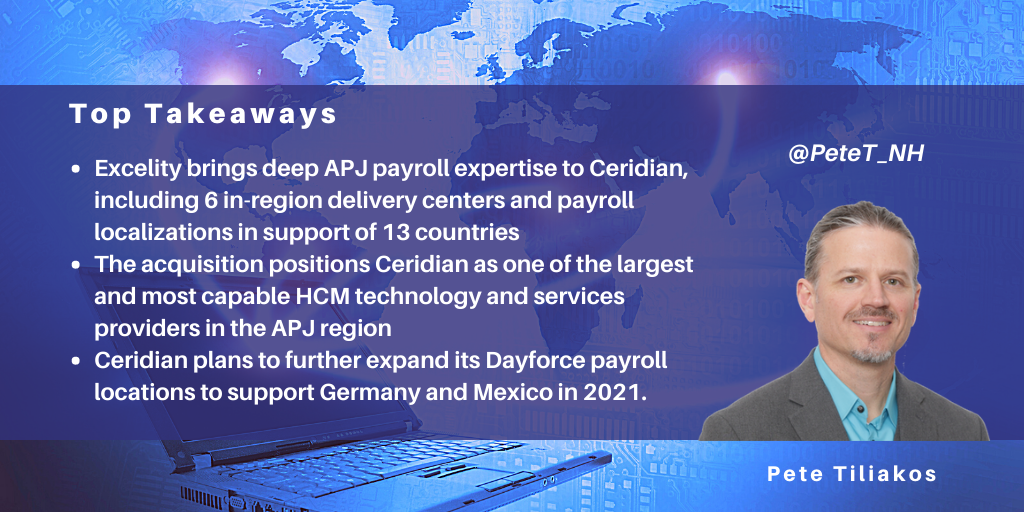
Since its IPO in early 2018, Ceridian has remained focused on reaching its goal of achieving $1bn in revenues. A key pillar of its growth strategy toward achieving that goal is the continued adoption of its Dayforce HCM platform by large multi-national buyers across key verticals, and expanding its adoption globally by enabling and offering integrated core HR, workforce management, payroll, and talent management to targeted countries, particularly the U.K. and Australia (which both helped it achieve 150% y/y growth outside of North America in FY’19).
To that end, Ceridian set out to expand its native global payroll capability, targeting ~20 countries over the next few years, and has quickly enabled Dayforce to support seven countries: U.S., Canada, U.K., Ireland, Australia, New Zealand, and Mauritius. Today, it supports nearly 4m users across >60 countries and this is growing rapidly.
Ceridian’s global payroll capability received a huge boost last month when it announced it would acquire Singapore-based Excelity Global, a leading APJ-focused HCM technology and managed services provider producing ~1.2m pay-slips monthly. The move now positions Ceridian as one of the largest and most capable HCM technology and services providers in the APJ region.
Further, with its September 2019 acquisition of APJ-based workforce management solution provider RITEQ, Ceridian now has a highly competitive, combined core HR, WFM, payroll, and talent offering, specifically localized for the APJ region.
Excelity’s impact on Ceridian’s capability
Not only does Excelity bring with it a proprietary cloud technology localized across 13 major countries in APJ, but it also brings a strong managed service offering, expertise, and delivery presence in the region supported by six primary centers, a key differentiator over other firms Ceridian evaluated.
From a technology perspective, Excelity has cultivated a strong proprietary native payroll capability and recently launched an HCM technology offering in 2019, including:
- EPay: PaaS payroll solution targeted to employers with >500 employees and configured for gross-to-net calculation in 13 countries (Australia, China, India, Indonesia, Japan, Hong Kong, South Korea, Philippines, Malaysia, New Zealand, Singapore, Thailand, and Taiwan)
- Ezpayroll: SaaS payroll solution targeted to employers with <500 employees and configured for gross-to-net calculation in 12 APJ countries (Australia, China, India, Indonesia, Japan, Philippines, Malaysia, New Zealand, Singapore, Thailand, Taiwan, and Vietnam). As well as an integrated third-party digital wallet through its GCash partnership in the Philippines
- Excelity HCM: cloud-based integrated HCM platform technology.
It also brings a well-adopted managed payroll services offering that currently supports >300 clients with operations in multiple countries across the APJ region, including several notable brands such as Forbes, Volvo, Uber, and Mondelez, enabled by an in-region delivery footprint and capability that spans five countries (India, China, Singapore, Malaysia, and the Philippines), a key factor in supporting Dayforce’s continued adoption in the APJ region, and boosting Ceridian’s global presence.
The combined organization’s global footprint significantly enhances Ceridian’s “follow the sun” capability in support of service delivery, as well as its further development and innovation of future HCM technology.
Ceridian’s outlook
With the Excelity deal now closed, Ceridian has begun the process of merging and integrating the two organizations and capabilities, which is always the top challenge to any acquisition, particularly with two organizations at opposite ends of the globe.
While Ceridian doesn’t have a deep history of acquiring its capabilities, the complementary nature of the Dayforce HCM platform, combined with the strength of Excelity’s APJ experience and capability, should fit nicely, boosting its product offering, targeting, and adoption by firms in the region, as well as among North American and European based multi-national firms with operations in the APJ region.
A key decision for Ceridian will be deciding how to best leverage the additional technology Excelity brings. Will it be necessary to keep both Epay and Ezpayroll? And what becomes of Excelity HCM now that Dayforce is the parent flagship HCM platform (particularly as it seeks to shift Excelity’s client base to Dayforce)?
Ceridian plans to immediately leverage its global connectors to bring the Dayforce HCM platform and Excelity’s payroll technology together, en route to an eventual full integration. It further intends to enable Dayforce with localizations aligning to the set of countries covered by Excelity, with more expected to come longer-term through its roadmap.
While APJ is well in focus and adoption increasing, Ceridian has its sights set on deepening its global presence and capability. Late in June, it launched localization for Mauritius, with its first client, (IBL Group, a large multi-national firm with ~27k employees in 22 countries), as well as Germany, and Mexico planned by the end of 2021. It further supplements local payroll through its partner network to support broader EMEA and LATAM, and provide payroll coverage for 157 countries.
With Dayforce maturing steadily through its roadmap, including recent capabilities like Dayforce Wallet (U.S. only, with Canada set to launch in 2021), Dayforce Intelligence, Dayforce Safety Monitor, and deeper talent management capability (e.g. AI-driven recruiting), Ceridian is well positioned to gain continued adoption, particularly from strategic-minded, multi-national firms seeking next-generation HCM capabilities.
]]>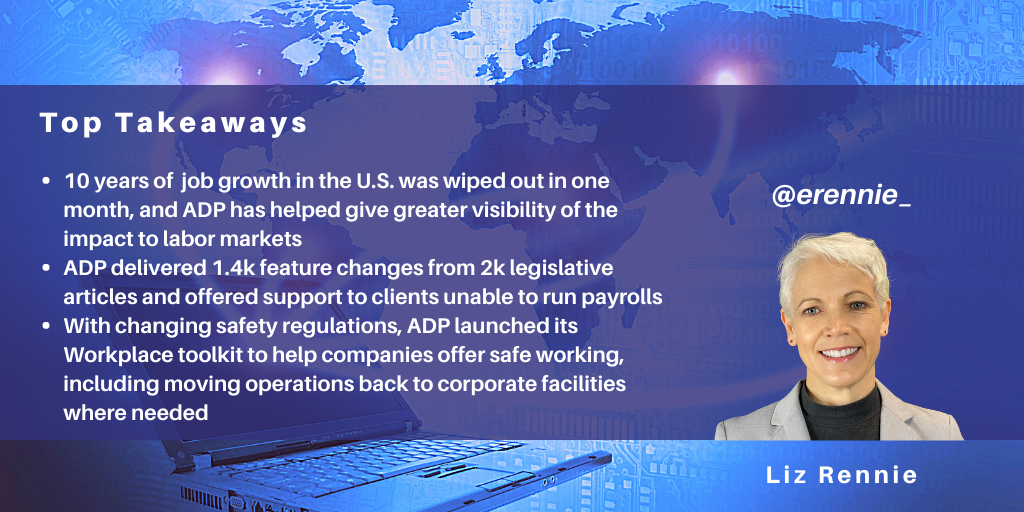
Earlier in the month on the NelsonHall HR Quarterly Buyer Market Round-Up session, many buyers agreed that compliance is going to be a bigger issue in 2020 and beyond than it was before. Before it was just table stakes, now it is about survival, and with the new WFH (Work from Home) structures, the risks are higher.
I had this in mind when I joined ADP’s Analyst Day last week. ADP shared how HR priorities are changing and how, as one of the largest HR and payroll providers, they have responded to the many shifting priorities and also staying close to clients to support their changing needs. Here are a few takeaways from the ADP Analyst event, through the lens of Liz Rennie. I consider these to be the most significant as they relate to HR in the pandemic recovery world:
- HR has been focusing on employee safety as the number one priority like never before – this we all recognize and is not news
- 10 years of job growth in the U.S. got wiped out in one single month – and an impact is job insecurity is heightened. HR teams know employee health and wellness, as a result, can indirectly affect productivity
- Employees working on the front line in COVID-19 crisis response industries do not need the extra stress of not being paid on time
- Compliance is now more than table stakes – navigating the relief opportunities offered by the governments in a timely way has meant the difference between a small business surviving or folding.
And just in case you didn’t appreciate your payroll provider enough, this is a glimpse of how ADP responded over the last months and how they are planning to help clients in the near term:
- ADP saw a 50% increase in clients reaching out to ADP the first few weeks of the pandemic compared to normal call volumes
- Implemented 1.4k feature changes from 2k legislative articles across 60 countries
- Responded within three days of the CARES Act passing to support small businesses with the implementation of its Paycheck Protection Program (PPP)
- Enabled 400k clients to run 2m SBA loan application reports, representing a value of $115bn
- Over $600m tax credits processed for 473k employees across 38k clients
- Partnered with Volunteer Surge. ADP’s Workmarket product helped onboard 1k volunteer health workers across 45 states within two weeks
- Offered free trial access of Employee Assistance Programs to clients through LifeCare to support workplace stress - 550 clients signed up in the last two months.
Three clients joined the ADP Analyst Day session to share their experiences of living through the pandemic using ADP services. All were very complimentary of how they had full confidence in the service. They also shared that ADP offered extended support, to the extent that if the client struggled to run a payroll internally, ADP offered to step in and run the payrolls on the client's behalf in the short term if that was needed.
Finally, it is great to see many wider initiatives to help the industry. ADP is assisting the industry through the following methods, which, if you’re not an ADP client, you can also benefit from:
- ADP Research Institute Labor Market Summit 2020: you can still register here
- COVID-19 microsite with employer tools launched 19 June 2020: www.adp.com/Forward
- Collaborated in key research such as The U.S. Labor Market during the Beginning of the Pandemic Recession see: https://www.nber.org/papers/w27159
- Creating thought leadership through the Marcus Buckingham Company with The Feedback Fallacy, Harvard Business Review’s most downloaded article in 2019
- ADP research Institute headed up by Dr. Ahu Yildirmaz produces some powerful insights, my favorite is this one: ADP Workforce Vitality Report – subscribe here
So what’s next for ADP? Don Weinstein, CVP Global Product and Technology, shared the ADP Workplace toolkit to help get employees back to office spaces. So what is good about this?
- Employees that state they are ready to go back can register as such through a survey
- HR organizations can accordingly plan, communicate and prepare the offices for specific workplace returns– allocating employees to different days of the week to enable staggered and rotational returns of different employee groupings
- COVID-19 health surveys regularly sent before returns to support attestation and screenings
- Touchless ADP mobile apps supporting entry on site
- ADP DataCloud to enable reporting and analytics and if needed, contact tracing based on attendance on site
With regulations regarding workplace safety around the world changing all the time, compliance now has a whole new meaning. Corporate manslaughter is an area that no clients want to have to face, but staying out of touch and out of the offices for long periods is also likely to bring its own compliance issues.
One caution, otherwise I wouldn’t be an analyst. The much anticipated new ADP product Next-Gen HCM developments might be somewhat delayed given all of the above, but I won’t hold this against ADP.
As independent analysts, we need to keep things factual. However, in the spirit of showing empathy in these unprecedented times, I want to extend a big thank you to ADP and all the other payroll and HR providers for helping clients, ensuring the livelihood of many employees during the crisis (which fundamentally includes paying people on time and assisting many businesses to get the relief they needed to survive) and also for supporting the wider industry in providing valuable insights into the impact COVID-19 has had on people, which has helped shape relief efforts and responses.
]]>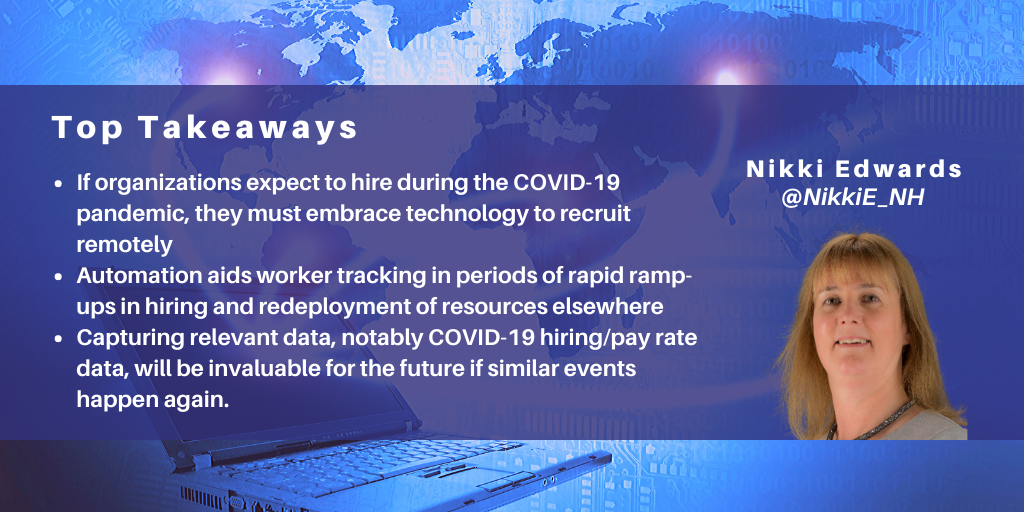
My initial research into Impact of COVID-19 on Recruitment Services: Vendor Perspective (March 2020) highlighted several stand-out dilemmas that client organizations face. Notably, some organizations need to continue hiring and the only way to do so is by embracing technology (sometimes reluctantly), enabling them to carry out recruitment steps remotely. Also, some sectors were ramping up hiring (in an already-tight labor market), while other industries had ceased all hiring activity for the immediate term. Without the appropriate technology in place, how would organizations needing to furlough workers, and end contingent worker contracts in the short-term, be able to rehire them later?
I recently spoke to Cory Hansen, VP of MSP Operations at Allegis Global Solutions, to establish how they have been helping organizations navigate the COVID-19 pandemic. I was keen to focus on their expanded (via acquisition) healthcare vertical (representing 20% of their MSP clients), the cyclical nature of demand for hiring support of contingent workers in the sector, and their use of technology to track those workers.
Allegis Global Solutions’ initial approach
Following initial focus on preserving employee health and safety, enabling its employees to work from home, then supporting its clients to do so too (by setting up its MSP COVID-19 taskforce), there was a wave of MSP clients that needed to either ramp-up or reduce their workers with immediate effect.
Within 12 hours, Allegis Global Solutions had set up a COVID-19 Operational Demand Center (with a Leader, a Recruitment Manager, a Supplier Manager, and three specialist recruiters) to control all the different client demands centrally. Being able to holistically see all recruiters and manage their movement, from program teams seeing declining recruitment to program teams seeing recruitment surges, was essential. More importantly, Allegis Global Solutions needed a grip on the movement of all contingent workers (whether those of their existing clients or new organizations reaching out for the first time for COVID-19 support).
Healthcare sector focus
The Healthcare vertical, with three clusters of clients with hiring needs at different times throughout the pandemic, would add another layer of complexity. Life Sciences (including Medical Devices, Pharmaceuticals, etc.) were ramping up hiring from the get-go. One client, manufacturing items to combat COVID-19, required an additional 250 resources, which Allegis Global Solutions delivered within three weeks, leveraging their existing supply chain. Another client needed to reach a target of delivering 100,000 medical devices to hospitals, requiring 100s of extra staff to manufacture those devices. Also, clinical clients were ramping up, but with the complexity of worker reassignment. Allegis Global Solutions uses its proprietary platform to keep track of the workers. Information stored comprises key details of the worker; the supplier representing them; the manager they report/reported to; the client they are/were deployed with; and the original requisition number. This enables Allegis Global Solutions to successfully reassign workers to new jobs and track their location so they can be hired for a new assignment or rehired in their original position, should circumstances allow.
One client, providing occupational health services, was adapting its services to support the COVID-19 pandemic (temperature screening, nurse provision, etc.), requiring tracking of their redeployments. Similarly, hospital network workers were being redeployed from areas (such as elective surgery, where demand has slumped) to ICU, which was desperate for additional resources.
Allegis Global Solutions’ proprietary technology proved its worth when it was asked by a State Governor’s office to stand up a hiring solution within 24 hours. The solution required 1000s of clinicians to be on the front line to save lives at existing and temporary hospital sites, as well as to skill nursing facilities throughout the State. Twelve hours later there was a verbal agreement in place to deliver MSP-type services for them (normally a 12-month engagement cycle) and deploy technology (a four-to-six-week process, usually). The project was to supply talent and create an outreach web portal for talent (possessing medical skillsets). The program could potentially have needed 12-15K extra hires as a worst-case scenario. Further complexity has come from the need to interface with and source talent from several existing hospital networks, which would normally be competing with each other. To date, there have been over 1000 clinicians hired and dozens of individuals reassigned from other jobs.
Allegis Global Solutions has been leveraging its ACUMEN Business Intelligence technology, too, where at the presentation layer, it can get access to as much data as it needs to see what is happening in real-time. It keeps track of all clients, what jobs are open, and what jobs have been cancelled. Also, it identifies where there is a surplus of workers who can be redeployed to another client with a spike in demand. It has been a useful repository of pay data, too. The already severe clinical staffing shortage has been exacerbated with COVID-19, as clinical workers have demanded a 30%-100% pandemic/ quarantine premium in addition to their basic pay to consider a temporary role. This data set from the pandemic will be invaluable for the future if similar events happen again.
Looking ahead
As per the NelsonHall March 2020 research, Allegis Global Solutions is one vendor advising its healthcare clients (especially frontline clinical workers) on the quickest way to leverage technology to aid remote hiring, especially for virtual interviewing (where face-to-face interviewing has been the norm), timely background screening/credentialing (including drug testing), and the virtual onboarding of workers. Allegis Global Solutions has helped clients to prioritize the components, from the most important to the least important, making concessions allowing contingent workers to start work, with checks following on later than would otherwise be permitted.
Into Q3 and beyond, essentially a lag of several months, the healthcare payer providers will see an uptick in work, resulting in a surge in demand for extra staff from Allegis Global Solutions, as end customers will make claims, require preventative testing, and the window for open enrollment looms (with expectations of enrollments being higher than ever before). This activity may be post-clinical ramp-up or sit alongside (depending on how long the COVID-19 pandemic remains at a “requiring social distancing” level). It will, however, add further data/tracking insights into the impact of the COVID-19 pandemic via its proprietary platform and ACUMEN. When the pandemic is over, it will be interesting to see the patterns of reassignment and rehire of workers throughout the period.
Conclusion
For me, what the COVID-19 pandemic has highlighted is that organizations have left themselves exposed through their slow uptake of digital transformation (especially in the recruitment space). On a positive note, it has made everyone aware of the importance of technology in their daily lives (and how it has enabled organizations to have some level of business continuity). It has forced organizations to embrace digital transformation at an initial break-neck speed, such that there is now no turning back. The Allegis Global Solutions case study highlights that organizations cannot embrace digital transformation/ recruitment transformation single-handedly. Organizations must seek out a suitable partner who can guide them on their transformation journey.
]]>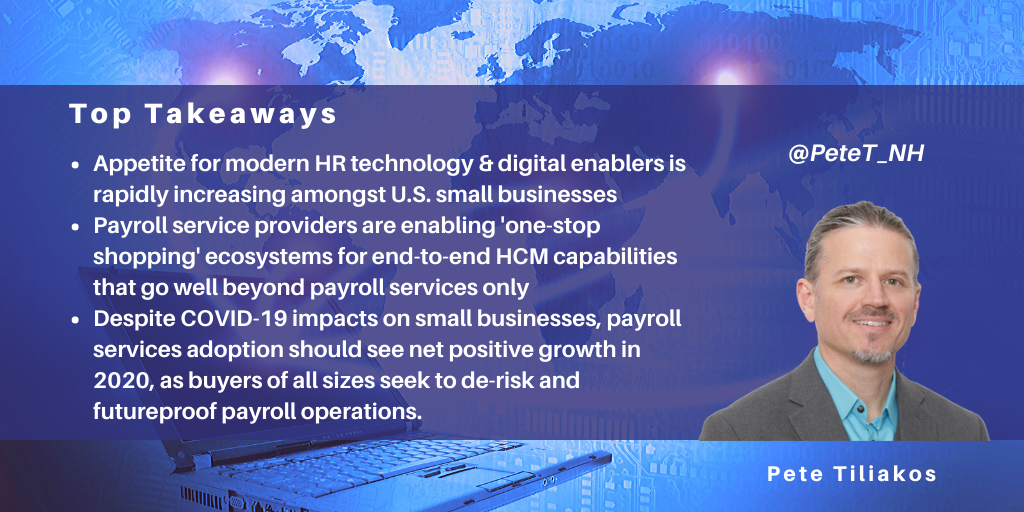
NelsonHall recently published a new U.S. SMB Payroll Services marketing analysis specifically focused on how HR service and technology providers are meeting the increasing demand for technology-based payroll and HR solutions from emerging small-mid sized businesses (<250 employees).
The SMB picture
Payroll services adoption remains steady amongst buyers of all sizes and still primarily driven by the need to improve the tactical elements of payroll execution (timely, accurate, compliant). And like larger middle-market and enterprise buyers, small businesses are commonly seeking out advanced, modern cloud platforms and services that can deliver the digital HR capabilities necessary to compete for top talent, address the ‘future of work', and enable compliant, scalable HR operations to support future growth.
The demand amongst small businesses for modern technology and digital enablers that can mature the organization's HR practices and enhance the employee experience is rapidly increasing; and the increasing demand for digital HR capability has shaped the vendor landscape, such that competition in the payroll services space is no longer limited to traditional payroll service providers alone. Technology providers have more recently pushed into the market; for example, Namely adding payroll services to its offering in the fall of 2017 and Kronos acquiring Louisville-based Advanced Payroll Systems in 2018.
Small market buyers in the U.S. now have more options, with payroll services commonly offered through three core vendor types, including traditional managed payroll services providers, HCM technology providers with payroll services capability, as well as full HRO engagements through co-employment models offered by PEO providers.
Payroll as a gateway to broader services
Historically, payroll services were positioned as 'bureau-style processing services,' focused mostly on simple processing and compliance, which has mostly been replaced in favor of 'technology-enabled managed services' and extended by complementary HCM solutions. Managed service providers are increasingly positioning payroll service offerings as a core component in broader human capital management platform-based solutions, seeking to enable a 'one-stop shopping' ecosystem for end-to-end HCM capabilities that go well beyond payroll.
As a result, all major payroll providers are now heavily emphasizing their technology investments, capability, and digital HR/payroll innovation when positioning their offerings (up and down market). A good example is ADP’s recent 'Always Designing for People' rebranding effort, to emphasize its HCM innovation focus and investments. Additionally, payroll providers are expanding their offerings well beyond traditional managed payroll-only services to offer comprehensive HCM solutions.
With this HCM focus, payroll is more commonly being positioned with SMBs as a single, but core, component to broader HCM technology and services; buyers are most often seeking and buying a bundle of core HR, payroll, time, and benefits together as an entry point, and increasingly adding talent management capabilities next, most commonly onboarding, recruiting, performance management, and learning.
A growing trend in SMB service offerings is the addition of HR compliance support capability, to provide clients with access to live HR experts for day-to-day compliance advisory and guidance. Offerings include on-demand HR advisory and support through dedicated SMEs, handbook creation, HR knowledgebase and tools, employee surveys, analytics, and benchmarking capability across company size, region, and sector. Examples include Paycor’s HR COE, Namely’s Comply, Advice, Action offering enabled through partner integration with ThinkHR, and Zenefits’ HR Advisory offering.
Integrated partner solutions
Vendors are also rapidly expanding their HCM offerings through the development of formal and informal 'marketplaces' to offer integrated partner solutions (enabled through advanced APIs), which address white spaces in vendor offerings and allow buyers to enable custom HR solutions to fit their unique needs. Larger, more mature payroll providers and HCM technology providers are gradually working their offerings toward 'open platform' approaches, which will enable clients and third parties to develop integrated solutions for connecting to vendor platform technology, aiming to further enable clients to derive 'custom' HCM solutions leveraging modern technology with bidirectional integrations.
The top five focus areas for integration partner additions by SMB payroll providers are:
- On-demand payroll capability (e.g. DailyPay, PayActive, Rapid!)
- Global payroll partners (e.g. CloudPay, Safeguard Global, activpayroll)
- Time and attendance (generally for more advanced capabilities beyond basic time and attendance tracking, e.g. advanced scheduling)
- Talent management capability, most commonly at the SMB level (onboarding, recruiting, compensation, performance, and learning)
- Analytic reporting capability.
In speaking to vendors, a key trend is the growing demand for multi-country payroll by SMBs (key countries in focus include the U.K., France, Germany, and ANZ). While native multi-country payroll capability is limited amongst most SMB payroll providers, many are now commonly partnering with providers that can offer integrated multi-country payroll capability.
SMB investments and roadmap
Much like upmarket solutions, SMB payroll-enabling technology is being differentiated through features focused on enhancing the user interface (UI) and user experience (UX) to be more personalized and guided, expanding digital enablers to offer modern capabilities like a mobile-first design, embedded AI/ML/NLP, deep workflow and process automation, IoT connectivity, geofencing capability, biometric and facial recognition, and visual dashboards with real-time analytic reporting.
Top investment and roadmap focus areas across SMB payroll providers for the coming 12 to 18 months include:
- Enhancing the UX/UI to provide a consumer-grade experience that is engaging, simplified, intuitive, personal, and guided
- Advancing toward a mobile-first/only capability to enable full platform functionality on mobile devices for both administrators and employees
- Enabling on-demand payroll and digital payment solutions
- Expanding offerings beyond payroll with new product offerings; top focus areas: HR advisory and compliance support, analytic reporting, talent management (most adopted: recruiting, performance, learning)
- Infusing AI, ML, and NLP across the platform to drive 'extreme' personalization, guided experiences, and enable predictive and prescriptive insights in context
- Opening platforms and developing formal/informal marketplaces for third-party integrations and extended HCM solutions
- Expanding partnerships and integrations with global payroll providers to support multi-country payroll requirements.
The outlook for the SMB payroll services market
The outlook for small business payroll services in 2020 and beyond is both exciting and concerning. While the market is healthy, thriving, and growing, the recent challenges of COVID-19 have wreaked havoc on small businesses in the U.S. and will continue to do so for the foreseeable future.
Payroll vendors have done a tremendous job supporting and sustaining 'business as usual' for their clients, providing an overwhelming amount of support, tools, training, guidance, and advisory in helping clients navigate the challenge, assess options and interpret government directives for workforce impacts. With providers increasingly positioning themselves as 'trusted business partners' and differentiating through the user and client experience, service providers have an opportunity to truly prove their value and solidify their partnership commitment, which will drive client retention long-term.
There is no doubt SMB payrolls will shrink across hard-hit sectors (hospitality, travel, retail), which will reduce or slow overall vendor revenue growth for 2020, particularly if the economy shifts into a deep recession and buyers pull back on decision making or shopping for services. Vendors with sizable SMB populations will take the biggest hit from headcount and payroll shrinkage.
However, with payroll a critical process all businesses must execute flawlessly regardless of global concerns, combined with the learnings from COVID-19's impact, this should support net positive growth with payroll services adoption in 2020 as buyers of all sizes seek to de-risk and futureproof payroll operations, particularly those lacking a modern cloud infrastructure and sound BCP/DR capability to operate in unpredictable times.
]]>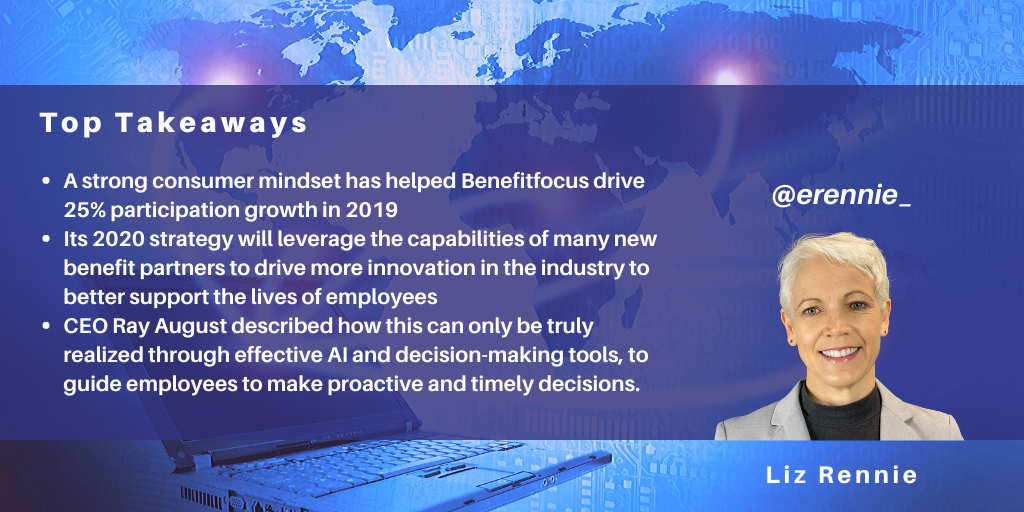
The recent OnePlace2020 digital conference was an opportunity for Benefitfocus to launch its 2020 strategy and to increase awareness of the benefits marketplace. Its vision is to improve lives with benefits, timely in light of the current global pandemic.
Ray August, President and CEO, shed light on the fact that health care costs per employee have grown faster than wages. Benefitfocus’ mission of shaping the benefits industry through understanding people’s needs and analysis of data shows Benefitfocus taking the role of industry thought leader and benefit curator. It recognizes through working with all stakeholders in the industry that it is in the mutual interest of employers, employees, and suppliers to ensure high participant satisfaction, effective services, and value for money. The ongoing challenge seems to be educating employees and HR advisors to understand the benefits offerings, with ML tailoring packages to individual needs to participate at the right time.
Benefitfocus achieved impressive growth in 2019, with 25m people on its platform, up 25% from 2018. Ray August suggests growth has been primarily driven from having a strong focus on understanding and researching consumer needs. From 2020 onwards, it aims to broaden its approach, engaging more with the wider community, including employers, brokers, health plans, and suppliers. It looks to drive closer engagements with all players in the industry to bring a wide range of innovation and new offerings to participants. These could be very specific solutions to help with particular needs: bringing consumers an extensive suite of offerings enables greater tailoring of benefits to suit many more individual needs. The key to success is the ability to leverage AI and data.
As part of its broadening objective, Benefitfocus developed Benefitplace, a digital marketplace where all interactions with participants can be managed from a single place. Benefitplace has approximately 150k employer users, with over 80 products and services from 50 partners. Throughout 2020 it will extend Benefitplace, as well as InnovationPlace, bringing on new startups into the program. Innovative companies introduced include:
- Family and fertility planning firm Natalist
- Home ‘over the counter’ medicine kit provider Cabinet Health
- Milk Stork, a company helping mothers with breastmilk shipping and breastfeeding options
- Mymedicalimages, a HIPPA-compliant platform for consumers to view, manage and share medical images, speeding up treatments and assisting with referrals
- FutureFuel and Edmit, companies helping with college decisions and managing debt.
With its digital marketplace, Benefitfocus will be able to offer more creative benefits offerings, leveraging fresh start-up innovators in the industry.
It is worth saying that at the time of the COVID-19 outbreak, at short notice, Benefitfocus moved the OnePlace2020 conference to a digital platform. It should be applauded for the quick decision-making and the technical enablement at a time of world crisis. The conference delivered key messages on how the benefits industry can help employees, providers, and companies all reach the common goal of supporting health and wellness, at a time of heightened urgency.
I am researching Next Generation Benefits Platforms for my next market analysis project this summer, delving deeper into adoption challenges and the opportunities these technologies provide to consumers.
]]>
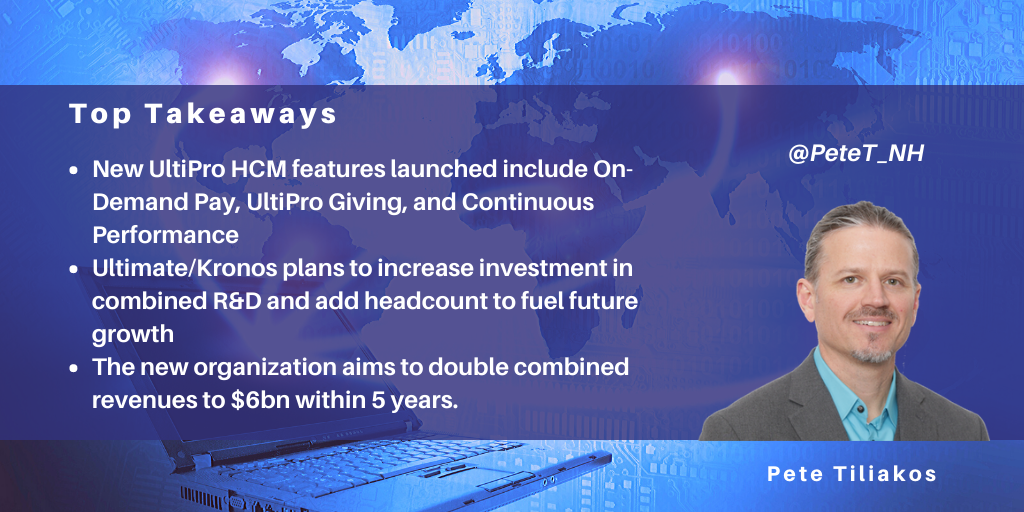
Ultimate Software recently held its annual Ultimate Connections client event in Las Vegas, drawing over 4.5k client and partner attendees from across the UltiPro HCM ecosystem. Attendees’ interest had been piqued by the announcement a few days before that Hellman & Friedman-owned Ultimate Software and Kronos plan to merge, forming one of the largest global cloud technology providers with a combined enterprise value of $22bn. Kronos CEO Aron Ain will be CEO and Chairman of the new company. The merger is expected to close in late March.
In his keynote speech, Ain highlighted the strong alignment between the two award-winning “culture obsessed” technology firms, also their complementary HCM and WFM technology capability. Ain assured Ultimate’s employees of his commitment to sustaining and building on the legacy of Ultimate’s People First culture and approach, and emphasized to clients the new entity is “here to stay, here to improve, and here to grow” with the UltiPro HCM platform at the foundation of that future growth.
And the new organization has ambitious growth plans, starting by doubling its revenues to $6bn within five years. In support of this, it intends to add around 3,000 jobs over the next three years across all segments of the business.
What’s new for UltiPro HCM?
From a roadmap perspective, 2019 was a productive year for Ultimate, which delivered >700 new platform features derived from >410 client ideas.
In 2020, Ultimate launches multiple new HCM features, each aligning to the various stages of the ‘life-work journey' which for most is often in flux and continually evolving throughout their careers. Notable features announced at Connections include:
- On-demand pay, through integration with Rapid!: provides workers access and control to earned wages prior to the pay-cycle end. We noted that Rapid!’s booth was crowded throughout the event, a reflection of the interest by employers in offering employees broader digital financial wellness solutions to help ease or avoid hardships
- Privacy Manager: a dashboard enabling employees to manage personal data, which can be erased, or downloaded for portability through the new data management tool
- Ulti-Giving: (from end March 2020) facilitates philanthropic donations through payroll deductions, including on mobile
- Continuous Performance (Q3 2020): AI-infused performance development tool which gives real-time coaching to leaders to provide ongoing, meaningful feedback to their employees in order to drive performance improvements; also includes interactive meeting and goal-setting capabilities.
While the future roadmap for UltiPro is mostly under NDA, it will center on three pillars, all leveraging AI, ML, and NLP:
- Mindful AI, bringing together the capability of ‘Xander’ (sentiment, emotion, and intent insights) and ‘Aimee’ (business insights) to drive improved HR outcomes and address key use cases
- Expansive Accessibility, enhancing the suite to be more nimble, inclusive and adaptive, partnering with digital accessibility company Level Access (an UltiPro client since 2017)
- Culture Inspired UX, improving personalization and in-context support.
What’s next for the new organization?
Although Kronos has made significant strides in recent years with its HCM offering (Workforce Ready and Workforce Dimensions), the more mature UltiPro HCM will become the flagship HCM platform for the new company, with Kronos Workforce Dimensions being the flagship standalone WFM especially for enterprises. The two offerings will be tightly integrated and will fill the advanced scheduling gap in UltiPro’s functionality. This HCM+WFM combined offering will play more toward the middle market and enterprise buyer. It further plans to retain and position Kronos Workforce Ready for small and mid-sized firms with less complex talent management and workforce management needs. Work on integrating the technology is already underway, with the plan for the combined Ultimate HCM + Kronos WFM offering to go live as soon as the merger completes in late March.
The two companies have differed historically in their go to market, with Kronos taking a highly verticalized approach, an approach that Ultimate can benefit from. While Kronos has often targeted the operations side of the business with WFM, being particularly experienced with large complex manufacturing, retail, public sector, and healthcare firms, Ultimate has typically sold directly to the HR function without a vertical slant. A vertical GTM approach for UltiPro HCM should help expand opportunities with new buyers.
The joint client base has >23k organizations, with few shared clients: potentially, there are significant cross-selling opportunities.
Growth plans for the new organization also include international expansion. UltiPro HCM currently supports users in 175 countries. The integration of Kronos WFM with the PeopleDoc HR service delivery platform offers a gateway to multi-country clients.
Bringing two very strong brands and technologies together in what is essentially a merger of equals obviously has its challenges. Both are well-respected brands in HR technology; both have rich and admired cultures. The merger will take careful navigation, execution, and strong leadership.
Clients with whom I spoke at the event expressed cautious optimism about the merger. UltiPro users are keen to tap into the WFM capabilities and innovation offered by Kronos, and of course they are interested in future innovations coming from the marriage. But naturally, clients are waiting to see how the merger will impact their engagement with Ultimate. Notably, all expressed confidence in Aron Ain's ability to lead the new organization to the next chapter.
The new Ultimate/Kronos entity comes at a time when both firms are experiencing strong adoption and steady recurring revenue growth. Together, Ultimate and Kronos offer a very formidable combined HCM and advanced WFM offering and capability that will increasingly compete for larger, more mature global clients. We expect to see rapid innovation coming out of the new company, innovation that will help fuel continuing growth.
]]>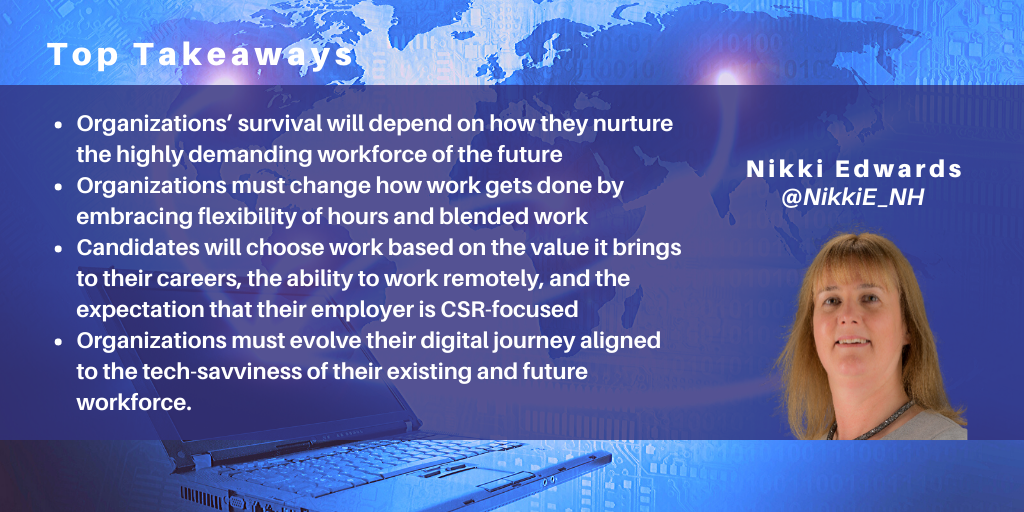
As a “Gen-Xer” I look back over my career and can identify four out of ten organizations that had an incredibly positive influence on my life. What made that 40% stand out was that, despite economic market forces, technological change, evolving customer/consumer habits, and skills shortages (as new technical jobs evolved), they successfully adapted to change. They also evolved their workplace cultures to keep workers (typically a mix of three generations) engaged and motivated to perform at their best. The workers could look holistically at the challenges faced and work creatively (often thinking outside the box) and collaboratively to overcome them through the good times and the bad.
Only the fittest will survive
As we begin the 2020s, I believe that the challenges faced by organizations are essentially the same. What is different is the pace of change (or transformation), the complexity/interrelatedness of the factors (through globalization/internationalization, the need to be data-driven, etc.), and the number of organizations now facing those challenges. What worries me is that many organizations are still not driving the cultural/mindset changes needed to thrive in the 2020s workplace of the future (a five-generation workforce enabled by technology), adding further complexity to the mix.
NelsonHall’s recent RPO, MSP, and Learning research projects each identified that one of the main barriers to organizations transforming their talent acquisition or learning strategies continues to be their unwillingness to collaborate on business-critical issues, choosing to operate in (and protect) their functional silos.
The harsh reality is those organizations will not secure/retain the talent they need and are unlikely to survive the decade!
Looking at the small details such as flexible working can make a big impact
With unemployment levels in many advanced nations set to remain below 5%, the nearer to zero unemployment rate that may present itself as the U.K. leaves the EU, along with the 2020s workforce having many demands, organizations will have to work extra hard to keep existing workers/attract new talent, if they are to remain competitive. They must nurture their workforce and evolve their workplace cultures to meet their needs.
An aging population and five generations of workers (35% of them being over 50 by 2022 according to the CIPD) bring complex issues and demands. A higher proportion of older people living with medical conditions means that more Baby Boomers, Gen X, and older Millennials face carer duties, as they must look after elderly parents. This could require workers to break up their working day into two or three parts to fit around caring duties. Similarly, advances in medicine mean that workers with acute/chronic conditions can work around their treatment regimen. With much emphasis on employee/worker physical and mental well-being, more workers (irrespective of generation) want to break up their working day by attending an exercise class or mindfulness session, at a time when they are least productive (when their concentration levels dip). Gen Zs like face-to-face social interaction, security, and hold values around diversity and inclusion.
Organizations must examine how they can change the way work gets done (to be efficient, cost-effective, productive, etc.), by embracing blended work, using non-employed workers (to benefit Millennials’ preferences) as well as employed workers, so it is a win-win situation for all parties.
My 2019/2020 NelsonHall research showed that many RPO and MSP vendors have stepped up to an enhanced service excellence model, with the aim of providing unrivaled customer experience to their client organizations so as to give them a competitive edge. One vendor hired a “Manager of Small Things” whose remit was to make incremental improvements in service delivery that make a big difference. On a smaller scale, some RPO/MSP vendors are using AI and data-driven insights to look at the optimum window when workers are at their most productive. With positive client feedback, looking at the small details can make a big impact on the workplace. It is a shame that so many organizations fail to recognize this and are determined to stick to the old ways of doing things.
According to the IWG Global Workspace Survey 2019, 80% of respondents said when faced with two similar employment offers, they would turn down the one that didn’t offer flexible working. 85% of companies confirmed that productivity has increased in their business as a result of greater flexibility. Organizations be warned!
Big issues such as remote working also need to be considered
Millennials thrive on technology (from workplace apps that increase mobility to virtual workstations and cloud-based collaboration tools), so organizations must offer flexibility that gives them the option to work remotely, attend meetings virtually, and collaborate online rather than in face-to-face meetings. With the ongoing global skills shortage, candidates with in-demand skills are leveraging gig platforms more to seek out their next opportunity (enabled by global interconnectivity). In the 2020s, candidates will choose their work based on the value it will bring to their careers and will do it remotely from anywhere in the world. Organizations need to embrace the idea that if the work gets done, it doesn’t matter where it is carried out. RPO, MSP, and Learning vendors are adding new tech/tools to their ecosystems that enable a much more flexible approach to working (anywhere, anytime, and any device), paying attention to multigenerational needs. Recruitment vendors are adding gig platforms/Direct Sourcing platforms to their tech stacks.
With several news-dominating incidents over 2019/2020 (Amazon fires, Australia fires, the melting Antarctic icecap, Coronavirus, etc.), these concerns are at the forefront for all generations of workers. The 2020s will require organizations to significantly step up their CSR focus on these issues. Introducing more remote working, enabled by technology, will help reduce organizations’ and individuals’ carbon footprint. Reducing the need to commute/travel to an office (the knock-on positives of reducing traffic/air congestion and emissions, alleviating a creaking and unreliable transport infrastructure, and avoiding highly crowded environments, etc.) would support increased worker well-being, productivity, and engagement. Longer-term, climate change and natural disasters may force populations to relocate, so organizations embracing remote working as a workplace cultural norm could be less impacted by such an event.
Digital resources will play a growing part, but not at the expense of humans
All generations of workers have embraced technological change to some degree, especially in their personal lives. According to Apple, the 2018 average daily smartphone screen time was 136 minutes for Baby Boomers, 169 minutes for Gen X, and 205 minutes for Millennials. The consumerized and personalized use of apps as part of everyday life has touched everyone (thanks to Uber, etc.). The convenience of using any device, anytime, and anywhere is the new norm. Gen Zs are known as the first fully digital generation, with 40% of them self-identifying as digital device addicts. Gen Zs can quickly and efficiently switch between work and play, working on multiple tasks with various distractions going on in the background (the multi-multi-tasking generation).
Organizations must evolve their digital journey aligned to the tech expectations and tech-savviness of their existing and future multigenerational workforce (from initial talent attraction through to exit from the organization). This requires more effort than operating in tech silos. It is about creating a joined-up strategy that will keep the workforce engaged, motivated to perform well, and retained through the future challenges those organizations will face.
As a starting point, organizations need to leverage their existing platforms better. Firstly, this means ensuring features and functionality are “switched on”. NelsonHall’s research into RPO, MSP, and Learning services highlights that a lack of visibility of data causes organizations to make poor business decisions, the stumbling block being getting access to the data, not the lack of it. Secondly, it means plugging and playing appropriate new tools to enhance the user experience of those legacy platforms (maximizing opportunities to automate and speed up processes).
Fall at any of these hurdles, and the Gen Zs will be off to another organization. In many cases, organizations may need to explore new ways of using technology. For talent attraction, that may involve campaigns across different social media platforms, “a day in the life” video footage for a specific job, and one-click apply through an app. For onboarding/induction and ongoing skills training, it may involve bite-sized sessions (to fit around busy lives), accessible 24/7 on any device, using engaging modalities (gamification, virtual reality, etc.). With 60% of Gen Zs preferring to learn through YouTube tutorials and videos, enabling the workforce to undertake self-paced, pull learning is a must.
So, will your organization struggle for existence in the 2020s, or embrace a workplace cultural change?
The struggle for existence will intensify for organizations in the 2020s. Their ultimate survival will be determined by how those organizations nurture the highly demanding workforce of the future. It is doubtful that organizations can embrace this change single-handedly. They might need to seek expertise from MSP, RPO, or Learning vendors. What is clear, though, from NelsonHall’s research, is that there are lots of opportunities for the vendor community to enhance/develop new services around the culture of work for the 2020s workplace of the future. Both vendors and organizations can race to the top. Those who get there first will be the winners.
While only some workplace cultural issues have been the focus of this blog, there are other areas where organizations need to work hard to be future-fit. Rest assured, if the multigenerational workforce feels neglected in any way, or feels that the workplace culture is misaligned in terms of their values, it will seek refuge elsewhere. As I look back at the 60% of organizations I have worked for that didn’t make a positive impact on my life, I know that some will no longer exist at the end of the decade! Where do you want to be? Make your choice!
]]>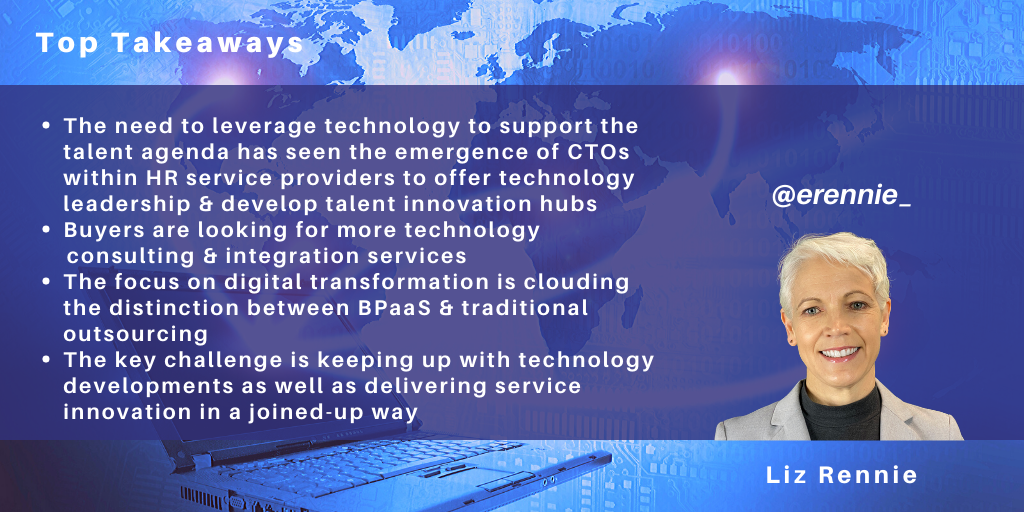
Having stepped back into an HR analyst role at NelsonHall, it’s clear to me that we can’t emphasise enough the increasing importance of talent and the need to leverage more technology in the HR function to be competitive. These two themes are unlikely to surprise. Over the last six months, I’ve heard how big companies such as large IT firms are experimenting with shrinking recruitment sourcing teams and building talent intelligence teams instead. How is this changing the shape of the HR ecosystem? And what’s next?
NelsonHall recognises four key components of the HR ecosystem. These relate to Talent Services, Talent Technology, HR Operational Technology, and HR Operational Services, with talent being at the core as the primary driver of organizational growth and competitiveness.
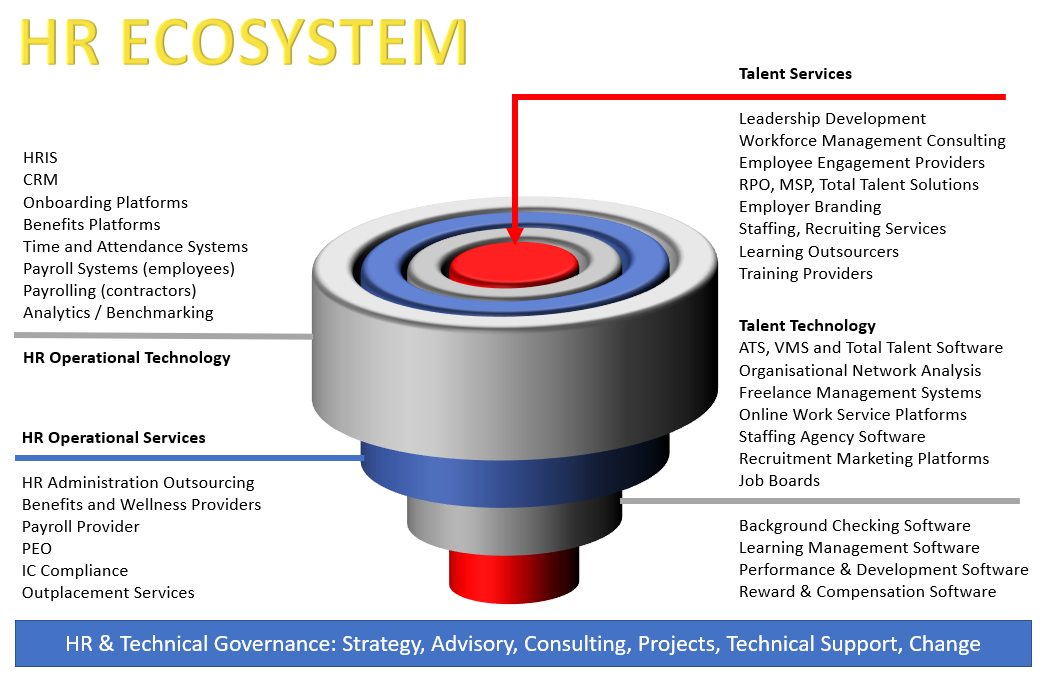
As we enter the new decade, the two most significant changes to the shape of the HR ecosystem are:
- The growing importance of Talent Services: Talent shortages mean that talent-related services are becoming more important to drive organizational competitiveness and growth. As a result, the services supporting talent have seen more focus on employer branding and building strong cultures
- Technology’s focus on experience: As the labor market tightens, employee experience becomes more relevant and employees become true consumers. All activities that impact the employee experience can have an impact on the bottom line. Onboarding, benefits, engagement, recognition, and even payroll, can play a part.
The technology-experience focus needs to be tempered with an acknowledgment that employee experience is also as much about human engagement and rapport building in a company. However, HR undoubtedly has an active part to play in ensuring smooth employee onboarding and ensuring employees feel appreciated through effective practices and leadership development.
As a result of the increasing importance that talent vendors and buy-side organizations are putting on building the best experience, new partnerships with employee engagement companies such as Qualtrics (example here) are forming. Further, we are seeing candidate experience and employee experience now firmly at the heart of many HR technology roadmaps. Leveraging social platforms that provide on-demand learning for employees and recruitment marketing and social media listening tools such as TalkWalker and Crystal Knows are also ways that companies are innovating to stay ahead of the competition for talent. As mobile-first and omni-channel processes are adopted through the latest HR technology releases, the HR operational function will accordingly also need to adapt. The HR functions themselves are at risk of being the weakest link.
What’s next? The convergence of marketplaces
Challenged to keep up with technology innovation in the marketplace, traditional HR service providers have placed greater emphasis over the last five years on technology innovation than service innovation. Technology and service providers are beginning to build stronger technology partnerships supported through API connectors and developing marketplaces for additional services. The market has also seen a significant number of senior CTO appointments announced as well as the set-up of technology innovation hubs by providers.
Buyers are similarly challenged to keep up with technology innovation to the extent that they are relying on their providers to deliver greater technology guidance across the wide array of solutions, demanding stronger technology consulting and integration services than before.
Further, traditional outsourcing providers are beginning to focus on digital outsourcing solutions that look at end-to-end processes and process efficiency to help clients knit together the different technologies and plug the technology gaps and work-arounds, clouding the distinction between BPaaS and traditional outsourcing.
Alongside these technical developments, it is worth noting that, as the employee value to an organization grows, the demand for high-quality service and, in some cases, a white glove HR service, for employees still lives on and is not expected to disappear. The challenge will be which service providers are adequately able to fulfill both the technology challenges and service innovation in a joined-up way? How many vendors still give attention to end-to-end service and not just the technology?
]]>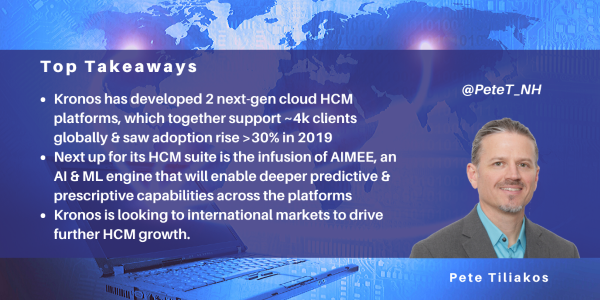
Earlier this month, Kronos held its annual client event, KronosWorks, in Las Vegas, drawing >3k attendees from around the globe.
Much of the attention at KronosWorks centered on the launch of InTouch DX, an intelligent time clock offering that incorporates advanced digital capabilities including an LCD with touch-enabled access, facial recognition, and integration with Kronos Workforce Dimensions for workforce management insights. However, many attendees were there to learn what Kronos has planned for its HCM platform offering.
If you are familiar with Kronos, you likely know their long history and body of work as a workforce management software provider. It offers an extensive time & attendance and scheduling capability that is not only leveraged by thousands of clients of all sizes and industries globally to address complex workforce management requirements, but the solution is also leveraged or resold by several leading HR services and technology providers as their "go-to" integrated, advanced WFM solution (e.g. SAP/SuccessFactors, ADP, etc.)
However, over the past three years, Kronos has also been quietly developing two cloud-based, next-generation HCM platform solutions that are now serving nearly 4k clients globally and have experienced a sizeable adoption increase of >30% in 2019 (a growth rate comparable to its HCM technology peers in the space, many of which focus exclusively on HCM and launched solutions several years prior).
Kronos HCM offering at a glance
Kronos' HCM offering includes two cloud-based platforms, both localized and targeted to organizations headquartered in nine countries: U.S., Canada, Mexico, U.K., France, Belgium, the Netherlands, Australia, and New Zealand. Together, the platforms now support >3m HCM users and an additional >35m users on its WFM solutions. The Kronos HCM platform offerings are:
- Workforce Ready: generally targeted to organizations with <5k employees, but with the capability to support organizations >5k
- Workforce Dimensions HCM: targeted to organizations with >5k employees; generally, those operating in industries with high populations of hourly workers or having a complex workforce management requirement (e.g. unions, global presence, etc. – which may also include organizations below 5k).
The two HCMs have aligning infrastructure and are built on the Kronos D5 cloud platform enabled by Google Cloud technology. Therefore, both platforms share essential functionality and capabilities (currently >90%) across their HCM modules.
A key element to the Workforce Dimensions platform, and where its capability differentiates from that of the Workforce Ready platform, is its complex workforce management and planning capabilities. Kronos also offers this as a standalone solution and is often adopted by users of both Kronos' HCM platforms, as well as integrated with other leading HCM solutions. Workforce Dimensions (WFM) is currently configured to support 17 languages. Additionally, the platform offers deeper functionality to support key requirements inherent to operating in industries such as healthcare, manufacturing, retail, staffing, distribution, government, banking, and education.
What’s new and next
Kronos continues to push hard on the advancement of its HCM offering, directing a sizable portion of its annual R&D spend toward its HCM platform development. In addition to advancing its HCM capability, Kronos is also investing in a significant marketing blitz aimed at shifting its brand awareness from that of a WFM technology provider to a provider of comprehensive, platform-based WFM and HCM technology solutions.
Central to the Kronos HCM roadmap and platforms’ future is the infusion of AIMEE, an artificial intelligence and machine learning engine that provides predictive and prescriptive guidance for employees and managers. AIMEE supports tasks and insights such as predicting employee "flight risk", identifying employee success potential, measuring employee fatigue, and supporting succession planning by analyzing employee trends.
At the event, Kronos launched a new Advanced People Analytics offering powered by AIMEE. The offering, which is available now for Kronos Workforce Ready and due in 2020 for Kronos Workforce Dimensions clients, provides access to three data science tools for decision-based actions:
- Insights Powered by AIMEE: enables strategic data views in planned areas such as absence management, flight risk, leaves, onboarding, performance, and recruiting
- Insights Explorer: a data exploration tool that simplifies the dissection of data from across the employee lifecycle, leveraging a descriptive analytics engine to “connect the dots” between engagement, performance, and productivity with multiple datasets
- Insights Dashboard: provides visualizations through Insights Explorer to provide leaders with a single view of critical people insights.
Moving ahead, Kronos is focused on enabling deeper user personalization and insights across both platforms’ suite of modules and will do this by expanding the use of AIMEE AI to address additional use cases and tasks with predictive and prescriptive guidance – as well as leveraging NLP technology and chatbot capability to address a wide set of everyday HR tasks.
Kronos plans the continued expansion and development of its vertical solutions to address use cases unique to buyers of key industries such as retail, manufacturing, and healthcare. It also plans to expand its native payroll capability beyond the U.S. and Australia (integrated through Payroll Metrics Australia) to include Canada in 2020.
Further, Kronos is committed to rapidly expanding its network of integrated partner solutions to address white spaces and extend the value of their platforms beyond HCM. Recent examples include PayActiv for on-demand payroll capability, Unum Group for leave management administration, and integrations with Cornerstone OnDemand's talent management solutions.
The outlook for Kronos’ HCM offering
With its HCM platforms currently supporting employees in ~85 countries (and quickly expanding), the company is looking to the U.K. and Australia (Australian Payroll is now available through a partnership with Payroll Metrics) as part of its international expansion plans to drive further HCM adoption, where it has a sizable WFM client presence and is already seeing strong HCM adoption in line with its U.S. growth trajectory. To support its international growth plans and help it scale, Kronos continues to rapidly expand its network of global implementation partners that can deploy its HCM platforms on its behalf.
The challenge for Kronos will be increasing its cloud HCM technology "at-bats" with potential buyers seeking to modernize their HR operating models. Kronos is betting on its media blitz to help address this issue, including targeted TV and radio ads, sponsoring professional golfers from the PGA and LPGA (some of which were at KronosWorks), and conducting field events and tradeshows, while also building out its advisory and broker alliances. Further, Kronos will also look to its base of >8k Workforce Central and other legacy WFM clients globally as potential converts to its broader HCM platform offering.
As Kronos heads into 2020, it brings with it strong momentum for its HCM platforms, which remain distinctly positioned in the space against competing HCM-centric peers, offering one of the only fully-integrated, vertically-enabled HCM and WFM solutions available from a single technology provider.
]]>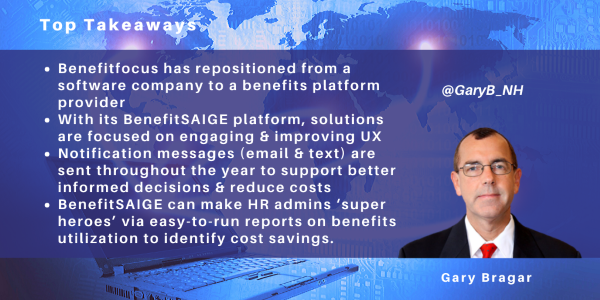
Last week I attended the Benefitfocus Seller Place 2020 conference. Benefitfocus has repositioned itself from a software company to a benefits platform provider with solutions focused on engaging and improving the user experience while helping employers and employees make more informed decisions and reduce cost.
Benefitfocus has 25m consumers, serving 150k employers with 15.5m employees, partners with 700 brokers, 144 medical carriers, 50 voluntary suppliers, and has 1,700 associates. The BenefitSAIGE platform processes 42m transactions per week, worth $18bn between BenefitFocus and its ~100 payroll partners with a 99.9% first pass yield. 100% of data is delivered on time during open enrollment and 100% of payroll and enrollment files/data transmitted is encrypted.
Why Benefits Engagement Matters
The importance of engaging employees with benefits for attraction and retention of talent cannot be underestimated. Benefitfocus presented data showing that there is a 19.3% employee turnover rate in the U.S. Employees are spending more on benefits than all other expenses except for home mortgages and car payments, yet they are getting less value. Since 2009, medical costs are up 54%, deductibles up 162%, while worker earnings are up just 20%, and 74% of employees are confused by their benefits options. In 2018, $3.65 trillion was spent in the U.S. on annual health costs, 20% of the GDP. Family costs have increased 2x faster than wages in the last decade, and 64% have delayed receiving care due to the costs involved.
BenefitSAIGE Platform Notifications
Benefitfocus has made significant investments in its BenefitsSAIGE platform, including the use of AI. BenefitSAIGE is event-driven: instead of benefits being an annual event, you can enroll and change benefits when you need to. BenefitSAIGE engages with participants throughout the year, including participants receiving a proactive notification when something changes. Every person who comes to the BenefitSAIGE platform receives push messages on a weekly basis that will help them to make informed decisions and save cost. A dedicated content manager helps to ensure compelling content is delivered throughout the year. A few examples of notifications are:
- If an employee gets married, they will receive a message (email or text) on the top 5 things newly married couples needs to do regarding benefits
- If an employee moves, their auto insurance may change, so BenefitSAIGE will notify the employee to review insurance products that the platform recommends
- Personal reminders such as ‘today is your core strength training day’ or ‘it’s time for your doctor’s appointment today’
- Cost-saving notifications such as ‘the prescription you just filled can be $3 cheaper at the CVS pharmacy near you’.
Examples of Benefits Achieved
The following are examples of the type of benefits that can be achieved using the BenefitSAIGE platform:
- Ability to make a company HR admin a super-hero! For example, in looking at medical claims and trying to get a handle on costs, with one click you can get the top 10 categories driving cost and the dollar amount spent on (say) cardiovascular, with the number of claims
- ER costs have risen dramatically in the last 10 years. As such, you can identify the types of claims and diagnosis appropriate for alternative care. An example was given of a Benefitfocus client with high ER costs that implemented telemedicine communication and realized a $50k saving with a potential of $400k over 2 years
- Ability to run a report on zero cost claimants that are never going to the doctor (even for preventative physicals) and deliver messages to inform them they are covered for no cost for preventative annual visits and/or incentivize them to open a Health Savings Account and then see the impact it has
- A midsize employer with a lot of non-compliant prescription diabetics created member populations to track strategy effectiveness and realized a 24% increase in medication compliance, getting employees the right medication, and increasing employee engagement
- A large employer who was seeing double-digit pharma cost increases y/y, analyzed data and found improper billing/fraud and was able to reduce y/y spend by ~10%
- Open enrollment daily insights to HR admins including number of log-ins, elections, comparison of plans selected vs. last year, number and types of questions asked; allowing HR admins to proactively communicate anything that needs to be clarified
- Individuals enrolling in benefits are given insights; for example, ‘We recommend 2019 HDHP Premier as your medical plan, which can save you $3,822 on premiums compared to the PPO standard plan’. It will then provide further information on Total Risk and Savings Opportunity.
2020 Roadmap
Benefitfocus’ planned enhancements for 2020 include:
- Integrated case management capability to allow employees and employers to have full access to case history
- Email notifications will incorporate employer branding, including client logo and email styles
- In Q1 2020, in addition to email, text notifications will be made on mobile devices
- Increasing the number of broker partners from 700 to 1,000.
Outlook
Benefitfocus’ emphasis on using its BenefitSAIGE platform to provide proactive communication throughout the year gives it a unique position as a benefits partner in helping employers, employees, brokers and carriers to make more informed decisions, reduce company and employee costs, and improve engagement.
In terms of challenges, Benefitfocus needs to ensure that its notifications continue to add value and not lead to communication overload. But that can be overcome if the messages are short and succinct and help to make better decisions while saving money. Also, while there is merit in being a premier platform provider, Benefitfocus should let it be known that they are still a service provider with a Benefits Center and specialists able to answer questions on the phone when needed.
NelsonHall expects to see double-digit growth in Benefitfocus products bought and revenue generated in 2020.
]]>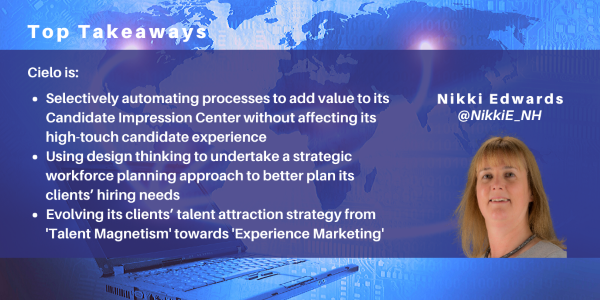
The pace of change in RPO and contingent worker outsourcing has been unprecedented in recent years due to technological advancements and the range of services expected by buyside organizations. Cielo recently organized a customer and analyst day to explore what talent acquisition (TA) might look like in the next five years.
Speaking with several of Cielo’s clients, they comment on Cielo’s enthusiasm to question the status quo and ask how things can be done better, and on its keenness to continuously improve and be future-fit while maintaining its core values.
Automation must complement high-touch service
Clients cite Cielo’s “WE BECOME YOU” mantra as a feature of its RPO service. They value the Candidate Impression Center and Bridge pre-employment service, established in 2010 to address pain points in the recruitment process (such as a lack of contact with candidates once they have applied for a job, and post-job offer before the employment start date). Given the current focus on candidate experience, remaining high-touch is key. With Cielo’s Candidate Impression Center, a chatbot now provides a response to the top 100 FAQs to save agents’ time, with humans doing more meaningful and highly personalized candidate-care work.
The RPO journey is becoming a Total Talent expedition
Cielo aims to adopt a partnership approach with clients, taking them on a journey of improving both efficiency and effectiveness in their recruitment processes. Enhancements to the service have included SkyRecruit, reporting and analytics (SkyAnalytics), Employer Branding (EB), and most recently consultancy services in areas such as TA strategy, tech advisory, marketing, and diversity and inclusion. The shortage of talent in many skills areas has spurred Cielo to look at alternative sources of talent such as contingent workers and developing existing employees to plug supply gaps, taking more of a total talent acquisition (TTA) approach.
Cielo is now taking the partnership approach to the next level with its Client Success Program. Using Cielo’s Talent Acquisition Maturity Model, clients are presented with a scorecard to determine their position on the RPO/Total Talent journey at various points through the relationship. Using design thinking, Cielo undertakes a more strategic workforce planning (SWP) approach to better plan its clients’ hiring needs to help them improve their talent acquisition maturity.
Next-generation delivery – “Certified to Serve”
Cielo posits that delivery excellence requires more than expertise in sourcing talent and industry sector knowledge. In its “Certified to Serve” initiative, Cielo’s talent advisers are required to be knowledgeable in hiring process definitions, operating principles, talent options, payrolling/invoicing, plus information specific to the client. Those with more advanced skills can advise on SWP.
Enabled by technology or driven by technology… a matter of preference
Cielo has seen early traction with its more automated High Volume RPO (HVRPO) platform launched in 2018. Several clients are using HVRPO in conjunction with Cielo’s SkyRecruit platform, typically hiring in high volume for niche/specialized roles. Examples include:
- A pharma that has made 4,000 hires through the HVRPO platform and has seen an 11% decrease in time to accept an offer
- A food service company that has made 5,000 hires and saved 1.5 hours of hiring manager’s recruitment time per hire through tech-enabled screening.
While at present Cielo’s clients mainly leverage recruitment technology as an enabler with limited automation (confined to processes that are already successfully automated in the wider market, such as website apply, interview scheduling, etc.), Cielo anticipates that in future more of its clients will leverage Cielo’s HVRPO platform (with programmatic advertising, mobile apply and assessments, automated matching, interview scheduling, and offers/onboarding) to drive the hiring process.
The “Experience Marketing” experience
Successful hiring requires a talent attraction strategy (making use of EB services) along with candidate sourcing. Cielo’s clients have embraced what Cielo calls Talent Magnetism (recognizing the importance of websites, campaigns, social media, and EVP in the TA process). The next phase is Experience Marketing (focused on EB and communications), which tailors marketing and communications to the stakeholder (the client, hiring manager, candidate, and employee team member).
What’s next?
Cielo has reimagined and redefined its RPO offering, but what will be next? With the global skills shortage worsening, the blurring of the lines between permanent and contingent hiring to secure talent to deliver a business outcome may no longer be enough. It is already apparent, with the accelerating sophistication of technology/tools, that the current workforce is not sufficiently digitally capable to embrace the tech-driven workplace of the future.
If the required talent cannot be bought or borrowed, then it will need to be built. Organizations have the choice to seek expert help from both recruitment and learning outsourcing vendors, but as seen with TTA, why would you leverage multiple providers to source talent when one provider could be more efficient, effective and cheaper (especially when the available talent plays in both pools)? Savvy RPO, MSP and TTA vendors could become Talent Management experts, blurring the lines between talent acquisition and talent development. Cielo aims to become a “Talent Outcomes and Talent Experience” company. Does that mean it will further reimagine and redefine its portfolio and become a Talent Management vendor?
]]>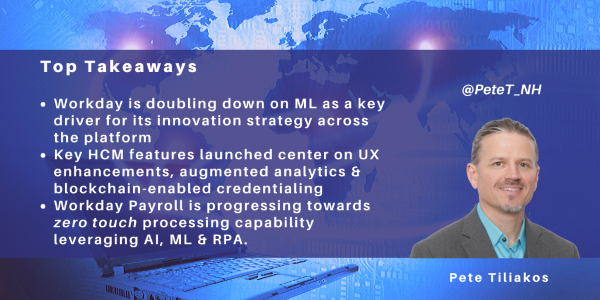
This past week Workday held its 13th Workday Rising client event in Orlando, Florida. The platform’s annual event continues to grow substantially, with more than 13k in attendance this year, up from ~10k attendees in Las Vegas at the 2018 event.
The growth in attendance points squarely to the continued steady adoption of the Workday platform, which is now supporting >2.8k HCM and >700 Finance adopters, and 40m users globally across a client base represented by 40% of the Fortune 500 and 50% of the Fortune 50, with 70% of its clients live and operating at a 97% CSAT rating. Recent newly live client examples include Lowes, Quicken Loans, and Renault.
This year, Workday extended its innovation keynote to 120 minutes to accommodate the depth of new features being launched across HCM, Finance, and Planning. Workday introduced multiple new HCM features, each geared toward supporting businesses and their workers in navigating the changing shape of HR and supporting the future of work. Central to Workday’s roadmap and future is the infusion of machine learning (ML) across the platform to augment users, personalize their experience, automate tasks, and deliver deeper insights in context and in the flow of work.
New HCM key features
Workday People Experience (March 2020): a new user interface which leverages ML to enable highly personalized support for the user’s unique journey, designed to enable employees to conduct day-to-day HR activities without needing to know exactly where to go in the platform to complete a specific task.
The new Workday People Experience includes the Workday Assistant, an NLP-enabled personal assistant, and is integrated with leading collaboration tools like Slack and Microsoft Teams to support employees “where they work”. Additionally, Workday introduced a new case management and knowledge management tool, enabled with a case solver capability to support timely case management, resolution, and issue prevention.
Workday People Analytics (available for subscription in 2020): an AI and ML-enabled augmented HCM analytic offering designed with predefined business metrics and KPIs set around key workforce trends and topics delivered through a story view (a capability enabled by Stories.bi which Workday acquired in 2018). Additionally, Workday has also enabled Discovery Boards, its drag-and-drop data discovery capability for all HCM clients as part of their standard subscription.
Skills Insights & Talent Marketplace: leveraging its previously launched ML-enabled Skills Cloud (>200 client adopters and taxonomy of >200k skills), Workday introduced two key talent management capabilities. First, Skills Insights, which enables HR to assess existing skills and identify skill gaps within the organization through real-time insights; plus a new Talent Marketplace, which provides a platform for talent mobility, enabling workers to match their skills to roles, projects, and gigs, as well as being identified for opportunities where their skills are a fit.
Workday Credentials: a blockchain-enabled credentialing technology that is designed to address the historically manual and time-consuming process associated with verifying employee credentials (e.g. work experience, education, certifications, etc.). Further, Workday introduced the WayTo mobile application, which empowers users with capability to manage and share their verified professional credentials as and when desired throughout the application and screening process.
WFM & Payroll Updates
Although much of the product news centered on UX, talent management, and analytics, Workday highlighted multiple key features shaping its next generation workforce management (WFM) capabilities, all designed to drive greater user efficiency and effectiveness by leveraging automation, AI, and ML.
Most notable was Workday’s demonstration of the progress it has made towards its “zero touch” payroll capability, which was met with highly positive approval from the payroll practitioners in attendance. The solution pairs a continuous gross-to-net calculation engine (which processes payroll results 24x7) with Smart Payroll and Smart Retro processing capability which automatically processes retroactive actions and only processes payroll for workers with payroll impacting changes. Smart Audit rounds out the capability to compare payroll results and surface exceptions for review automatically.
Workday expects to expand on its payroll capability with Instant Pay (2020) which provides an on-demand payroll capability allowing workers to request payment incrementally for hours worked and approved. Additionally, Workday demonstrated a new RPA capability (2020) enabled through partner integration with Automation Anywhere, which is aimed at reducing the historically manual efforts for key payroll inputs; initial use cases including payroll input automation and stock administration automation are both due in 2020.
Looking ahead
Clients I spoke to throughout the week (varying sizes and industries, many of which have been operating on the platform for a few years) indicated high satisfaction and value realization overall. I noticed this year there were many more full-suite adopters with both HCM and Finance in place, some of which were deploying, or at least considering adding, Planning to the mix in the near term. Those without full-suite adoption expected to expand their use to include more HCM, most commonly on the talent management side, but also some considering adding payroll where it has been left to an outsourcing provider and not yet on the platform.
Not surprising was the fact that many Workday clients I spoke to still haven’t solved (or even begun addressing) global payroll yet, a clear opportunity for Workday’s global payroll partners which I noticed maintained highly active booths all week, as this issue is clearly front of mind for many cloud HCM adopters.
However, maintaining its rapid platform adoption and historically strong revenue growth ($2.82b, +31.7% y/y for FY’19) is now the challenge for Workday which is driving towards a target of $3.59b in total revenues in FY’20. To maintain its strong adoption and growth results, Workday continues to invest heavily in platform features and innovations, dedicating ~30% of revenues annually to R&D compared to ~15% on average by its legacy and peer cloud competitors.
Workday leadership emphasized its commitment to “doubling down” on ML as the game changing technology it expects to drive its platform innovation, client value, and platform adoption in the future, innovation that will enable value for users by addressing the key HCM and business challenges organizations face today. While Workday and its peers are pushing out advanced capabilities faster than ever, the challenge now will be in helping clients keep pace with the level of change, digesting and adopting practices that put these advanced capabilities to use.
]]>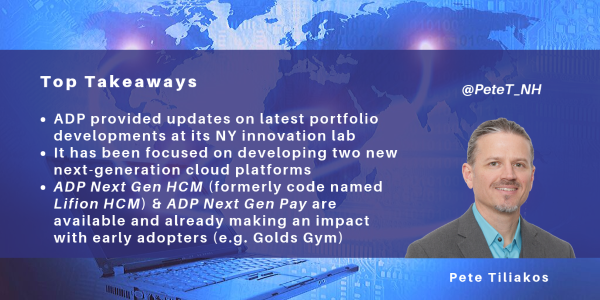
This past week ADP held its annual analyst day event at its innovation lab in Chelsea, NY, where its executive leadership provided updates on the progress of its latest portfolio of next-generation HR and payroll solutions. The event was noticeably more crowded than in previous years, not only from a strong analyst community turnout but also from the growing ADP product leadership team, which is indicative of its focus and commitment to developing next-generation technology products.
Commitment to HR technology & innovation
If you weren’t already aware, ADP is serious about becoming an HR technology company, and to that end has quietly made significant investments in advancing its cloud HR and payroll platform capabilities in recent years. According to their FY 2018 annual report, it allocated $1bn (up from $863m in FY17) toward systems development, maintenance, and purchases of new software and software licenses.
Its commitment to technology and innovation was further emphasized earlier this year when ADP launched a new branding campaign, introducing a new tagline and mantra of “always designing for people”, underscoring its focus on designing solutions that enable a “better way of working” to support organizations and their human capital to reach their full potential.
Recent investments aside, ADP has a legacy of innovation in the HR space, from inventing payroll outsourcing, and delivering the first payroll automation, to the introduction of the first mobile HCM app (ADP Mobile), and the first app marketplace (ADP Marketplace). Looking toward the future, CEO Carlos Rodriquez emphasized that ADP is "all-in on HCM, and on becoming a technology company".
Over the past three years, ADP has been developing two new "next-generation" cloud platforms: a highly extensible, AI/ML and predictive analytic embedded HCM platform called ADP Next Gen HCM which has been purpose-built for the dynamic team structures rapidly evolving in workplace today, and a new policy-based, event-driven payroll engine which is capable of supporting both traditional employees and freelance gig workers.
ADP has made substantial progress bringing both platforms to life and has been piloting each over the past year, and is now live with a select group of early adopters like Golds Gym which just went live on ADP Next Gen HCM this past month. ADP reached its goal of 15-25 North American-based clients live on Lifion by the end of FY’19 (July), with plans to reach as many as 75 in FY’20. Further, it expects its next-generation payroll engine to be supporting a “few hundred” clients by the end of FY'20.
Driving adoption
With its next-generation platforms now in place and ready for primetime, ADP’s challenge will be driving adoption for its new HCM technology. Its first challenge will be targeting and convincing new clients to consider ADP Next Gen HCM over other well-known HCM platforms in the marketplace. Further, it has the mammoth task of convincing its ~810k existing clients to consider migrating to ADP Next Gen HCM as well.
However, as it continues to add early adopters and enable transformational outcomes that drive referenceable clients, adoption should follow; at the event, ADP announced it had already signed a new ADP Next Gen HCM client (its largest to date) for a North American transportation company with ~65k employees.
ADP is also leaning on the design of ADP Next Gen HCM to differentiate the platform and drive adoption; first, with what ADP calls “extreme personalization” enabled through an “AI anywhere” approach leveraging AI/ML and NLP, and underpinned by the depth of the ADP Data Cloud, for a prescriptive and predictive user experience throughout the platform. Next, ADP plans to enable clients to comingle external business data with HCM data for deriving holistic workforce analytic insights.
To personalize the experience further, ADP is betting on "mini-apps" enabled through its flexible, low-code architecture and design. ADP has empowered clients to build apps and tools to expand their capabilities to fit their unique needs and HR environment. ADP demonstrated the ease of configuration for its mini-apps, which incorporates a drag-and-drop style experience. ADP currently has ~115 mini-apps in production and growing rapidly, with plans to expand this to third-parties longer term.
While ADP has been keenly focused on advancing its platform technology in recent years, its HR and payroll services remain at the heart of its offering and brand, and will need to play a significant role in driving adoption for its new platforms. I expect adoption for ADP Next Gen HCM to initially be driven from new HR services clients seeking both modern next-generation technology as well as a managed services engagement.
With a comprehensive HR services portfolio that spans the entire employee lifecycle and can support clients through a single vendor solution, enabled by next-generation platforms and paired with one of the deepest and most robust sets of human capital management data in the world, ADP is poised to gain momentum with HCM technology buyers, and I expect will likely exceed its adoption goals in FY’20.
]]>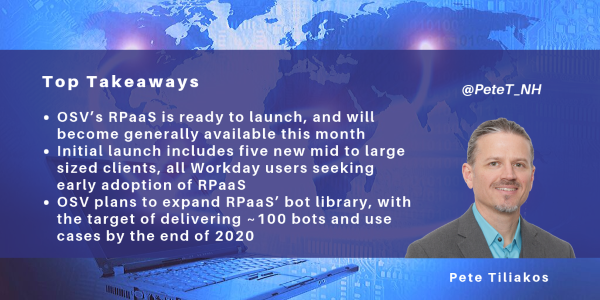
Last October at Workday Rising in Las Vegas, OneSource Virtual (OSV) introduced RPaaS, a Robotic Process as a Service offering, and the first HR-focused robotic process automation as a service solution targeted toward the mid-market buyer.
RPaaS is a 'turnkey RPA solution’ that eliminates the need for adopters to make substantial investments in developing advanced automation capabilities, making the emerging capability more affordable and accessible to midsized organizations seeking to leverage the technology to enable digital HR transformation. (For more background on RPaaS, see my blog dated November 2018: 'OneSource Virtual Delivers Turnkey RPA with RPaaS.com’)
With Workday Rising 2019 weeks away, and marking the first anniversary of RPaaS' introduction, I checked in with OneSource Virtual’s executive leadership to see how the offering has progressed so far, and its roadmap and future plans moving ahead.
RPaaS progress
In June, OSV announced it had finalized its selection of an automation platform for RPaaS, engaging Automation Anywhere as its go-to-market partner for RPaaS.
Since its launch last year, OSV has been quietly piloting the RPaaS original library of bots to support HR use cases for payroll data validation, timekeeping, life event monitoring, and 1099 data scrubbing. Over a multi-week timeframe, four early RPaaS adopters from OSV’s client advisory board piloted the bot capabilities.
With the success of the initial pilot and increasing demand from both its existing client base and prospective buyers, OSV released a soft launch of RPaaS for general availability beginning September 1st, with a more formal launch to occur by the end of September.
The initial launch will include five clients for RPaaS, all Workday adopters, derived from a mix of middle and large market organizations, and all new client labels for OSV. The initial five clients will begin working with OSV later in September to roll out the bot library against select use cases for operation by their internal HR team.
The future for RPaaS
OSV is also planning to roll out the RPaaS capability for use within its own delivery model, in support of its existing clients. It will work with clients to opt-in (requires security access for bots to client Workday instances, similar to that of a traditional back-office resource), and begin rolling out the capability by the end of October to client adopters.
OSV will also begin rolling out bots in support of its managed garnishment services offering, an inherently high-touch, complex, and compliance-impacting process. The bots, combined with optical character recognition (OCR) and machine learning, will scan and extract garnishment order details for processing. OSV will begin using the capability with ~10 clients by October, with plans to roll out the capability against all managed garnishments clients’ longer term.
From a roadmap perspective, OSV will continue to develop its RPaaS capability, aiming to address key repetitive HR and payroll tasks and inquiries through automation. OSV plans to expand its bot library, with the target of delivering ~100 bots and use cases by the end of 2020.
RPaaS’ next wave of use cases will center on automating repeatable HR and payroll audits to eliminate rework, drive compliance, and allow practitioners more time to focus on value-added tasks.
OSV envisions enabling RPaaS with 'digital workers', which leverage a group of 5 to 8 task bots that can be aligned to a specific set of activities commonly managed by humans. Examples include a 'payroll digital worker’, focused on automating repeatable activities throughout the payroll process, including pre-processing, gross to net processing, and post-processing reports, audits, and validations. OSV is also targeting enabling a 'HR compliance auditor' to automate auditing the full employee lifecycle of activities that can trigger compliance-related risk. Longer-term, OSV sees an opportunity to enable deeper automation for repetitive activities associated with benefits and recruiting administration.
Looking ahead, the success of RPaaS not only can provide OSV with a new revenue stream; it also has the potential to enable a pipeline of potential managed services buyers. By engaging an organization with a standalone offering such as RPaaS, OSV can expand the relationship longer term to include a range of managed HR, finance, and Workday support services, as the client grows, or its needs shift.
Longer term, OSV may have an opportunity to further its RPaaS reach and brand recognition by enabling the solution for potential consumption through the application marketplaces of its key partners such as Workday and Automation Anywhere.
The challenge for OSV lies in navigating the inherent difficulties associated with launching and commoditizing next-generation solutions like RPaaS as an early entrant. However, given OSV's history of disruption in the HR services space, I expect RPaaS will be a success and should provide OSV with deep expertise it could leverage longer term to establish a consulting practice and offering aimed at helping organizations navigate and establish digital HR centers of expertise.
OSV is already seeing increasing interest in the offering from both existing clients and external Workday buyers seeking to leverage intelligent automation within their HR delivery models. I expect OSV will see its RPaaS adoption steadily escalate in the coming 12-18 months, driven by organizations continuing to invest in digital transformation enablers.
]]>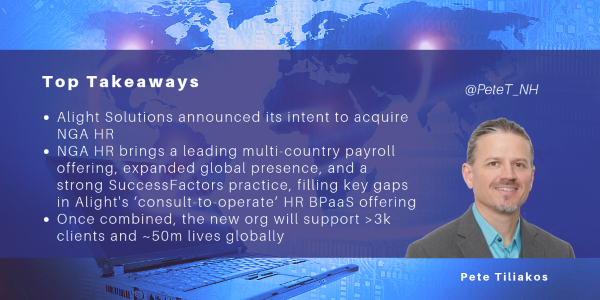
This past week the payroll services market experienced yet another consolidation of major vendors, with Alight Solutions (‘Alight’) announcing its intent to acquire multi-country payroll specialist NGA HR.
Although the deal terms were not disclosed, once approved (expected by Q4, possibly Q1 2020 at the latest), the acquisition will bring together two leading HR BPaaS providers with highly complementary capabilities and footprints. Once combined, the new Alight organization will have around 14.5k employees, and provide a range of health, wealth, and HR services to >3k clients and ~50m lives globally.
NGA’s impact on Alight’s HR services offering
Currently, Alight has a comprehensive HR services capability, supporting clients with consulting, deployment, and ongoing support for HR platforms and services, including a managed payroll services offering which processes >24m checks annually.
Alight's payroll services experience dates back to 2004 when it entered the multi-process HR outsourcing space through its acquisition of Exult. Since then, Alight has developed deep expertise in delivering payroll administration services to large, complex organizations leveraging leading HCM platforms, including Workday, SAP, and PeopleSoft. But its payroll capability has geographically focused on North America and the U.K. and it has lacked multi-country payroll capability.
With NGA HR, Alight will gain major multi-country capability, expanding its presence and delivery capability, particularly in Europe and Asia Pacific, and notably in Latin America where Alight lacks a local delivery center. Additionally, NGA HR brings its euHReka and hrX platform technology.
While the crown jewel from the NGA HR acquisition is certainly its global payroll capability, it also brings to Alight a very complementary HR BPaaS offering, with an aligning consult-to-operate model designed around major cloud HCM platforms including Workday and SuccessFactors.
While both organizations currently maintain partnerships and support clients on these cloud platforms, Alight’s expertise and client base has slanted heavily toward Workday. Alight has a partnership with SAP SuccessFactors, but has historically not taken on deployments of the HCM platform, choosing to focus only on post-deployment services instead.
Conversely, NGA HR brings to Alight experience in deploying and operating on the SuccessFactors platform. NGA HR is also a partner with Workday and supports several clients on the platform, but does not currently take on Workday deployments.
A win-win for both organizations
In NGA HR, Alight fills some key capability gaps, gaining very extensive multi-county payroll capability, expanding its global footprint and presence, and further enhancing its cloud HCM consulting and deployment practice.
With the addition of NGA HR’s SuccessFactors practice, Alight will be able to target and support a much wider set of cloud HCM buyers seeking broader HR transformation, and offer multi-national organizations a truly end-to-end HR BPaaS solution that can support a multi-country payroll spanning 188 countries.
The acquisition likely helps the case for Alight’s eventual IPO, which its owner Blackstone announced it would pursue in late 2018, but placed on hold in March of this year. Although the timeline for revisiting an IPO has not been disclosed, we expect the addition of NGA HR will only serve to boost Alight’s long-term value, particularly once the organizations have fully integrated and are leveraging their combined capabilities.
While Alight is gaining a solid capability boost, NGA HR may be the bigger winner in the deal. As part of Alight, NGA HR will be finally breaking away from over ten years of private equity ownership, gaining a parent company that operates in and understands the HR technology and services industry, and that will invest in and cultivate its capabilities for the long term.
Once the deal is confirmed, the challenge of integrating the two organizations will begin. Both sides are M&A veterans in this space, having navigated mergers and acquisitions multiple times throughout their histories. This, combined with the highly complementary nature of each provider’s portfolio of services and existing footprints, should enable a successful transition.
While the two organizations will operate as separate brands for the foreseeable future, re-branding for NGA HR is likely in the longer term, though with a strong brand recognition in key regions such as Europe, it’s more likely we will see a co-branded offering longer term.
Overall, this is a win-win acquisition for both organizations, and combined, Alight and NGA HR create a very competitive, globally capable HR BPaaS offering for companies seeking digital HR transformation through a single vendor solution.
]]>
I recently attended Korn Ferry’s RPO Client Advisory Forum, which was all about talent management. The theme was ‘unplugged’ and featured frank discussions about the RPO industry, including the challenges faced by the clients and service providers who attended from every region.
Beyond RPO, Korn Ferry offers many complementary talent management services, including those from its Organizational Consulting practice. One of the emerging talent trends of 2019 presented by Byrne Mulrooney, CEO, Korn Ferry RPO, Professional Search and Products, is rethinking performance management, and here, discussion topics included: engaging talent to create solutions that transform, helping people to see brilliantly, and building value through people.
Korn Ferry’s goal is to be the preeminent organizational consultancy, specifically regarding talent and the importance of articulating the right relationships.
Partnering with Qualtrics
As a step towards its goal, Korn Ferry and Qualtrics partnered earlier this year to build a global delivery and advisory service to improve employee experience. The partnership combines Korn Ferry’s Organizational Consulting services with Qualtrics’ Experience Management (XM) platform, to be applied throughout the employee lifecycle.
By joining the Qualtrics Partner Network (QPN), Korn Ferry is going to market by combining its organizational methodologies and expertise with Qualtrics’ XM platform to provide organizations with the expertise and technology they need to achieve breakthrough results at every stage of the employee lifecycle.
Korn Ferry has standardized on Qualtrics as its technology platform and will become a global strategic consulting partner for Qualtrics, providing end-to-end delivery and advisory services for clients globally. Through the QPN, Korn Ferry will also offer consulting and advisory services to Qualtrics EmployeeXM customers in more than 50 countries globally.
The partnership will enable Korn Ferry to go to market with offerings that include its platform, employee engagement and culture surveys, 360-degree reviews, and social listening tools, to enable employers to better manage talent and the associated talent management systems.
Impact for RPO buyers
Per NelsonHall’s recent RPO market analysis, including interviews with end-user buyside clients, one of the top drivers for outsourcing recruitment today is to gain better access to expertise, insights, technologies and tools. This is an area Korn Ferry has excelled in according to client satisfaction data. Recent interviews with Korn Ferry clients conducted by NelsonHall revealed high client satisfaction scores for their partnership capabilities in particular. And, having now attended three events with Korn Ferry RPO providers and buyers, my observation is that Korn Ferry does have a very strong relationship with its clients.
In terms of what will be driving buyers to outsource recruitment in the future, the research indicates that this will include requirements for talent management services that are complementary to RPO, such as internal development of existing employees through upskilling and reskilling.
]]>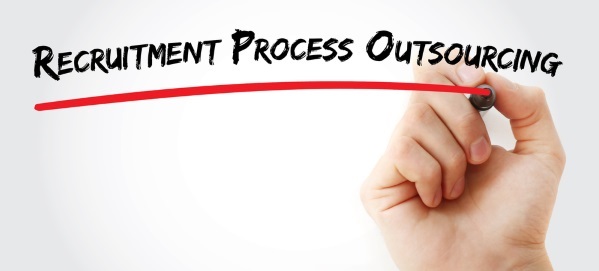
Last week I attended PeopleScout’s annual client NEXT Talent Summit 2019. In the keynote address, President Taryn Owen noted that this event marked one year since its acquisition of TMP to strengthen its global RPO and talent advisory capabilities. TMP, which operated in the U.K. under the brand name TMP Worldwide, provides employer branding, recruitment marketing, and RPO services through its Yocto brand. The acquisition expanded PeopleScout’s global RPO capabilities and EMEA client base, and its London office became PeopleScout’s EMEA headquarters. TMP expanded PeopleScout’s talent advisory offering by adding services such as employer branding, recruitment marketing, assessment services and talent acquisition strategy.
PeopleScout has also been growing organically, adding over 45 RPO contracts in 2018, and now has over 215 RPO clients with over 300k annual hires. In addition, there were around two dozen contract extensions. PeopleScout continues to be the largest RPO provider in terms of revenues in North America and they have continued to grow globally, across EMEA, APAC and LATAM. Half of PeopleScout’s employees are now based outside of the U.S.
Taryn Owen stated that a major priority for PeopleScout is its Affinix technology to enable a better user experience for candidates. Affinix is built on Amazon Web Services (AWS) cloud infrastructure, integrates with all ATS and VMS systems, and has a single sign-on. Its capabilities include:
- Digital and social recruiting, including the creation of job ads, job descriptions and career portals
- Artificial intelligence, including for immediate sourcing of passive and active candidates when a job requisition is opened
- ‘Mobile first’ platform for both the candidate and the hiring manager throughout the application, scheduling and screening process
- Video interviews and digital assessments to reduce time to hire using data analytics and machine learning to identify and rank the best candidates to communicate with hiring managers faster
- Predictive analytics and machine learning throughout the hiring process to better understand top talent behaviors and predict factors such as cultural fit, willingness to change companies, and future tenure potential.
One of the presentations by Andrew Wilkinson, PeopleScout’s Group Managing Director of Europe and APAC, was on creating a compelling brand experience across the employer lifecycle. Per NelsonHall’s RPO Market Analysis published last week, employer branding has elevated in importance as the global talent shortage has worsened. And in recent interviews with PeopleScout RPO clients, this was seen as an area where PeopleScout is excelling, as these two examples indicate:
- For a U.K. grocery chain, PeopleScout created a campaign featuring videos of a diverse group of people sharing stories about managers who inspired them. The video was viewed 484k times with positive feedback, resulting in exceeding the client’s goal of hiring 3k people for a new type of role
- For Virgin Media, PeopleScout focused on increasing employee referrals, updating its referrals website to elevate employer branding, and helped to communicate the Employee Value Proposition to current employees so they could identify the kind of people Virgin Media wants to hire. Within one year, referrals increased external hiring by 10% to 25%, employee participation increased to 40%, quality of hires increased, and Virgin Media saved $9k per hire on average.
Having attended these events four years in a row, I’ve observed that PeopleScout has a very strong and collaborative relationship with its clients, reinforced by achieving high customer satisfaction marks for quality of partnership in our most recent RPO NEAT vendor evaluation.
]]>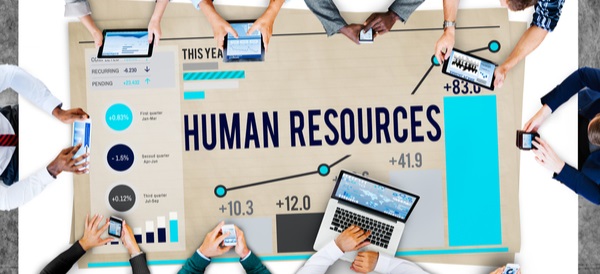
This past week I had the opportunity to attend a private event hosted by Safeguard Global at Crewe Hall in the U.K., where the company celebrated its continued success in the global payroll space and made a major announcement that aims to fuel the company’s continued growth and support its vision for enabling simplified, compliant global expansion for multinational businesses.
Safeguard announced it has secured funding from private equity partners Accel-KKR (AKKR) which invests and manages a portfolio of innovative mid-market software and tech-enabled services companies. The investment is for a minority stake in Safeguard Global and will provide Safeguard with the funding and support needed to fuel investments in its platform and expanding capability to drive future growth.
With this new funding, Safeguard has acquired Workfor, a Pan-European based provider of technology-enabled human capital management services, including employer of record solutions (EOR) and managed payroll capability.
Background to the acquisition
The two companies are no strangers to each other, having partnered since 2013, with Workfor supporting Safeguard as an in-country partner for its Global Employment Outsourcing (GEO) offering through Workfor’s EOR solution.
Workfor brings a portfolio of technology enabled HR services that is specifically designed around country domain experience for both local payroll and the employer of record model. Their regional footprint enables them to provide pay and expansion solutions, including managing registration, payment, and compliance in eight European countries where it has a local presence.
It also brings to the table a proprietary platform technology called AdminMe. The AdminMe platform is a SaaS solution capable of supporting payroll, employer of record, and time for all of the regions they support. A key capability for the platform is native gross to net payroll engine functionally for five of the eight countries it operates in, with plans to expand this to more countries in the coming 12-24 months, with France due later this year. Additionally, through the AdminMe platform, Safeguard also gains time and attendance functionality – a capability that other global employer of record providers currently lack as part of their payroll technology solutions.
Last, and possibly most impactful in the short term, Workfor brings with it valuable in-country presence, with ten offices in eight major EMEA countries: Switzerland, France, Spain, Portugal, Moldova, Greece, Italy, and Romania.
What this means for Safeguard
The investment by AKKR is a vote of confidence for Safeguard, its leadership, and the solution it has brought to market. During his speech to the Safeguard team, CEO and founder Bjorn Reynolds cited Safeguard’s legacy of innovation and disruption in the global payroll space, stating “…the next phase of Safeguard Global is going to be ambitious…”. The investment gives Safeguard the resources to double down on advancing its technology and building out its highly successful GEO capabilities and delivery model.
The AKKR investment also comes with leadership and guidance (including board representation) from a PE firm that is no stranger to the HR services and technology market, with a history of investing and owning similar firms. This brings both an outside advisory perspective on the industry, but also the potential opportunity to partner with these providers in the longer term.
While Workfor’s EOR installed client base is similar in size to Safeguard’s (with some overlap due to the partnership), the acquisition is by no means a simple ‘fold-in’ to boost client numbers or market share. The addition of Workfor’s EOR capabilities immediately compliments and expands Safeguard’s existing GEO offering to include candidate sourcing and time and attendance to provide a holistic, turnkey compliance model for enabling agile global expansion.
The addition of AdminMe to the portfolio is possibly the big win here for Safeguard, which gains platform capability that compliments its own Unity platform, adding gross to net payroll capability in select countries, but also a strong time and attendance capability that Safeguard can now incorporate into its offering. While the platforms are currently connected, the first challenge will be fully integrating these two solutions to maximize their capability. Safeguard also plans to build out the AdminMe capabilities through continued investments.
The expanded in-country presence and resources in several major EMEA countries is also a nice add for Safeguard. By gaining these in-country resources, Safeguard can reduce its dependence on third-party ICPs within its payroll delivery model, increasing its control over its payroll processing in these countries, which can increase its speed of delivery, reduce its operating costs, and improve its margins as a result.
Lastly, Safeguard gains the ability to create more flexibility in its offering, and engage a wider range of buyers, by being able to engage them with point services and solutions vs. an all-in managed services arrangement. This could include standalone services, and the potential to license its platform for use by clients in-house.
Overall, I like this move by Safeguard, as I think it complements them well and creates plenty of new opportunities to grow and build on the momentum of its GEO offering. It also comes at a perfect time – NelsonHall’s recently published Next Generation Payroll Services report finds that a key trend driving global payroll outsourcing adoption is that managing payroll compliance is more complex than ever, and more commonly organizations of all sizes are being pulled in to new international markets, creating significant risk if not executed properly and within compliance. The ability to tap into a turnkey HR solution for global expansion is very compelling when you consider the alternatives.
Safeguard has enjoyed rapid growth and adoption for GEO to date. However, the solution and even the concept is still somewhat overlooked by uninformed buyers. While I expect this strong adoption to continue given the current state of the market and the results GEO is delivering, Safeguard could benefit from more aggressive marketing of the GEO solution to inform the market of its successes and potential. As one of only a handful of vendors offering this capability, and solid investments to support its roadmap, Safeguard is well positioned for growth.
(For a deeper dive on Safeguard’s GEO model see: SGWI’s GEO Employment Model: Enabling Agile Global Expansion (May, 2018).
]]>